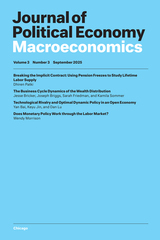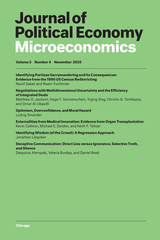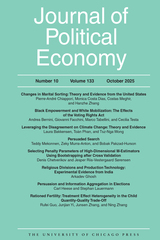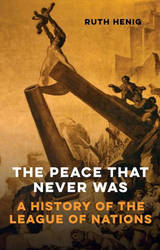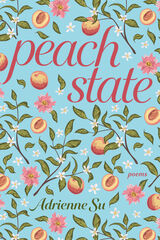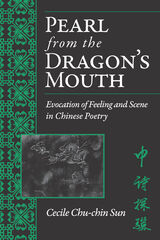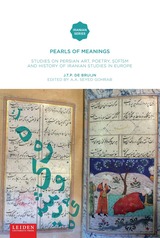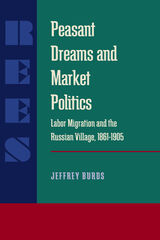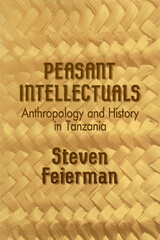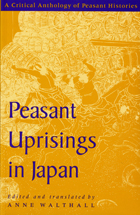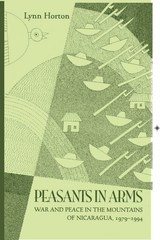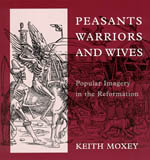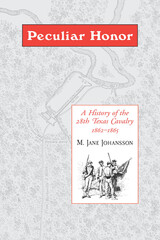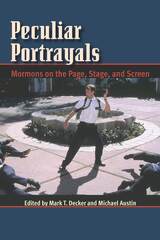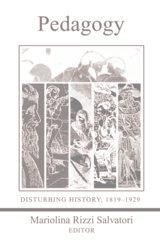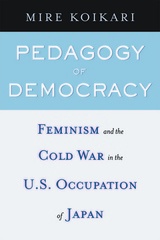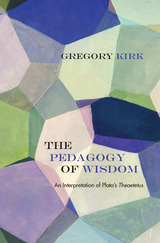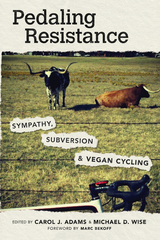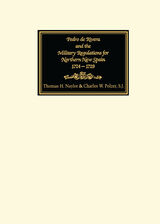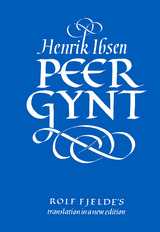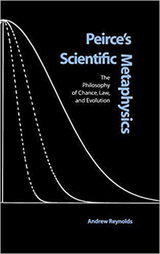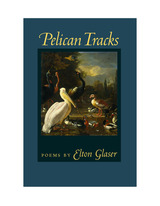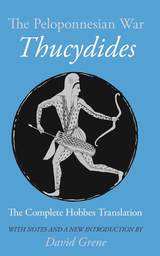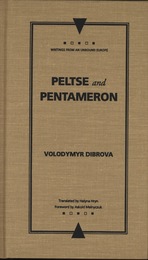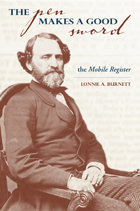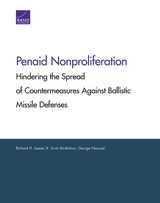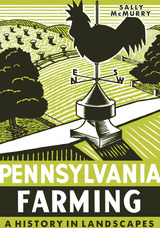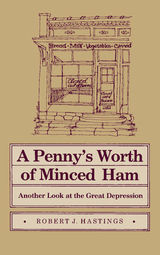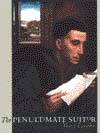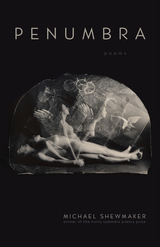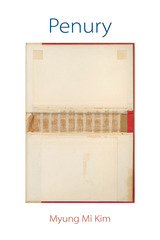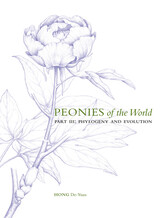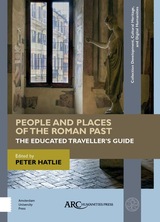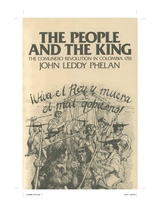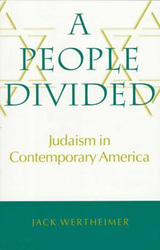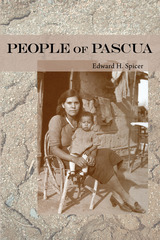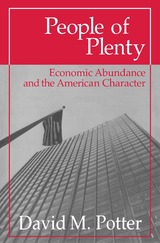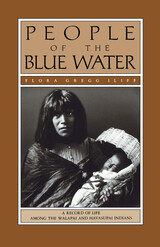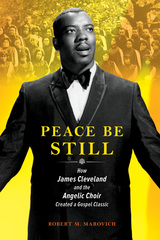 Peace Be Still: How James Cleveland and the Angelic Choir Created a Gospel Classic
Robert M. Marovich
University of Illinois Press, 2021 A Choice Outstanding Academic Title for 2022 In September of 1963, Reverend Lawrence Roberts and the Angelic Choir of the First Baptist Church of Nutley, New Jersey, teamed with rising gospel star James Cleveland to record Peace Be Still. The LP and its haunting title track became a phenomenon. Robert M. Marovich draws on extensive oral interviews and archival research to chart the history of Peace Be Still and the people who created it. Emerging from an established gospel music milieu, Peace Be Still spent several years as the bestselling gospel album of all time. As such, it forged a template for live recordings of services that transformed the gospel music business and Black worship. Marovich also delves into the music's connection to fans and churchgoers, its enormous popularity then and now, and the influence of the Civil Rights Movement on the music's message and reception. The first in-depth history of a foundational recording, Peace Be Still shines a spotlight on the people and times that created a gospel music touchstone.
 Peace in the Mountains: Northern Appalachian Students Protest the Vietnam War
Tom Weyant
University of Tennessee Press, 2020 Peace in the Mountains analyzes student activism at the University of Pittsburgh, Ohio University, and West Virginia University during the Vietnam War era. Drawing from a wide variety of sources including memoirs, periodicals, archival manuscript collections, and college newspapers such as The Pitt News, author Thomas Weyant tracks the dynamics of a student-led campus response to the war in real time and outside the purview of the national media. Along the way, he musters evidence for an emerging social and political conscience among the student bodies of northern Appalachia, citing politics on campus, visions of patriotism and dissent, campus citizenship, antiwar activism and draft resistance, campus issues, and civil rights as major sites of contention and exploration.
Through this regional chronicle of student activism during the Vietnam War era, Weyant holds to one reoccurring and unifying theme: citizenship. His account shows that political activism and civic engagement were by no means reserved to students at elite colleges; on the contrary, Appalachian youth were giving voice to the most vexing questions of local and national responsibility, student and citizen identity, and the role of the university in civil society. Rich in primary source material from student op-eds to administrative documents, Peace in the Mountains draws a new map of student activism in the 1960s and early 1970s. Weyant’s study is a thoughtful and engaging addition to both Appalachian studies and the historiography of the Vietnam War era and is sure to appeal not only to specialists—Appalachian scholars, political historians, political scientists, and sociologists—but to college students and general readers as well.
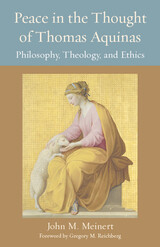 Peace in the Thought of Thomas Aquinas: Philosophy, Theology, and Ethics
John M. Meinert
Catholic University of America Press, 2024 What does Aquinas have to teach us on the topic of peace? Looking over the scholarly literature, one would think very little. Most Thomists ignore Aquinas’s thought on peace. Most peace researchers summarily dismiss Aquinas. Peace in the Thought of Thomas Aquinas challenges both these trends and offers the first book length study of peace in Aquinas’s thought.
John Meinert outlines Aquinas's historical predecessors, then provides an exposition and interpretation of the full scope of Aquinas's thought on peace: metaphysics, Trinitarian theology, Christology, Pneumatology, ecclesiology, natural theology, ethics, and sacramental theology. What emerges from this extended study is a new vision of Aquinas’s work. Peace in the Thought of Thomas Aquinas establishes Aquinas as an indispensable dialogue partner for anyone thinking rigorously about the theology, philosophy, and ethics of peace. As Aquinas himself says, “observe peace and you will come to salvation.”
The Peace of God
Geoffrey Koziol
Arc Humanities Press, 2018 The Peace of God was one of the most important movements of the Middle Ages, yet is highly contested. It has been seen as both radically innovative and fundamentally traditional; as millenarian and not millenarian; as a popular movement and as a way of consolidating power for the elites. Geoffrey Koziol argues for the validity of all these differing viewpoints, because specific instantiations of the Peace of God varied greatly, and there were inherent contradictions in early ideas of peace and peace-making.
 Peace Operations: Trends, Progress, and Prospects
Donald C. F. Daniel, Patricia Taft, and Sharon Wiharta, Editors
Georgetown University Press, 2008 Trends in the number and scope of peace operations since 2000 evidence heightened international appreciation for their value in crisis-response and regional stabilization. Peace Operations: Trends, Progress, and Prospects addresses national and institutional capacities to undertake such operations, by going beyond what is available in previously published literature. Part one focuses on developments across regions and countries. It builds on data- gathering projects undertaken at Georgetown University's Center for Peace and Security Studies (CPASS), the Stockholm International Peace Research Institute (SIPRI), and the Folke Bernadotte Academy (FBA) that offer new information about national contributions to operations and about the organizations through which they make those contributions. The information provides the bases for arriving at unique insights about the characteristics of contributors and about the division of labor between the United Nations and other international entities. Part two looks to trends and prospects within regions and nations. Unlike other studies that focus only on regions with well-established track records—specifically Europe and Africa—this book also looks to the other major areas of the world and poses two questions concerning them: If little or nothing has been done institutionally in a region, why not? What should be expected? This groundbreaking volume will help policymakers and academics understand better the regional and national factors shaping the prospects for peace operations into the next decade.
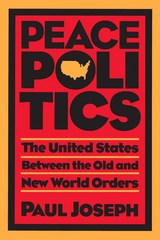 Peace Politics: The United States Between Old and New World Orders
Paul Joseph
Temple University Press, 1993 "Joseph's book is especially valuable and distinctive for its freshly mapped avenues into the sometimes dense field of international relations. His sophisticated analysis of 20th century U.S. peace movements is richly textured and analytically revealing."
--Cynthia Enloe, Clark University, and author of Bananas, Beaches, and Bases
The end of the Cold War promises a new era of global peace in which domestic reform could be achieved. Yet armed conflict persists throughout the world. Economic inequality, declining public services, environmental degradation, and other forms of domestic decay threaten the quality of life in the U.S. In Peace Politics, Paul Joseph develops a systematic comparison of the "old" and "new" world orders that links foreign and domestic affairs. By examining the issues that are central to any realignment of American politics, he offers a sweeping account of the possibilities and obstacles for progressive change over the 1990s.
Acknowledging that all nations and people have a right to security, he argues for a global attack against a broad range of shared threats, including human rights violations, nuclear devastation, poverty and despair, politically repressive governments, and environmental threats. Joseph also addresses the links between the militarism in the U.S. and deforestation of the Amazon, the uncertain victory of the Gulf War, the effect of public opinion on security issues, the impact of peace movements, nuclear weapons policy, and the need for a peace dividend.
Linking war and peace issues with environmental renewal, stronger democracy, economic justice, and citizen activism, Peace Politics is a rallying cry for rationality, genuine security, and mutual survival.
"Paul Joseph offers a much needed, coherent, progressive U.S. foreign policy, based on an analysis of the emerging world and the realities of American society."
--Louis Kriesberg, Director, Program on the Analysis and Resolution of Conflicts, Syracuse University
"Peace Politics is the first book that I have found that fully and systematically explores the implications of the dramatic shift in the international system that we have witnessed in the past few years."
--William A. Gamson, Professor of Sociology, Boston College
"This book is a tour de force. Joseph has packed an enormous amount of material and thoughtful analyses in a very readable presentation. The book is comprehensive, balanced, and wise."
--S.M. Miller, Visiting Professor, Boston College and Senior Fellow, Commonwealth Institute
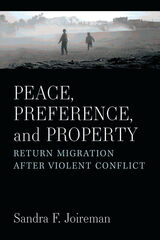 Peace, Preference, and Property: Return Migration after Violent Conflict
Sandra F. Joireman
University of Michigan Press, 2022 Growing numbers of people are displaced by war and violent conflict. In Ukraine, Afghanistan, Ethiopia, Myanmar, Syria, and elsewhere violence pushes civilian populations from their homes and sometimes from their countries, making them refugees. In previous decades, millions of refugees and displaced people returned to their place of origin after conflict or were resettled in countries in the Global North. Now displacements last longer, the number of people returning home is lower, and opportunities for resettlement are shrinking. More and more people spend decades in refugee camps or displaced within their own countries, raising their children away from their home communities and cultures. In this context, international policies encourage return to place of origin. Using case studies and first-person accounts from interviews and fieldwork in post-conflict settings such as Uganda, Liberia, and Kosovo, Sandra F. Joireman highlights the divergence between these policies and the preferences of conflict-displaced people. Rather than looking from the top down, at the rights that people have in international and domestic law, the perspective of this text is from the ground up—examining individual and household choices after conflict. Some refugees want to go home, some do not want to return, some want to return to their countries of origin but live in a different place, and others are repatriated against their will when they have no other options. Peace, Preference, and Property suggests alternative policies that would provide greater choice for displaced people in terms of property restitution and solutions to displacement.
 The Peace Progressives and American Foreign Relations
Robert David Johnson
Harvard University Press, 1995 This intensively researched volume covers a previously neglected aspect of American history: the foreign policy perspective of the peace progressives, a bloc of dissenters in the U.S. Senate, between 1913 and 1935. The Peace Progressives and American Foreign Relations is the first full-length work to focus on these senators during the peak of their collective influence. Robert David Johnson shows that in formulating an anti-imperialist policy, the peace progressives advanced the left-wing alternative to the Wilsonian agenda.
The experience of World War I, and in particular Wilson’s postwar peace settlement, unified the group behind the idea that the United States should play an active world role as the champion of weaker states. Senators Asle Gronna of North Dakota, Robert La Follette and John Blaine of Wisconsin, and William Borah of Idaho, among others, argued that this anti-imperialist vision would reconcile American ideals not only with the country’s foreign policy obligations but also with American economic interests. In applying this ideology to both inter-American and European affairs, the peace progressives emerged as the most powerful opposition to the business-oriented internationalism of the decade’s Republican administrations, while formulating one of the most comprehensive critiques of American foreign policy ever to emerge from Congress.
 The Peace Script: Framing Violence in US Anti-War Dissent
Dominic J. Manthey
University of Alabama Press, 2025 Exposes how appeals to civility, harmony, and nonaggression can unwittingly underpin exclusionary assumptions about race, gender, and class Offering an innovative critique of peace rhetoric throughout US history, The Peace Script: Framing Violence in US Anti-War Dissent reexamines the language of dissent with lessons for our era defined by digital activism and fierce political debates. Dominic J. Manthey explores the peace arguments of various movements, including the Copperhead Movement during the Civil War, the Anti-Imperialist League’s stance against US colonialism, Henry Ford's Peace Ship expedition during World War I, the Mothers’ Movement during World War II, and the Vietnam Veterans against the War. Each chapter reveals how these movements, while advocating for peace, often upheld or encouraged racial, gender, and class inequalities. Manthey navigates the complex terrain of grassroots activism by blending rhetorical criticism and historical insight to tell readers about the “peace script” that has echoed across America’s many wars. Through archival materials and case studies, The Peace Script reveals how anti-war movements craft compelling narratives that dramatize society through heroes, antagonists, and transformative ideals. Redefining the struggle for peace as not only a fight against warfare but also a battle over space, identity, and the right to live with dignity, The Peace Script is essential for scholars of history, rhetoric, and social justice. Manthey provides a crucial perspective on the intersection of race, memory and power, offering urgent insights into how these legacies continue to shape society today.
The Peace That Never Was: A History of the League of Nations
Ruth Henig
Haus Publishing, 2010 Ninety years ago, the League of Nations convened for the first time, hoping to create a safeguard against destructive, world-wide war by settling disputes through diplomacy. This book looks at how the League was conceptualized and explores the multifaceted body that emerged. This new form for diplomacy was used in ensuing years to counter territorial ambitions and restrict armaments, as well as to discuss human rights and refugee issues. The League’s failure to prevent World War II, however, would lead to its dissolution and the subsequent creation of the United Nations. As we face new forms of global crisis, this timely book asks if the UN’s fate could be ascertained by reading the history of its predecessor.
 Peace through Commerce: Responsible Corporate Citizenship and the Ideals of the United Nations Global Compact
Oliver F. Williams, C.S.C.
University of Notre Dame Press, 2008
In today's global economy, business leaders need to develop new policies and practices aimed at promoting responsible corporate citizenship. The United Nations Global Compact, launched in 2000, serves as a forum in which multinational businesses work to promote human rights, prevent violent conflict, and contribute to more peaceful societies. Peace through Commerce: Responsible Corporate Citizenship and the Ideals of the United Nations Global Compact contains a foreword, introduction, and twenty-one chapters by major business leaders and scholars who discuss the issues set out by the UN Global Compact. The chapters address the purpose of the corporation; the influence of legal and peace studies; the experience of career NGO officials and of business leaders; how commerce can help promote peace; and how we might envision the future. Ten case studies document the efforts of individual businesses, including IBM, Chevron, Bristol-Myers-Squibb, General Electric, Nestle, and Ford, to successfully serve society’s interests as well as their own. Peace through Commerce will lay the groundwork for courses in business schools on corporate social responsibility, corporate citizenship, and global environment of business.
“This book makes a significant contribution to the literature on corporate social responsibility. While the general relationship between economic development and peace has been explored before, the practical exploration of corporate strategies embodied in this book is completely new. It will be of interest not only to those interested in corporate responsibility but also those who study development economics and those involved in peace studies.” —Kirk O. Hanson, Santa Clara University
“There are many books of readings on CSR and Corporate Citizenship available. But this book has a newness, a freshness and sense of quality about it, that I think makes it stand out. It is definitely global in perspective. Most of the articles and cases are very good and serve their specific purpose. Some new ground is broken and, of greater importance, this is an excellent book for a seminar on responsible corporate citizenship or for one focused on CSR on a global level.” —Thomas A. Bausch, Marquette University
The Peaceable Kingdom: A Primer in Christian Ethics
Stanley Hauerwas
University of Notre Dame Press, 1983 Stanley Hauerwas presents an overall introduction to the themes and method that have distinguished his vision of Christian ethics. Emphasizing the significance of Jesus’ life and teaching in shaping moral life, The Peaceable Kingdom stresses the narrative character of moral rationality and the necessity of a historic community and tradition for morality. Hauerwas systematically develops the importance of character and virtue as elements of decision making and spirituality and stresses nonviolence as critical for shaping our understanding of Christian ethics.
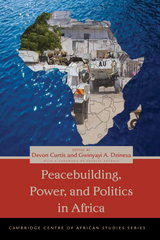 Peacebuilding, Power, and Politics in Africa
Devon Curtis
Ohio University Press, 2012 Peacebuilding, Power, and Politics in Africa is a critical reflection on peacebuilding efforts in Africa. The authors expose the tensions and contradictions in different clusters of peacebuilding activities, including peace negotiations; statebuilding; security sector governance; and disarmament, demobilization, and reintegration. Essays also address the institutional framework for peacebuilding in Africa and the ideological underpinnings of key institutions, including the African Union, NEPAD, the African Development Bank, the Pan-African Ministers Conference for Public and Civil Service, the UN Peacebuilding Commission, the World Bank, and the International Criminal Court. The volume includes on-the-ground case study chapters on Sudan, the Great Lakes Region of Africa, Sierra Leone and Liberia, the Niger Delta, Southern Africa, and Somalia, analyzing how peacebuilding operates in particular African contexts. The authors adopt a variety of approaches, but they share a conviction that peacebuilding in Africa is not a script that is authored solely in Western capitals and in the corridors of the United Nations. Rather, the writers in this volume focus on the interaction between local and global ideas and practices in the reconstitution of authority and livelihoods after conflict. The book systematically showcases the tensions that occur within and between the many actors involved in the peacebuilding industry, as well as their intended beneficiaries. It looks at the multiple ways in which peacebuilding ideas and initiatives are reinforced, questioned, reappropriated, and redesigned by different African actors. A joint project between the Centre for Conflict Resolution in Cape Town, South Africa, and the Centre of African Studies at the University of Cambridge.
 A Peaceful Conquest: Woodrow Wilson, Religion, and the New World Order
Cara Lea Burnidge
University of Chicago Press, 2016 A century after his presidency, Woodrow Wilson remains one of the most compelling and complicated figures ever to occupy the Oval Office. A political outsider, Wilson brought to the presidency a distinctive, strongly held worldview, built on powerful religious traditions that informed his idea of America and its place in the world.
With A Peaceful Conquest, Cara Lea Burnidge presents the most detailed analysis yet of how Wilson’s religious beliefs affected his vision of American foreign policy, with repercussions that lasted into the Cold War and beyond. Framing Wilson’s intellectual development in relationship to the national religious landscape, and paying greater attention to the role of religion than in previous scholarship, Burnidge shows how Wilson’s blend of Southern evangelicalism and social Christianity became a central part of how America saw itself in the world, influencing seemingly secular policy decisions in subtle, lasting ways. Ultimately, Burnidge makes a case for Wilson’s religiosity as one of the key drivers of the emergence of the public conception of America’s unique, indispensable role in international relations.
As the presidential election cycle once again raises questions of America’s place in the world, A Peaceful Conquest offers a fascinating excavation of its little-known roots.
Peaceful Resistance: Building a Palestinian University Under Occupation
Gabi Baramki
Pluto Press, 2009 This book tells the remarkable story of Birzeit University, Palestine’s oldest university in the Occupied Territories.
Founded against the backdrop of occupation, it is open to all students, irrespective of income. Putting the study of democracy and tolerance at the heart of its curriculum, Birzeit continues to produce idealistic young people who can work to bring about a peaceful future. Gabi Baramki explains how the University has survived against shocking odds, including direct attacks where Israeli soldiers have shot unarmed students. Baramki himself has been dragged from his home at night, beaten and arrested. Yet Birzeit continues to thrive, putting peace at the heart of its teaching, and offering Palestinians the opportunities that only education can bring.
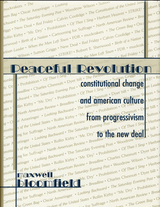 Peaceful Revolution: Constitutional Change and American Culture from Progressivism to the New Deal
Maxwell Bloomfield
Harvard University Press, 2000 Although Americans claim to revere the Constitution, relatively few understand its workings. Its real importance for the average citizen is as an enduring reminder of the moral vision that shaped the nation's founding. Yet scholars have paid little attention to the broader appeal that constitutional idealism has always made to the American imagination through publications and films. Maxwell Bloomfield draws upon such neglected sources to illustrate the way in which media coverage contributes to major constitutional change.
Successive generations have sought to reaffirm a sense of national identity and purpose by appealing to constitutional norms, defined on an official level by law and government. Public support, however, may depend more on messages delivered by the popular media. Muckraking novels, such as Upton Sinclair's The Jungle (1906), debated federal economic regulation. Woman suffrage organizations produced films to counteract the harmful gender stereotypes of early comedies. Arguments over the enforcement of black civil rights in the Civil Rights Cases and Plessy v. Ferguson took on new meaning when dramatized in popular novels.
From the founding to the present, Americans have been taught that even radical changes may be achieved through orderly constitutional procedures. How both elite and marginalized groups in American society reaffirmed and communicated this faith in the first three decades of the twentieth century is the central theme of this book.
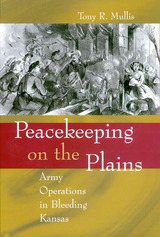 Peacekeeping on the Plains: Army Operations in Bleeding Kansas
Tony R. Mullis
University of Missouri Press, 2004 Historians have written on “Bleeding Kansas” and on the frontier army as a constabulary force, but little scholarship exists on how the army performed its peacekeeping operations in the 1850s. In Peacekeeping on the Plains, Tony R. Mullis is one of the first scholars to detail the military concerns associated with peace enforcement in Kansas and the trans-Missouri West. Between 1854 and 1856, the Franklin Pierce administration called upon the U.S. Army to conduct a series of peace operations in the newly formed Kansas and Nebraska territories. The army responded to the president’s call by successfully completing a mission against the Lakota Sioux in 1855 and by aiding civil authorities in the imposition of peace among competing factions in Kansas during 1856. Although these police duties were not always popular with the soldiers that conducted them, the purpose behind them remained constant—the maintenance of peace, order, and security. Given Americans’ misgivings about a standing army and their limited expectations for it as a domestic peacekeeper, its use in this fashion during the 1850s was a delicate proposition. By drawing on diverse sources, including official army correspondence, personal papers of key military and political leaders, and local accounts of army activities, Mullis shows how peace operations were conducted by the U.S. Army long before the second half of the twentieth century. He alsopresents a thorough analysis of the professional dilemmas confronted by army officers, as well as the delicate command and control issues associated with the different types of peace operations. Mullis’s assessment of the army’s peacekeeping efforts in the mid-1850s offers a full understanding of the constraints and frustrations involved. Many of the dilemmas faced by the army in Kansas parallel those encountered in various spots around the globe today. Peacekeeping on the Plains will provide any reader with a better insight into the nuances of peace operations in the 1850s and assist military historians in their understanding of these activities as they relate to the twenty-first century.
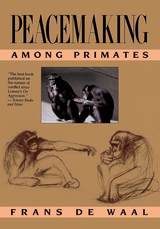 Peacemaking among Primates
Frans B. M. de Waal
Harvard University Press, 1989 Does biology condemn the human species to violence and war? Previous studies of animal behavior incline us to answer yes, but the message of this book is considerably more optimistic. Without denying our heritage of aggressive behavior, Frans de Waal describes powerful checks and balances in the makeup of our closest animal relatives, and in so doing he shows that to humans making peace is as natural as making war.
In this meticulously researched and absorbing account, we learn in detail how different types of simians cope with aggression, and how they make peace after fights. Chimpanzees, for instance, reconcile with a hug and a kiss, whereas rhesus monkeys groom the fur of former adversaries. By objectively examining the dynamics of primate social interactions, de Waal makes a convincing case that confrontation should not be viewed as a barrier to sociality but rather as an unavoidable element upon which social relationships can be built and strengthened through reconciliation.
The author examines five different species—chimpanzees, rhesus monkeys, stump-tailed monkeys, bonobos, and humans—and relates anecdotes, culled from exhaustive observations, that convey the intricacies and refinements of simian behavior. Each species utilizes its own unique peacemaking strategies. The bonobo, for example, is little known to science, and even less to the general public, but this rare ape maintains peace by means of sexual behavior divorced from reproductive functions; sex occurs in all possible combinations and positions whenever social tensions need to be resolved. “Make love, not war” could be the bonobo slogan.
De Waal’s demonstration of reconciliation in both monkeys and apes strongly supports his thesis that forgiveness and peacemaking are widespread among nonhuman primates—an aspect of primate societies that should stimulate much needed work on human conflict resolution.
Peach State: Poems
Adrienne Su
University of Pittsburgh Press, 2021 Finalist, 2022 Patterson Poetry Prize
Peach State has its origins in Atlanta, Georgia, the author’s hometown and an emblematic city of the New South, a name that reflects the American region’s invigoration in recent decades by immigration and a spirit of reinvention. Focused mainly on food and cooking, these poems explore the city’s transformation from the mid-twentieth century to today, as seen and shaped by Chinese Americans. The poems are set in restaurants, home kitchens, grocery stores, and the houses of friends and neighbors. Often employing forms—sonnet, villanelle, sestina, palindrome, ghazal, rhymed stanzas—they also mirror the constant negotiation with tradition that marks both immigrant and Southern experience.
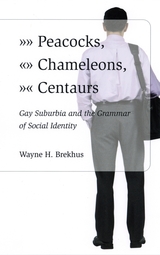 Peacocks, Chameleons, Centaurs: Gay Suburbia and the Grammar of Social Identity
Wayne Brekhus
University of Chicago Press, 2003 What does it mean to be a gay man living in the suburbs? Do you identify primarily as gay, or suburban, or some combination of the two? For that matter, how does anyone decide what his or her identity is?
In this first-ever ethnography of American gay suburbanites, Wayne H. Brekhus demonstrates that who one is depends at least in part on where and when one is. For many urban gay men, being homosexual is key to their identity because they live, work, and socialize in almost exclusively gay circles. Brekhus calls such men "lifestylers" or peacocks. Chameleons or "commuters," on the other hand, live and work in conventional suburban settings, but lead intense gay social and sexual lives outside the suburbs. Centaurs, meanwhile, or "integrators," mix typical suburban jobs and homes with low-key gay social and sexual activities. In other words, lifestylers see homosexuality as something you are, commuters as something you do, and integrators as part of yourself.
Ultimately, Brekhus shows that lifestyling, commuting, and integrating embody competing identity strategies that occur not only among gay men but across a broad range of social categories. What results, then, is an innovative work that will interest sociologists, psychologists, anthropologists, and students of gay culture.
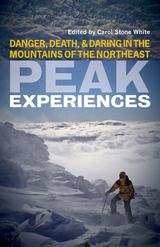 Peak Experiences: Danger, Death, and Daring in the Mountains of the Northeast
Edited by Carol Stone White
University Press of New England, 2012 In the mountains, the difference between a pleasant day of hiking and a life-threatening disaster is as simple as a loose rock, a turned ankle, or a misjudged patch of ice. In an instant, even the most experienced and prepared of outdoorspersons can find themselves at the mercy of the elements (and their own choices) — and suddenly, sometimes tragically, the situation slips out their control. In this collection of over fifty tales of day hikes and long treks gone awry, the seasoned climber and writer Carol Stone White brings together some of her favorite tales of outdoor misadventure written by colleagues and fellow enthusiasts who have experienced the harsher side of climbing the peaks of New England and the Adirondacks. From freak falls to outrunning storms, from life-threatening hypothermia to the excitement of unlikely rescues, these tales inform as much as they entertain, teaching even the experienced climber that accidents can happen to anyone and that preparation and the ability to make split-second decisions can often mean the difference between life and death. Like sitting around the campfire sharing tales of terror and near death with your hiking buddies, this collection will appeal to the true outdoorsperson as well as the armchair adventurer.
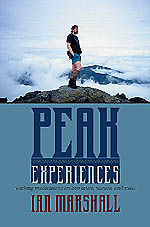 Peak Experiences: Walking Meditations on Literature, Nature, and Need
Ian Marshall
University of Virginia Press, 2003 Nature's ability to satisfy deep human needs is familiar to anyone who has hiked up a mountain, canoed a river, or hung a bird feeder outside the kitchen window. In Story Line, his groundbreaking work of narrative ecocriticism, Ian Marshall explores how natural surroundings inspired works of literature set along the Appalachian Trail. In his new work, Peak Experiences, Marshall sets out on a far more personal and at the same time far-reaching journey, to discover how our modern estrangement from the natural world has affected our mental well-being.
Taking as his starting point the psychologist Abraham Maslow's "hierarchy of human needs"--a pyramid familiar to anyone who ever cracked a textbook for Psych 101--Marshall asks how his own experience of deep satisfaction in nature may or may not fit Maslow's theory. In chapters focused on the needs identified by Maslow, Marshall finds evidence for the healing power of nature in literature and in his own experiences in the wild.
"I offer myself as test subject," Marshall writes: "recently divorced, a father sharing custody of two children, someone with a high regard for the written word, . . . a little too stressed-out these days, no more self-actualized than the next person but just as curious about it--and what I have going for me are a lot of well-read books, a good pair of broken-in hiking boots, and a thing for mountains."
Embracing the exciting new field of ecopsychology, Marshall leads us on a personal and intellectual odyssey, from the dream mountain of Henry David Thoreau to the high slopes of John Muir's beloved Mount Shasta. Always, Marshall returns to his own challenges as father and reader, and to his own humble but rewarding mountain, Bald Eagle Ridge, in the Pennsylvania countryside outside his back door.
--------------------------------------------------------------------------------
Ian Marshall, Professor of English at Penn State Altoona, is author of Story Line: Exploring the Literature of the Appalachian Trail (Virginia).
 Peak Japan: The End of Great Ambitions
Brad Glosserman
Georgetown University Press, 2019 The post-Cold War era has been difficult for Japan. A country once heralded for evolving a superior form of capitalism and seemingly ready to surpass the United States as the world’s largest economy lost its way in the early 1990s. The bursting of the bubble in 1991 ushered in a period of political and economic uncertainty that has lasted for over two decades. There were hopes that the triple catastrophe of March 11, 2011—a massive earthquake, tsunami, and accident at the Fukushima Daiichi nuclear power plant—would break Japan out of its torpor and spur the country to embrace change that would restart the growth and optimism of the go-go years. But several years later, Japan is still waiting for needed transformation, and Brad Glosserman concludes that the fact that even disaster has not spurred radical enough reform reveals something about Japan's political system and Japanese society. Glosserman explains why Japan has not and will not change, concluding that Japanese horizons are shrinking and that the Japanese public has given up the bold ambitions of previous generations and its current leadership. This is a critical insight into contemporary Japan and one that should shape our thinking about this vital country.
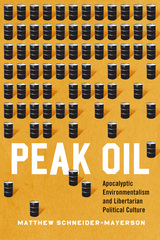 Peak Oil: Apocalyptic Environmentalism and Libertarian Political Culture
Matthew Schneider-Mayerson
University of Chicago Press, 2015 In recent years, the concept of “peak oil”—the moment when global oil production peaks and a train of economic, social, and political catastrophes accompany its subsequent decline—has captured the imagination of a surprisingly large number of Americans, ordinary citizens as well as scholars, and created a quiet, yet intense underground movement.
In Peak Oil, Matthew Schneider-Mayerson takes readers deep inside the world of “peakists,” showing how their hopes and fears about the postcarbon future led them to prepare for the social breakdown they foresee—all of which are fervently discussed and debated via websites, online forums, videos, and novels. By exploring the worldview of peakists, and the unexpected way that the fear of peak oil and climate change transformed many members of this left-leaning group into survivalists, Schneider-Mayerson builds a larger analysis of the rise of libertarianism, the role of oil in modern life, the political impact of digital technologies, the racial and gender dynamics of post-apocalyptic fantasies, and the social organization of environmental denial.
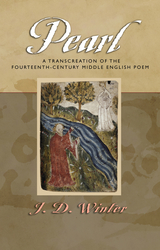 Pearl: A Transcreation of the Fourteenth-century Middle English Poem
J. D. Winter
Sussex Academic Press, 2022 Pearl occupies a special place in the English canon. Together with Gawain and the Green Knight and two minor poems, the late fourteenth-century manuscript came to light after nearly 500 years of being tucked away in one private library or another. While Gawain (which may or may not be by the same hand) received early acclaim as a marvellously-written tale of magic and derring-do, Pearl has yet fully to gain the popularity it richly deserves. In terms of psychological discovery, theological debate, and an unmatched technical brilliance in the joint deployment of alliteration and rhyme, it is a thing of wonder.
A dream-vision for almost its entire length, Pearl has a direct relation to the narrator's real world. Whether or not the situation it depicts is a fictional one, the poem stands as a commemoration of the deepest personal experience. While the descriptive passages of a heaven-made world are remarkable, the exchange between a grieving man and the pearl he has lost and found pitched almost in terms of a quickfire argument is irresistible. A young female character, taking her time, demolishes a learned male opponent. Yet love speaks throughout, in a Christian presentation of the struggle to relinquish self-will, so that by the deftest of literary strokes the reader finally is one with the dreamer as he comes to terms with the beauty of what must be.
This translation meticulously preserves a highly-demanding formal structure and lexical meaning while operating with a freedom which ideally, in this kind of poetry, is that of a conversational song. Dream-poems were not uncommon in the fourteenth century; and Pearl not only is a perfect example of the genre, but offers a poetic experience to reach beyond genre and time.
Pearl from the Dragon’s Mouth: Evocation of Scene and Feeling in Chinese Poetry
Cecile C. C. Sun
University of Michigan Press, 1995 The interplay between the external world (ching) and the poet’s inner world (ch’ing) lies at the heart of Chinese poetry, and understanding the interaction of the two is crucial to understanding this work from within its own tradition. Closely coordinating her discussions of poetry and criticism so that practice and theory become mutually enriching and illuminating, Sun offers sensitive and original readings of poems and a wealth of insights into Chinese poetics.
 The Pearl Frontier: Indonesian Labor and Indigenous Encounters in Australia's Northern Trading Network
Julia Martínez and Adrian Vickers
University of Hawaii Press, 2015 Remarkable for its meticulous archival research and moving life stories, The Pearl Frontier offers a new way of imagining Australian historical connections with Indonesia. This compelling view of maritime mobility demonstrates how, in the colonial quest for the valuable pearl-shell, Australians came to rely on the skill and labor of Indonesian islanders, drawing them into their northern pearling trade empire. From the 1860s onwards the pearl-shell industry developed alongside British colonial conquests across Australia’s northern coast and prompted the Dutch to consolidate their hold over the Netherlands East Indies. Inspired by tales of pirates and priceless pearls, the pearl frontier witnessed the maritime equivalent of a gold rush; with traders, entrepreneurs, and willing workers coming from across the globe. But like so many other frontier zones it soon became notorious for its reliance on slave-like conditions for indigenous and Indonesian workers. These allegations prompted the imposition of a strict regime of indentured labor migration that was to last for almost a century before giving way to international criticism in the era of decolonization. The Pearl Frontier reveals how Asian migration and the struggle against the restrictive White Australia policy left a rich legacy of mixed Asian-Indigenous heritage that lives on along Australia’s northern coastline. Instead of the mythologies of racial purity, propagated by settler colonies and European empires, the authors dissect the social and economic life of the port cities around the Australian- Indonesian maritime zone and lay open the complex, cosmopolitan relationships that shaped their histories and their present situations.
Pearls of Meaning: Studies on Persian Art, Poetry, ..f.sm and History of Iranian Studies in Europe.J.T.P. de Bruijn
J.T. P. de Bruijn
Leiden University Press, 2020 Pearls of Meanings offers a collection of essays by J.T.P. (Hans) de Bruijn, leading scholar in the field of Persian Studies, in which essential domains of Persian culture such as poetry and Sufism are analyzed in an exemplary fashion. While poetry plays a pivotal position in these essays, the reception of Persian literary tradition in Europe is another focus of the volume, thereby representing the studies of a generation of scholars such as A. Reland (1676-1718), C.H. Ethé (1844-1917), J.F. von Hammer-Purgstall (1774-1856) and E.G. Browne (1862-1926) who devoted their attention to Persian culture.
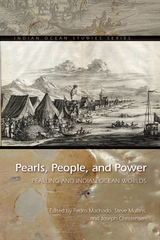 Pearls, People, and Power: Pearling and Indian Ocean Worlds
Pedro Machado
Ohio University Press, 2019 Pearls, People, and Power is the first book to examine the trade, distribution, production, and consumption of pearls and mother-of-pearl in the global Indian Ocean over more than five centuries. While scholars have long recognized the importance of pearling to the social, cultural, and economic practices of both coastal and inland areas, the overwhelming majority have confined themselves to highly localized or at best regional studies of the pearl trade. By contrast, this book stresses how pearling and the exchange in pearl shell were interconnected processes that brought the ports, islands, and coasts into close relation with one another, creating dense networks of connectivity that were not necessarily circumscribed by local, regional, or indeed national frames. Essays from a variety of disciplines address the role of slaves and indentured workers in maritime labor arrangements, systems of bondage and transoceanic migration, the impact of European imperialism on regional and local communities, commodity flows and networks of exchange, and patterns of marine resource exploitation between the Industrial Revolution and Great Depression. By encompassing the geographical, cultural, and thematic diversity of Indian Ocean pearling, Pearls, People, and Power deepens our appreciation of the underlying historical dynamics of the many worlds of the Indian Ocean. Contributors: Robert Carter, William G. Clarence-Smith, Joseph Christensen, Matthew S. Hopper, Pedro Machado, Julia T. Martínez, Michael McCarthy, Jonathan Miran, Steve Mullins, Karl Neuenfeldt, Samuel M. Ostroff, and James Francis Warren.
The Pearlsong
Adam Bremer-McCollum
Harvard University Press The Pearlsong is an ancient poem that recounts the story of a Parthian prince sent by his parents on a mission to Egypt to retrieve a pearl from the clutches of a giant serpent. Along the way, the prince falls asleep and forgets his identity and mission. A letter from his parents awakens him, gives him a spell to put the serpent to sleep so he can retrieve the pearl, and then guides him home. The poem was originally composed in Syriac, translated into Greek, and later paraphrased in Greek again in a homily. These three texts are all published here with a parallel English translation on facing pages, accompanied by an introduction, commentary, and Syriac and Greek glossaries.
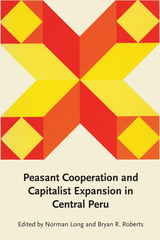 Peasant Cooperation and Capitalist Expansion in Central Peru
Edited by Norman Long and Bryan R. Roberts
University of Texas Press, 1978 This book brings together the research into regional development and social change carried out in highland Peru by a team of British and Latin American social anthropologists and sociologists. The area studied—the Mantaro Valley of central Peru—is one of the most densely populated and economically differentiated of highland zones; it is also notable for its community-based forms of cooperation and its high level of peasant political activity. The book presents a series of case studies that examine cooperative forms of organization in relation to developments in the regional economy and to changes in national policy. The analysis attempts to avoid interpreting local processes merely as responses to externally initiated change. It stresses instead the need to consider the interplay of local and national forces, because local groups and processes themselves affect the pattern of regional and national development. The case studies cover a range of political and economic topics, from peasant movements to the achievements and shortcomings of government-sponsored agricultural and manufacturing cooperatives. The concluding chapter, by the editors, explores the theoretical implications of these studies.
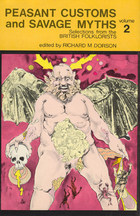 Peasant Customs and Savage Myths: Selections from the British Folklorists
Edited by Richard M. Dorson
University of Chicago Press, 1969 The word "folklore" was coined in 1846 by an English antiquary, William John Thoms, although Professor Dorson's intellectual history of the folklore movement shows that the study of folklore had its origins in an earlier period. Educated men and women in many fields, especially in Victorian times, succumbed to the fascination of noting curious tales and odd rituals both at home and abroad. The British Folklorists describes how the influence of folklore extended into many fields such as literature, history, the classics, archaeology, philology, psychical research, legal and medical antiquities, Scandinavian, Germanic, and Celtic studies, and the history of religions. Interest in the collection of folklore was carried to the far corners of the British Empire by colonial administrators, missionaries, and military officers, who found that a knowledge of local folklore helped them understand the strangers they lived among.
Professor Dorson traces the historical development of folklore as a field of learning, beginning with sixteenth-century antiquarians whose studies encompassed the preservation of local customs and reaching its climax with the "Great Team" of Andrew Lang and his co-workers from the 1870's to the First World War.
Peasant Intellectuals: Anthropology and History in Tanzania
Steven Feierman
University of Wisconsin Press, 1990 Scholars who study peasant society now realize that peasants are not passive, but quite capable of acting in their own interests. But, do coherent political ideas emerge within peasant society or do peasants act in a world where elites define political issues? Peasant Intellectuals is based on ethnographic research begun in 1966 and includes interviews with hundreds of people from all levels of Tanzanian society. Steven Feierman provides the history of the struggles to define the most basic issues of public political discourse in the Shambaa-speaking region of Tanzania. Feierman also shows that peasant society contains a rich body of alternative sources of political language from which future debates will be shaped.
 Peasantry in the Cheb City-State in the Late Middle Ages: Socioeconomic Mobility and Migration
Tomáš Klír
Karolinum Press, 2024 A reassessment of fundamental scholarship on the Middle Ages, based on previously unknown medieval written source material.
The medieval peasantry represents a particularly compelling unknown for historians, as it holds the key to understanding both later economic growth and the surprising stagnation experienced in some European regions. Our current knowledge about the social structures and institutions of the medieval peasantry remains superficial, with almost nothing known about their real inner dynamics and demographic aspects. The present monograph confronts this issue head-on, taking advantage of previously neglected written sources from the Cheb city-state, which are unique in the European context. Drawing from this material, the book presents a remarkably detailed view of social mobility, migration, and the reproduction of social structures among the peasantry in the late Middle Ages while offering new perspectives on the mass abandonment of rural settlements during that period. It also identifies hitherto unknown mechanisms by which peasant communities responded to family demographic cycles and short-term economic fluctuations.
 Peasants against Politics: Rural Organization in Brittany, 1911–1967
Suzanne Berger
Harvard University Press, 1972 “The modern European state has lived upon a reservoir of soldiers and electors provided by the peasantry, but the peasants have remained the object of politics and not its master,” states Suzanne Berger. One of the few political scientists and students of the modernization process to look at the peasant-state relationship in the old nations of Europe, Berger explores the impact of mass organization on the politics of the peasants.
“One might have predicted,” she writes, “that as peasants became involved in local cooperative and syndical associations, their participation in the politics of the national community would have increased.” The results of her research show, however, that between 1911 and 1967 peasant participation in a wide range of rural associations did not significantly contribute to their integration into the national political system. Why have changes in rural society had so little impact on the peasant's political role?
In considering this question, the author compares peasant organizations in Finistere and Côtes-du-Nord, two backward agricultural departments in western France. Although the social and economic structures of these areas were essentially the same, different types of organizations mobilized the peasants. In Finistere, corporative associations separated the countryside from the currents of national political life. As a result, party politics in Finistere became stagnant, and peasant electors voted in 1967 as they had in the first quarter of the century. In Côtes-du-Nord, on the other hand, the forces that organized the peasants were political parties, and they involved the countryside in national politics. It is this involvement that, according to the author, has contributed to a politicization of local communities and resulted in radical political change.
Peasants Against the State: The Politics of Market Control in Bugisu, Uganda, 1900-1983
Stephen G. Bunker
University of Chicago Press, 1991 Stephen Bunker challenges the image of peasants as passive victims and argues that coffee growers in the Bugisu District of Uganda, because they own land and may choose which crops to produce, maintain an unusual degree of economic and political independence.
Focusing on peasant struggles for market control over coffee exports in Bugisu from colonial times through the reign and overthrow of Idi Amin, Bunker shows that these freeholding peasants acted collectively and used the state's dependence on coffee export revenues to effectively influence and veto government programs inimical to their interests.
Bunker's work vividly portrays the small victories and great trials of ordinary people struggling to control their own economic destiny while resisting the power of the world economy.
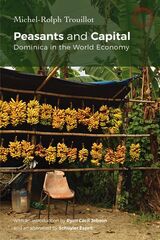 Peasants and Capital: Dominica in the World Economy
Michel-Rolph Trouillot
HAU, 2025 A new edition of Michel-Rolph Trouillot’s influential ethnography of a village in Dominica.
Over thirty-five years ago, Michel-Rolph Trouillot’s debut ethnography, Peasants and Capital: Dominica in the World Economy, dared to regard peasants not as vestiges of premodern economies but as instrumental to, and integrated in, a capitalist world system. Combining historical ethnography with an intimate portrait of a banana-producing eastern Caribbean village, this multi-sited study demonstrates how multinational capital thrives on the surplus production of peasant cultivators. At the same time, it investigates how peasantries generate independent conceptions of value and subsistence in the process of building a new postcolonial state in Dominica. This new edition of Peasants and Capital invites anthropologists to revisit the methodological innovations of this multi-scalar study and readers to meditate on the continued vitality of peasant livelihoods in the Caribbean today.
Ryan Cecil Jobson’s new introduction situates this edition in the context of Trouillot’s remarkable life and career. Jobson reminds us of the book’s enduring theoretical and ethnographic significance and asks us to consider how the entanglement of peasants from Dominica in national and world affairs has been impacted by more recent histories, such as the end of preferential markets for Caribbean bananas, the migration of “banana children” to regional and metropolitan urban centers, and the devastation of Dominica by Hurricane Maria.
Peasants In Arms: War and Peace in the Mountains of Nicaragua, 1979–1994
Lynn Horton
Ohio University Press, 1999 Drawing on testimonies from contra collaborators and ex-combatants, as well as pro-Sandinista peasants, this book presents a dynamic account of the growing divisions between peasants from the area of Quilalí who took up arms in defense of revolutionary programs and ideals such as land reform and equality and those who opposed the FSLN. Peasants in Arms details the role of local elites in organizing the first anti-Sandinista uprising in 1980 and their subsequent rise to positions of field command in the contras. Lynn Horton explores the internal factors that led a majority of peasants to turn against the revolution and the ways in which the military draft, and family and community pressures reinforced conflict and undermined mid-decade FSLN policy shifts that attempted to win back peasant support.
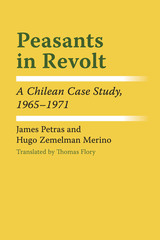 Peasants in Revolt: A Chilean Case Study, 1965–1971
By James Petras and Hugo Zemelman Merino; translated by Thomas Flory
University of Texas Press, 1973 Based on extended interviews at the Culiprán fundo in Chile with peasants who recount in their own terms their political evolution, this is an in-depth study of peasants in social and political action. It deals with two basic themes: first, the authoritarian structure within a traditional latifundio and its eventual replacement by a peasant-based elected committee, and second, the events shaping the emergence of political consciousness among the peasantry. Petras and Zemelman Merino trace the careers of local peasant leaders, followers, and opponents of the violent illegal land seizure in 1965 and the events that triggered the particular action. The findings of this study challenge the oft-accepted assumption that peasants represent a passive, traditional, downtrodden group capable only of following urban-based elites. The peasant militants, while differing considerably in their ability to grasp complex political and social problems, show a great deal of political skill, calculate rationally on the possibility of success, and select and manipulate political allies on the basis of their own primary needs. The politicized peasantry lend their allegiance to those forces with whom they anticipate they have the most to gain—and under circumstances that minimize social costs. The authors identify the highly repressive political culture within the latifundio—reinforced by the national political system—as the key factor inhibiting overt expressions of political demands. The emergence of revolutionary political consciousness is found to be the result of cumulative experiences and the breakdown of traditional institutions of control. The violent illegal seizure of the farm is perceived by the peasantry as a legitimate act based on self-interest as well as general principles of justice—in other words, the seizure is perceived as a “natural act,” suggesting that perhaps two sets of moralities functioned within the traditional system. The book is divided into two parts: the first part contains a detailed analysis of peasant behavior; the second contains transcriptions of peasant interviews. Combined, they give the texture and flavor of insurgent peasant politics.
PEASANTS OF LANGUEDOC
Emmanuel Le Roy Ladurie
University of Illinois Press, 1974 Hailed as a pioneering work of
"total history" when it was published in France in 1966, Le Roy Ladurie's
volume combines elements of human geography, historical demography, economic
history, and folk culture in a broad depiction of a great agrarian cycle,
lasting from the Renaissance to the Enlightenment. It describes the conflicts
and contradictions of a traditional peasant society in which the rise in
population was not matched by increases in wealth and food production.
"It presents us with a great study of rural history, an analysis of economic change and a description of a society
in movement that has few equals."
-- Washington Post Book World
"It is without any doubt one of the most important, if not the most important, monograph of the French Annales school of socio-economic
historians written in the last decade." -- Canadian Historical Review
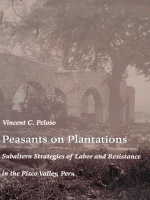 Peasants on Plantations: Subaltern Strategies of Labor and Resistance in the Pisco Valley, Peru
Vincent Peloso
Duke University Press, 1999 After the 1854 abolition of slavery in Peru, a new generation of plantation owners turned to a system of peasant tenantry to maintain cotton production through the use of cheap labor. In Peasants on Plantations Vincent C. Peloso analyzes the changing social and economic relationships governing the production of cotton in the Pisco Valley, a little-studied area of Peru’s south coast. Challenging widely held assumptions about the system of relations that tied peasants to the land, Peloso’s work examines the interdependence of the planters, managers, and peasants—and the various strategies used by peasants in their struggle to resist control by the owners. Grounded in the theoretical perspectives of subaltern studies and drawing on an extremely complete archive of landed estates that includes detailed regular reports by plantation managers on all aspects of farming life, Peasants on Plantations reveals the intricate ways peasants, managers, and owners manipulated each other to benefit their own interests. As Peloso demonstrates, rather than a simple case of domination of the peasants by the owners, both parties realized that negotiation was the key to successful growth, often with the result that peasants cooperated with plantation growth strategies in order to participate in a market economy. Long-term contracts gave tenants and sharecroppers many opportunities to make farming choices, to assert claims on the land, compete among themselves, and participate in plantation expansion. At the same time, owners strove to keep the peasants in debt and well aware of who maintained ultimate control. Peasants on Plantations offers a largely untold view of the monumental struggle between planters and peasants that was fundamental in shaping the agrarian history of Peru. It will interest those engaged in Latin American studies, anthropology, and peasant and agrarian studies.
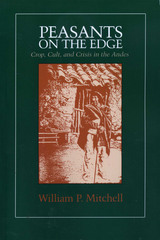 Peasants on the Edge: Crop, Cult, and Crisis in the Andes
By William P. Mitchell
University of Texas Press, 1991 Throughout Latin America and the rest of the Third World, profound social problems are growing in response to burgeoning populations and unstable economic and political systems. In Peru, terrorist acts by the Shining Path guerilla movement are the most visible manifestation of social discontent, but rapid economic and religious changes have touched the lives of almost everyone, radically altering traditional lifeways. In this twenty-year study of the community of Quinua in the Department of Ayacucho, William Mitchell looks at changes provoked by population growth within a severely limited ecological and economic setting, including increasing conversion to a cash economy and out-migration, the decline of the Catholic fiesta system and the rise of Protestantism, and growing poverty and revolution. When Mitchell first began his field studies in Quinua in 1966, farming was still the Quinueños' principal means of livelihood. But while the population was increasing rapidly, the amount of arable land in the community remained the same, creating increased food shortfalls. At the same time, government controls on food prices and subsidies of cheap food imports drove down the value of rural farm production. These ecological and economic factors forced many people to enter the nonfarm economy to feed themselves. Using a materialist approach, Mitchell charts the new economic strategies that Quinueños use to confront the harsh pressures of their lives, including ceramic production, wage labor, petty commerce, and migration to cash work on the coat and in the eastern tropical forests. In addition, he shows how the growing conversion from Catholicism to Protestantism is also an economic strategy, since Protestant ideology offers acceptable reasons for redirecting the money that used to be spent on elaborate religious festivals to household needs and education. The twenty-year span of this study makes it especially valuable for students of social change. Mitchell's unique, interdisciplinary approach, considering ecological, economic, and population factors simultaneously, offers a model that can be widely applied in many Third World areas. Additionally, the inclusion of an entire chapter of family histories reveals how economic and ecological forces are played out at the individual level.
 Peasants, Power, and Place: Revolution in the Villages of Kharkiv Province, 1914–1921
Mark R. Baker
Harvard University Press Peasants, Power, and Place is the first English-language book to focus on Ukrainian-speaking peasants during the revolutionary period from 1914 to 1921. In contrast to the many studies written from the perspectives of the Ukrainian national movement’s leaders or the Bolsheviks or urban workers, this book portrays this period of war, revolution, and civil war from the viewpoints of the villagers—the overwhelming majority of the population of what became Ukraine. Utilizing previously unavailable archival documents, Mark R. Baker opens a unique and neglected window into the tumultuous events of those years in Ukraine and across the crumbling Russian Empire. One of Baker’s key arguments is that the peasants of Kharkiv province thought of themselves primarily as members of their particular village communities, and not as members of any nation or class—ideas to which peasants were only then being introduced. Thus this study helps to move the historiography beyond the narrow and ideologized categories created during the Cold War and still employed today. Readers will gain a broader understanding of the ways in which the majority of the population experienced these crucial years in Ukraine’s history.
 Peasants Wake for Fellini's *Casanova* and Other Poems
Andrea Zanzotto
University of Illinois Press, 1997 This marvelously astute translation of Andrea Zanzotto's poetry brings one of Italy's greatest contemporary poets to English for the first time in over twenty years. The main body of this volume is a unique film poem that grew out of Zanzotto's collaboration with Federico Fellini on the film Casanova. The poem's beauty is enhanced by its presentation in the original Veneto dialect, along with contemporary Italian and English. With reference to Finnegans Wake and utilizing Fellini-inspired myth, the tri-lingual play of the poetry is rich in layers, rich in meanings. Including drawings by Fellini and illustrations by Murer, this volume also contains poems dedicated to Montale, Pasolini, and Charlie Chaplin--and the first English translation of Zanzotto's poetry on the tragedy of Bosnia-- all together in an unusual and beautiful format.
Supported by the Institute for Scholarship in the Liberal Arts, Collegeof Arts and Letters, University of Notre Dame
Peasants, Warriors, and Wives: Popular Imagery in the Reformation
Keith Moxey
University of Chicago Press, 2004 In Peasants, Warriors, and Wives, Keith Moxey examines woodcut images from the German Reformation that have often been ignored as a crude and inferior form of artistic production. In this richly illustrated study, Moxey argues that while they may not satisfy received notions of "art," they nevertheless constitute an important dimension of the visual culture of the period. Far from being manifestations of universal public opinion, as a cursory acquaintance with their subject matter might suggest, such prints were the means by which the reformed attitudes of the middle and upper classes were disseminated to a broad popular audience.
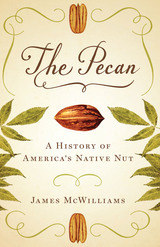 The Pecan: A History of America's Native Nut
By James McWilliams
University of Texas Press, 2013 What would Thanksgiving be without pecan pie? New Orleans without pecan pralines? Southern cooks would have to hang up their aprons without America’s native nut, whose popularity has spread far beyond the tree’s natural home. But as familiar as the pecan is, most people don’t know the fascinating story of how native pecan trees fed Americans for thousands of years until the nut was “improved” a little more than a century ago—and why that rapid domestication actually threatens the pecan’s long-term future. In The Pecan, acclaimed writer and historian James McWilliams explores the history of America’s most important commercial nut. He describes how essential the pecan was for Native Americans—by some calculations, an average pecan harvest had the food value of nearly 150,000 bison. McWilliams explains that, because of its natural edibility, abundance, and ease of harvesting, the pecan was left in its natural state longer than any other commercial fruit or nut crop in America. Yet once the process of “improvement” began, it took less than a century for the pecan to be almost totally domesticated. Today, more than 300 million pounds of pecans are produced every year in the United States—and as much as half of that total might be exported to China, which has fallen in love with America’s native nut. McWilliams also warns that, as ubiquitous as the pecan has become, it is vulnerable to a “perfect storm” of economic threats and ecological disasters that could wipe it out within a generation. This lively history suggests why the pecan deserves to be recognized as a true American heirloom.
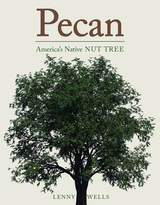 Pecan: America's Native Nut Tree
Lenny Wells
University of Alabama Press, 2017 Written in a manner suitable for a popular audience and including color photographs and recipes for some common uses of the nut, Pecan: America’s Native Nut Tree gathers scientific, historical, and anecdotal information to present a comprehensive view of the largely unknown story of the pecan.
From the first written record of it made by the Spaniard Cabeza de Vaca in 1528 to its nineteenth-century domestication and its current development into a multimillion dollar crop, the pecan tree has been broadly appreciated for its nutritious nuts and its beautiful wood. In Pecan: America’s Native Nut Tree, Lenny Wells explores the rich and fascinating story of one of North America’s few native crops, long an iconic staple of southern foods and landscapes.
Fueled largely by a booming international interest in the pecan, new discoveries about the remarkable health benefits of the nut, and a renewed enthusiasm for the crop in the United States, the pecan is currently experiencing a renaissance with the revitalization of America’s pecan industry. The crop’s transformation into a vital component of the US agricultural economy has taken many surprising and serendipitous twists along the way. Following the ravages of cotton farming, the pecan tree and its orchard ecosystem helped to heal the rural southern landscape. Today, pecan production offers a unique form of agriculture that can enhance biodiversity and protect the soil in a sustainable and productive manner.
Among the many colorful anecdotes that make the book fascinating reading are the story of André Pénicaut’s introduction of the pecan to Europe, the development of a Latin name based on historical descriptions of the same plant over time, the use of explosives in planting orchard trees, the accidental discovery of zinc as an important micronutrient, and the birth of “kudzu clubs” in the 1940s promoting the weed as a cover crop in pecan orchards.
**Published in cooperation with the Samuel Roberts Noble Foundation, Ellis Brothers Pecan, Inc., and The Mason Pecans Group**
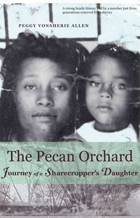 The Pecan Orchard: Journey of a Sharecropper's Daughter
Peggy Vonsherie Allen
University of Alabama Press, 2011 The true story of the struggle, survival, and ultimate success of a large black family in south Alabama who, in the middle decades of the 20th century, lifted themselves out of poverty to achieve the American dream of property ownership
This is a true story of the struggle, survival, and ultimate success of a large black family in south Alabama who, in the middle decades of the 20th century, lifted themselves out of poverty to achieve the American dream of property ownership. Descended from slaves and sharecroppers in the Black Belt region, this family of hard-working parents and their thirteen children is mentored by its matriarch, Moa, the author’s beloved great grandmother, who passes on to the family, along with other cultural wealth, her recipe for moonshine.
Without rancor or blame, and even with occasional humor, The Pecan Orchard offers a window into the inequities between blacks and whites in a small southern town still emerging from Jim Crow attitudes.
Told in clean, straightforward prose, the story radiates the suffocating midday heat of summertime cotton fields and the biting winter wind sifting through porous shanty walls. It conveys the implicit shame in “Colored Only” restrooms, drinking fountains, and eating areas; the beaming satisfaction of a job well done recognized by others; the “yessum” manners required of southern society; and the joyful moments, shared memories, and loving bonds that sustain—and even raise—a proud family.
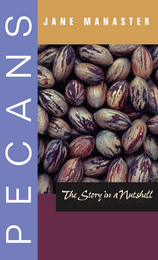 Pecans: The Story in a Nutshell
Jane Manaster
Texas Tech University Press, 2008 Travel just about anywhere in the southern United States, and you will find pecan trees. The “nut too hard to crack by hand”—the derivation of the pecan’s Algonquian name—is one of the most successful native agricultural crops of North America. So popular are pecans that Thomas Jefferson once wrote home from Paris for a supply, while many people today consider their holidays incomplete without a pecan pie. Jane Manaster’s Pecans, updated from its original 1994 publication, explores the natural history, cultivation, and uses of the pecan tree and nut. Her engaging account pieces together a fascinating mosaic of the peoples caught up in the pecan story—Native Americans, Spanish explorers, European immigrants and their American descendants, African Americans, and Mexican Americans. Manaster also describes the life cycle of the pecan tree, the development of many cultivated species, and predators and diseases of the pecan. She chronicles the successes of commercial growers in extending the pecan’s original range eastward from the Mississippi basin to Florida and westward to California; and she charts the growth of the commercial pecan industry, especially in Georgia, Texas, New Mexico, and Arizona. Not forgetting the pecan’s popularity in candy and baked goods, Manaster includes nearly two dozen traditional and modern recipes for such delights as pralines, candied and roasted pecans, pecan pie, and pecan logs. With such a wealth of information in so readable a format, Pecans will find a wide audience among pecan lovers and growers everywhere.
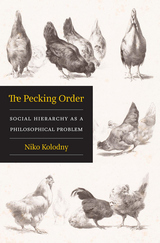 The Pecking Order: Social Hierarchy as a Philosophical Problem
Niko Kolodny
Harvard University Press, 2023 A trenchant case for a novel philosophical position: that our political thinking is driven less by commitments to freedom or fairness than by an aversion to hierarchy.
Niko Kolodny argues that, to a far greater extent than we recognize, our political thinking is driven by a concern to avoid relations of inferiority. In order to make sense of the most familiar ideas in our political thought and discourse—the justification of the state, democracy, and rule of law, as well as objections to paternalism and corruption—we cannot merely appeal to freedom, as libertarians do, or to distributive fairness, as liberals do. We must instead appeal directly to claims against inferiority—to the conviction that no one should stand above or below.
The problem of justifying the state, for example, is often billed as the problem of reconciling the state with the freedom of the individual. Yet, Kolodny argues, once we press hard enough on worries about the state’s encroachment on the individual, we end up in opposition not to unfreedom but to social hierarchy. To make his case, Kolodny takes inspiration from two recent trends in philosophical thought: on the one hand, the revival of the republican and Kantian traditions, with their focus on domination and dependence; on the other, relational egalitarianism, with its focus on the effects of the distribution of income and wealth on our social relations.
The Pecking Order offers a detailed account of relations of inferiority in terms of objectionable asymmetries of power, authority, and regard. Breaking new ground, Kolodny looks ahead to specific kinds of democratic institutions that could safeguard against such relations.
 Peckinpah: THE WESTERN FILMS--A RECONSIDERATION
Paul Seydor
University of Illinois Press, 1996 The book that re-established Peckinpah's reputation—now thoroughly revised and updated! When critics hailed the 1995 re-release of Sam Peckinpah's masterpiece, The Wild Bunch, it was a recognition of Paul Seydor's earlier claim that this was a milestone in American film, perhaps the most important since Citizen Kane.
Peckinpah: The Western Films first appeared in 1980, when the director's reputation was at low ebb. The book helped lead a generation of readers and filmgoers to a full and enduring appreciation of Peckinpah's landmark films, locating his work in the central tradition of American art that goes all the way back to Emerson, Hawthorne, and Melville. In addition to a new section on the personal significance of The Wild Bunch to Peckinpah, Seydor has added to this expanded, revised edition a complete account of the successful, but troubled, efforts to get a fully authorized director's cut released. He describes how an initial NC-17 rating of the film by the Motion Picture Association of America's ratings board nearly aborted the entire project. He also adds a great wealth of newly discovered biographical detail that has surfaced since the director's death and includes a new chapter on Noon Wine, credited with bringing Peckinpah's television work to a fitting resolution and preparing his way for The Wild Bunch.
This edition stands alone in offering full treatment of all versions of Peckinpah's Westerns. It also includes discussion of all fourteen episodes of Peckinpah's television series, The Westerner, and a full description of the versions of Pat Garrett and Billy the Kid now (or formerly) in circulation, including an argument that the label "director's cut" on the version in release by Turner is misleading. Additionally, the book's final chapter has been substantially rewritten and now includes new information about Peckinpah's background and sources.
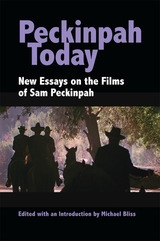 Peckinpah Today: New Essays on the Films of Sam Peckinpah
Edited by Michael Bliss
Southern Illinois University Press, 2012 Written exclusively for this collection by today’s leading Peckinpah critics, the nine essays in Peckinpah Today explore the body of work of one of America’s most important filmmakers, revealing new insights into his artistic process and the development of his lasting themes. Edited by Michael Bliss, this book provides groundbreaking criticism of Peckinpah’s work by illuminating new sources, from modified screenplay documents to interviews with screenplay writers and editors. Included is a rare interview with A. S. Fleischman, author of the screenplay for The Deadly Companions, the film that launched Peckinpah’s career in feature films. The collection also contains essays by scholar Stephen Prince and Paul Seydor, editor of the controversial special edition of Pat Garrett and Billy the Kid. In his essay on Straw Dogs, film critic Michael Sragow reveals how Peckinpah and co-scriptwriter David Zelag Goodman transformed a pulp novel into a powerful film. The final essay of the collection surveys Peckinpah’s career, showing the dark turn that the filmmaker’s artistic path took between his first and last films. This comprehensive approach reinforces the book’s dawn-to-dusk approach, resulting in a fascinating picture of a great filmmaker’s work.
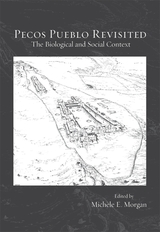 Pecos Pueblo Revisited: The Biological and Social Context
Michèle E. Morgan
Harvard University Press, 2010 Alfred V. Kidder’s excavations at Pecos Pueblo in New Mexico between 1914 and 1929 set a new standard for archaeological fieldwork and interpretation. Among his other innovations, Kidder recognized that skeletal remains were a valuable source of information, and today the Pecos sample is used in comparative studies of fossil hominins and recent populations alike.
In the 1990s, while documenting this historic collection in accordance with the Native American Graves Protection and Repatriation Act before the remains were returned to the Pueblo of Jemez and reinterred at Pecos Pueblo, Michèle E. Morgan and colleagues undertook a painstaking review of the field data to create a vastly improved database. The Peabody Museum, where the remains had been housed since the 1920s, also invited a team of experts to collaboratively study some of the materials.
In Pecos Pueblo Revisited, these scholars review some of the most significant findings from Pecos Pueblo in the context of current Southwestern archaeological and osteological perspectives and provide new interpretations of the behavior and biology of the inhabitants of the pueblo. The volume also presents improved data sets in extensive appendices that make the primary data available for future analysis. The volume answers many existing questions about the population of Pecos and other Rio Grande sites and will stimulate future analysis of this important collection.
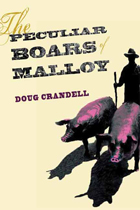 The Peculiar Boars of Malloy
Doug Crandell
Northern Illinois University Press, 2010
This Sherwood Anderson-award winning farcical novel follows two teenage boys living on a farm in rural Indiana. Their father—a diminutive man and the laughingstock of their small town—purchases two boars in an attempt to impress his neighbors and demonstrate, by proxy, his masculinity. The boars, however, turn out to be resolutely gay and deeply committed to each other, setting off a ridiculous chain of events that brings the spotlight and accompanying media circus to Malloy.
In the midst of all of the madness is the boys’ ongoing, and at once heartbreaking and hilarious, quest to find their wayward mother through a series of touching and humorous flashbacks. Disappointed in their pitiful father, the boys cling to an unrealistic fantasy of their mother, who is in actuality a promiscuous drifter.
Crandell’s depiction of the gay boars provides much of the book’s humor and, unexpectedly, its moral compass as he weaves significant and subtly articulated themes of animal rights and gay rights. The Peculiar Boars of Malloy captures the best traditions of American satire, while turning the conventions of the coming-of-age novel on its head. Crandell’s heart and humor will be appreciated by lovers of satire and animals and those readers possessed of a uniquely Midwestern sense of the ridiculous.
Peculiar Honor: A History of the 28th Texas Cavalry 1862-1865
Jane Johansson
University of Arkansas Press, 1998 This regimental history tells the story of the 28th Texas Cavalry (dismounted), a unit of Walker's Texas Division which campaigned throughout the Civil War in Arkansas, Louisiana and Texas. Part of the division known as "Walker's Greyhounds" because of their amazing mobility and stamina, the men of the 28th, helped preserve Texas from Federal invasion. 1997 Winner of the Ottis Lock Award for the Best Book on East Texas History
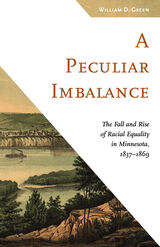 A Peculiar Imbalance: The Fall and Rise of Racial Equality in Minnesota, 1837–1869
William D. Green
University of Minnesota Press, 2015 A Peculiar Imbalance is the little-known history of the black experience in Minnesota in the mid-1800s, a time of dramatic change in the region. William D. Green explains how, as white progressive politicians pushed for statehood, black men who had been integrated members of the community, owning businesses and maintaining good relationships with their neighbors, found themselves denied the right to vote or to run for office in those same communities. As Minnesota was transformed from a wilderness territory to a state, the concepts of race and ethnicity and the distinctions among them made by Anglo-Americans grew more rigid and arbitrary. A black man might enjoy economic success and a middle-class lifestyle but was not considered a citizen under the law. In contrast, an Irish Catholic man was able to vote—as could a mixed-blood Indian—but might find himself struggling to build a business because of the ethnic and religious prejudices of the Anglo-American community. A Peculiar Imbalance examines these disparities, reflecting on the political, social, and legal experiences of black men from 1837 to 1869, the year of black suffrage.
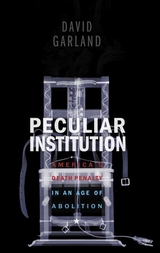 Peculiar Institution: America's Death Penalty in an Age of Abolition
David Garland
Harvard University Press, 2012 The U.S. death penalty is a peculiar institution, and a uniquely American one. Despite its comprehensive abolition elsewhere in the Western world, capital punishment continues in dozens of American states– a fact that is frequently discussed but rarely understood. The same puzzlement surrounds the peculiar form that American capital punishment now takes, with its uneven application, its seemingly endless delays, and the uncertainty of its ever being carried out in individual cases, none of which seem conducive to effective crime control or criminal justice. In a brilliantly provocative study, David Garland explains this tenacity and shows how death penalty practice has come to bear the distinctive hallmarks of America’s political institutions and cultural conflicts.
America’s radical federalism and local democracy, as well as its legacy of violence and racism, account for our divergence from the rest of the West. Whereas the elites of other nations were able to impose nationwide abolition from above despite public objections, American elites are unable– and unwilling– to end a punishment that has the support of local majorities and a storied place in popular culture.
In the course of hundreds of decisions, federal courts sought to rationalize and civilize an institution that too often resembled a lynching, producing layers of legal process but also delays and reversals. Yet the Supreme Court insists that the issue is to be decided by local political actors and public opinion. So the death penalty continues to respond to popular will, enhancing the power of criminal justice professionals, providing drama for the media, and bringing pleasure to a public audience who consumes its chilling tales.
Garland brings a new clarity to our understanding of this peculiar institution– and a new challenge to supporters and opponents alike.
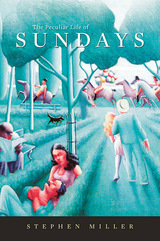 The Peculiar Life of Sundays
Stephen Miller
Harvard University Press, 2008 Sunday observance in the Christian West was an important religious issue from late Antiquity until at least the early twentieth century. In England the subject was debated in Parliament for six centuries. During the reign of Charles I disagreements about Sunday observance were a factor in the Puritan flight from England. In America the Sunday question loomed large in the nation’s newspapers. In the nineteenth century, it was the lengthiest of our national debates—outlasting those of temperance and slavery. In a more secular age, many writers have been haunted by the afterlife of Sunday. Wallace Stevens speaks of the “peculiar life of Sundays.” For Kris Kristofferson “there’s something in a Sunday, / Makes a body feel alone.”
From Augustine to Caesarius, through the Reformation and the Puritan flight from England, down through the ages to contemporary debates about Sunday worship, Stephen Miller explores the fascinating history of the Sabbath. He pays particular attention to the Sunday lives of a number of prominent British and American writers—and what they have had to say about Sunday. Miller examines such observant Christians as George Herbert, Samuel Johnson, Edmund Burke, Hannah More, and Jonathan Edwards. He also looks at the Sunday lives of non-practicing Christians, including Oliver Goldsmith, Joshua Reynolds, John Ruskin, and Robert Lowell, as well as a group of lapsed Christians, among them Edmund Gosse, Ralph Waldo Emerson, Henry Thoreau, and Wallace Stevens. Finally, he examines Walt Whitman’s complex relationship to Christianity. The result is a compelling study of the changing role of religion in Western culture.
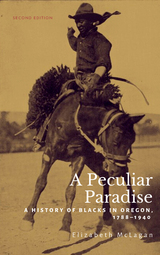 A Peculiar Paradise: A History of Blacks in Oregon, 1788-1940
Elizabeth McLagan
Oregon State University Press, 2022 Published in cooperation with Oregon Black Pioneers
A Peculiar Paradise: A History of Blacks in Oregon 1788–1940 remains the most comprehensive chronology of Black life in Oregon more than forty years after its original publication in 1980. The book has long been a resource for those seeking information on the legal and social barriers faced by people of African descent in Oregon. Elizabeth McLagan’s work reveals how in spite of those barriers, Black individuals and families made Oregon their home, and helped create the state’s modern Black communities. Long out of print, the book is available again through this co-publication with Oregon Black Pioneers, Oregon’s statewide African American historical society. The revised second edition includes additional details for students and scholars, an expanded reading list, a new selection of historic images, and a new foreword by Gwen Carr and an afterword by Elizabeth McLagan.
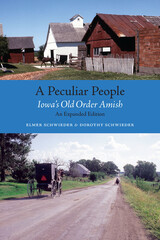 A Peculiar People: Iowa's Old Order Amish
Elmer Schwieder
University of Iowa Press, 1975 Now back in print with a new essay, this classic of Iowa history focuses on the Old Order Amish Mennonites, the state’s most distinctive religious minority. Sociologist Elmer Schwieder and historian Dorothy Schwieder began their research with the largest group of Old Order Amish in the state, the community near Kalona in Johnson and Washington counties, in April 1970; they extended their studies and friendships in later years to other Old Order settlements as well as the slightly less conservative Beachy Amish.
A Peculiar People explores the origin and growth of the Old Order Amish in Iowa, their religious practices, economic organization, family life, the formation of new communities, and the vital issue of education. Included also are appendixes giving the 1967 “Act Relating to Compulsory School Attendance and Educational Standards”; a sample “Church Organization Financial Agreement,” demonstrating the group’s unusual but advantageous mutual financial system; and the 1632 Dortrecht Confession of Faith, whose eighteen articles cover all the basic religious tenets of the Old Order Amish.
Thomas Morain’s new essay describes external and internal issues for the Iowa Amish from the 1970s to today. The growth of utopian Amish communities across the nation, changes in occupation (although The Amish Directory still lists buggy shop operators, wheelwrights, and one lone horse dentist), the current state of education and health care, and the conscious balance between modern and traditional ways are reflected in an essay that describes how the Old Order dedication to Gelassenheit—the yielding of self to the interests of the larger community—has served its members well into the twenty-first century.
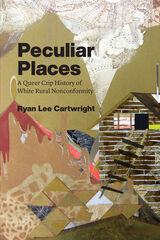 Peculiar Places: A Queer Crip History of White Rural Nonconformity
Ryan Lee Cartwright
University of Chicago Press, 2021 The queer recluse, the shambling farmer, the clannish hill folk—white rural populations have long disturbed the American imagination, alternately revered as moral, healthy, and hardworking, and feared as antisocial or socially uncouth. In Peculiar Places, Ryan Lee Cartwright examines the deep archive of these contrary formations, mapping racialized queer and disability histories of white social nonconformity across the rural twentieth-century United States.
Sensationalized accounts of white rural communities’ aberrant sexualities, racial intermingling, gender transgressions, and anomalous bodies and minds, which proliferated from the turn of the century, created a national view of the perversity of white rural poverty for the American public. Cartwright contends that these accounts, extracted and estranged from their own ambivalent forum of community gossip, must be read in kind: through a racialized, materialist queercrip optic of the deeply familiar and mundane. Taking in popular science, documentary photography, news media, documentaries, and horror films, Peculiar Places orients itself at the intersections of disability studies, queer studies, and gender studies to illuminate a racialized landscape both profoundly ordinary and familiar.
Peculiar Portrayals: Mormons on the Page, the Stage and the Screen
Mark T Decker
Utah State University Press, 2010 In a time when Mormons appear to have larger roles in everything from political conflict to television shows and when Mormon-related topics seem to show up more frequently in the news, eight scholars take a close look at Mormonism in popular media: film, television, theater, and books. Some contributors examine specific works, including the Tony-winning play Angels in America, the hit TV series Big Love, and the bestselling books Under the Banner of Heaven: A Story of Violent Faith and The Miracle Life of Edgar Mint. Others consider the phenomena of Mormon cinema and Mormon fiction; the use of the Mormon missionary as a stock character in films; and the noticeably prominent presence of Mormons in reality television shows.
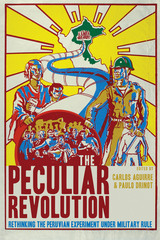 The Peculiar Revolution: Rethinking the Peruvian Experiment Under Military Rule
Edited by Carlos Aguirre and Paulo Drinot
University of Texas Press, 2017 On October 3, 1968, a military junta led by General Juan Velasco Alvarado took over the government of Peru. In striking contrast to the right-wing, pro–United States/anti-Communist military dictatorships of that era, however, Velasco’s “Revolutionary Government of the Armed Forces” set in motion a left-leaning nationalist project aimed at radically transforming Peruvian society by eliminating social injustice, breaking the cycle of foreign domination, redistributing land and wealth, and placing the destiny of Peruvians into their own hands. Although short-lived, the Velasco regime did indeed have a transformative effect on Peru, the meaning and legacy of which are still subjects of intense debate. The Peculiar Revolution revisits this fascinating and idiosyncratic period of Latin American history. The book is organized into three sections that examine the era’s cultural politics, including not just developments directed by the Velasco regime but also those that it engendered but did not necessarily control; its specific policies and key institutions; and the local and regional dimensions of the social reforms it promoted. In a series of innovative chapters written by both prominent and rising historians, this volume illuminates the cultural dimensions of the revolutionary project and its legacies, the impact of structural reforms at the local level (including previously understudied areas of the country such as Piura, Chimbote, and the Amazonia), and the effects of state policies on ordinary citizens and labor and peasant organizations.
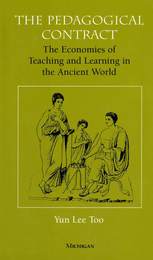 The Pedagogical Contract: The Economies of Teaching and Learning in the Ancient World
Yun Lee Too
University of Michigan Press, 2000 The Pedagogical Contract explores the relationship between teacher and student and argues for ways of reconceiving pedagogy. It discloses this relationship as one that since antiquity has been regarded as a scene of give-and-take, where the teacher exchanges knowledge for some sort of payment by the student and where pedagogy always runs the risk of becoming a broken contract. The book seeks to liberate teaching and learning from this historical scene and the anxieties that it engenders, arguing that there are alternative ways of conceiving the economy underlying pedagogical activities.
Reading ancient material together with contemporary representations of teaching and learning, Yun Lee Too shows that apart from being conceived as a scene of self-interest in which a professional teacher, or sophist, is the charlatan who cheats his pupil, pedagogy might also purport to be a disinterested process of socialization or a scene in which lack and neediness are redeemed through the realization that they are required precisely to stimulate the desire to learn. The author also argues that pedagogy ideally ignores the imperative of the conventional marketplace for relevance, utility, and productivity, inasmuch as teaching and learning most enrich a community when they disregard the immediate material concerns of the community.
The book will appeal to all those who understand scholarship as having an important social and/or political role to play; it will also be of interest to literary scholars, literary and cultural theorists, philosophers, historians, legal theorists, feminists, scholars of education, sociologists, and political theorists.
Yun Lee Too is Assistant Professor of Classics, Columbia University. She is the author of Rethinking Sexual Harassment;The Rhetoric of Identity in Socrates: Text, Power, Pedagogy; and The Idea of Ancient Literary Criticism, forthcoming; and coeditor, with Niall Livingstone, of Pedagogy and Power: Rhetorics of Classical Learning.
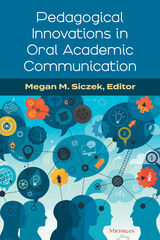 Pedagogical Innovations in Oral Academic Communication
Megan M. Siczek, Editor
University of Michigan Press, 2022 Oral communication is key to students’ classroom success and a skill that is highly valued in both academic and professional contexts, yet there are few resources for developing courses on oral academic communication. This edited collection gathers TESOL scholars and practitioners in exploring the theories, principles, and pedagogical practices that shape and help innovate the teaching of oral communication in higher education.
Pedagogical Innovations in Oral Academic Communication is grounded in four key principles: academic discourse socialization; context-responsive instruction; instructional approaches of English for Academic Purposes and English for Specific Purposes; and asset-oriented pedagogy. In the chapters in this collection, the authors share their teaching context, the details and underlying principles of their pedagogical approach, and recommendations for practitioners. Readers will develop a deeper understanding of the communicative contexts their students inhabit, including the types of speaking situations they are likely to encounter, and understand how to innovate their approach to teaching oral communication to students from diverse cultural, linguistic, educational, and disciplinary backgrounds. Such innovations prepare students for more effective communication during their academic studies and professional career, a goal that is of central importance in our globally interconnected society.
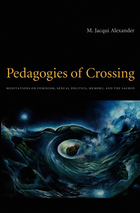 Pedagogies of Crossing: Meditations on Feminism, Sexual Politics, Memory, and the Sacred
M. Jacqui Alexander
Duke University Press, 2005 M. Jacqui Alexander is one of the most important theorists of transnational feminism working today. Pedagogies of Crossing brings together essays she has written over the past decade, uniting her incisive critiques, which have had such a profound impact on feminist, queer, and critical race theories, with some of her more recent work. In this landmark interdisciplinary volume, Alexander points to a number of critical imperatives made all the more urgent by contemporary manifestations of neoimperialism and neocolonialism. Among these are the need for North American feminism and queer studies to take up transnational frameworks that foreground questions of colonialism, political economy, and racial formation; for a thorough re-conceptualization of modernity to account for the heteronormative regulatory practices of modern state formations; and for feminists to wrestle with the spiritual dimensions of experience and the meaning of sacred subjectivity. In these meditations, Alexander deftly unites large, often contradictory, historical processes across time and space. She focuses on the criminalization of queer communities in both the United States and the Caribbean in ways that prompt us to rethink how modernity invents its own traditions; she juxtaposes the political organizing and consciousness of women workers in global factories in Mexico, the Caribbean, and Canada with the pressing need for those in the academic factory to teach for social justice; she reflects on the limits and failures of liberal pluralism; and she presents original and compelling arguments that show how and why transgenerational memory is an indispensable spiritual practice within differently constituted women-of-color communities as it operates as a powerful antidote to oppression. In this multifaceted, visionary book, Alexander maps the terrain of alternative histories and offers new forms of knowledge with which to mold alternative futures.
 Pedagogies of Interconnectedness: Feminist-Queer Collaborative Transformation
Edited by Isis Nusair and Barbara Shaw
University of Illinois Press, 2025 A generation of scholar-teacher-activists have moved beyond collaborating in theory to embodying, engaging in, and sharing how they practice their pedagogy. Isis Nusair and Barbara L. Shaw edit essays that link feminist, queer, anti-racist, decolonial, and disability theory and practice while using intersectional, transnational, and interdisciplinary approaches to explore how the personal remains political. The contributors describe ways of building communities within and beyond academic programs and examine what it means to engage in community-building work and action across institutional boundaries. In Part One, the essayists focus on the centrality of community building and reinterpreting bodies of knowledge with students, staff, faculty, and community members. Part Two looks at bringing transnational approaches to feminist collaborations in ways that challenge the classroom’s central place in knowledge production. Part Three explores organic collaborations in and beyond the classroom. A practical and much-needed resource, Pedagogies of Interconnectedness offers cutting-edge ideas for collaboration in pedagogy, education justice, community-based activities, and liberatory worldmaking. Contributors: Jordyn Alderman, Leen Al-Fatafta, Meryl Altman, María Claudia André, Andrea N. Baldwin, Carolyn Beer, Luisa Bieri, Rebecca Dawson, Misty De Berry, Danielle M. DeMuth, Emily Fairchild, Sara Youngblood Gregory, Letizia Guglielmo, Jeremy Hall, K. Melchor Hall, Linh U. Hua, Christine Keating, Charlotte Meehan, Brayden Milam, Isis Nusair, Montserrat Pérez-Toribio, Andrea Putala, Ariella Rotramel, Ann Russo, Kimberly Sanchez, Barbara L. Shaw, M. Gabriela Torres, Ayana K. Weekley, and Sharon R. Wesoky
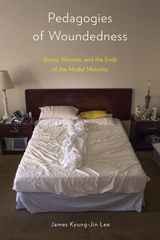 Pedagogies of Woundedness: Illness, Memoir, and the Ends of the Model Minority
James Kyung-Jin Lee
Temple University Press, 2022 The pressures Asian Americans feel to be socially and economically exceptional include an unspoken mandate to always be healthy. Nowhere is this more evident than in the expectation for Asian Americans to enter the field of medicine, principally as providers of care rather than those who require care. Pedagogies of Woundedness explores what happens when those considered model minorities critically engage with illness and medicine whether as patients or physicians. James Kyung-Jin Lee considers how popular culture often positions Asian Americans as medical authorities and what that racial characterization means. Addressing the recent trend of writing about sickness, disability, and death, Lee shows how this investment in Asian American health via the model minority is itself a response to older racial forms that characterize Asian American bodies as diseased. Moreover, he pays attention to what happens when academics get sick and how illness becomes both methodology and an archive for scholars. Pedagogies of Woundedness also explores the limits of biomedical “care,” the rise of physician chaplaincy, and the impact of COVID. Throughout his book and these case studies, Lee shows the social, ethical, and political consequences of these common (mis)conceptions that often define Asian Americans in regard to health and illness.
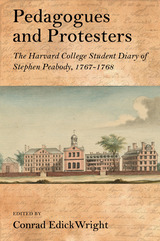 Pedagogues and Protesters: The Harvard College Student Diary of Stephen Peabody, 1767-1768
Conrad Edick Wright
University of Massachusetts Press, 2017 On April 4, 1768, about one hundred angry Harvard College undergraduates, well over half the student body, left school and went home, in protest against new rules about class preparation. Their action constituted the largest student strike at any colonial American college. Many contemporaries found the cause trivial and the students' decision inexplicable, but in the undergraduates' own minds it was the culmination of months of tensions with the faculty.
Pedagogues and Protesters recounts the year in daily journal entries by Stephen Peabody, a member of the class of 1769. The best surviving account of colonial college life, Peabody's journal documents relationships among students, faculty members, and administrators, as well as the author's relationships with other segments of Massachusetts society. To a full transcription of the entries, Conrad Edick Wright adds detailed annotation and an introduction that focuses on the journal's revealing account of daily life at America's oldest college.
Published in association with Massachusetts Historical Society
Pedagogy: Disturbing History 1819-1929
Mariolina Rizzi Salvatori
University of Pittsburgh Press, 2003 Mariolina Salvatori presents an anthology of documents that examine the evolution of American education in the nineteenth century and meaning of the word pedagogy.
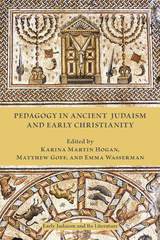 Pedagogy in Ancient Judaism and Early Christianity
Karina Martin Hogan
SBL Press, 2017 Engage fourteen essays from an international group of experts
There is little direct evidence for formal education in the Bible and in the texts of Second Temple Judaism and early Christianity. At the same time, pedagogy and character formation are important themes in many of these texts. This book explores the pedagogical purpose of wisdom literature, in which the concept of discipline (Hebrew musar) is closely tied to the acquisition of wisdom. It examines how and why the concept of musar came to be translated as paideia (education, enculturation) in the Greek translation of the Hebrew Bible (Septuagint), and how the concept of paideia was deployed by ancient Jewish authors writing in Greek. The different understandings of paideia in wisdom and apocalyptic writings of Second Temple Judaism are this book's primary focus. It also examines how early Christians adapted the concept of paideia, influenced by both the Septuagint and Greco-Roman understandings of this concept.
Features
A thorough lexical study of the term paideia in the Septuagint
Exploration of the relationship of wisdom and Torah in Second Temple Judaism
Examination of how Christians developed new forms of pedagogy in competition with Jewish and pagan systems of education
Pedagogy of Democracy: Feminism and the Cold War in the U.S. Occupation of Japan
Mire Koikari
Temple University Press, 2009 Pedagogy of Democracy re-interprets the U.S. occupation of Japan from 1945 to 1952 as a problematic instance of Cold War feminist mobilization rather than a successful democratization of Japanese women as previously argued. By combining three fields of research—occupation, Cold War, and postcolonial feminist studies—and examining occupation records and other archival sources, Koikari argues that postwar gender reform was one of the Cold War containment strategies that undermined rather than promoted women’s political and economic rights.
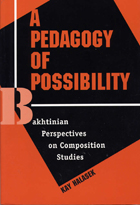 A Pedagogy of Possibility: Bakhtinian Perspectives on Composition Studies
Kay Halasek
Southern Illinois University Press, 1999 In a book that itself exemplifies the dialogic scholarship it proposes, Kay Halasek reconceives composition studies from a Bakhtinian perspective, focusing on both the discipline's theoretical assumptions and its pedagogies. Framing her discussions at every level of the discipline—theoretical, historical, pedagogical—Halasek provides an overview of portions of the Bakhtinian canon relevant to composition studies, explores the implications of Mikhail Bakhtin's work in the teaching of writing and for current debates about the role of theory in composition studies, and provides a model of scholarship that strives to maintain dialogic balance between practice and theory, between composition studies and Bakhtinian thought. Halasek's study ranges broadly across the field of composition, painting in wide strokes a new picture of the discipline, focusing on the finer details of the rhetorical situation, and teasing out the implications of Bakhtinian thought for classroom practice by examining the nature of critical reading and writing, the efficacy and ethics of academic discourse, student resistance, and critical and conflict pedagogy. The book ends by setting out a pedagogy of possibility, what Halasek terms elsewhere a "post-critical pedagogy" that redefines and redirects current discussions of home versus academic literacies and discourses.
The Pedagogy of Wisdom: An Interpretation of Plato's Theaetetus
Gregory Kirk
Northwestern University Press, 2015 In this interpretive commentary on Theaetetus, Gregory Kirk makes a major contribution to scholarship on Plato by emphasizing the relevance of the interpersonal dynamics between the interlocutors for the interpretation of the dialogue’s central arguments about knowledge. Kirk attends closely to the personalities of the participants in the dialogue, focusing especially on the unique demands faced by a student—in this case, Theaetetus—and the ways in which one can embrace or deflect the responsibilities of learning. Kirk’s approach gives equal consideration to the dual demands of dramatic interpretation and philosophical argument that constitute the unique character of the Platonic text, and he develops an original interpretation of the Theaetetus, concluding that the uncertainty that characterizes wisdom supersedes the certainty of knowledge.
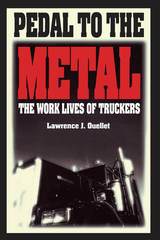 Pedal To The Metal: The Work Life of Truckers
Lawrence J. Ouellet
Temple University Press, 1994 From this experience, Lawrence J. Ouellet has the advantage of a rare perspective and a profound understanding of the two fundamental questions he asks in this book: Why do truck drivers work so hard even when it doesn't result in more money or other material gains? and How do truckers make sense of their behavior to themselves and to the outside world?
A vivid ethnography of trucking culture, Pedal to the Metal documents and analyzes truckers' lives and work ethic, exploring the range of identities truckers create for themselves—the renegade cowboy, the company man, the voyeur, the lone king of the road. To explain truckers' motivations, Ouellet examines the meaning of work and the motivation for excelling despite long, unsupervised hours on the road. He finds that their occupational pride results in extraordinary efforts on the job and, subsequently, a positive sense of self. Driving skill allows truckers to improve their hauling times, which they proudly track to the minute, and to increase their productivity and income.
Truckers' knowledge of the industry's structure and the idiosyncrasies of their own company allows them to improve their ability to get and carry out assignments, to maneuver around a traditional concept of rank and seniority, and to recreate to their advantage the pervasive cultural myths that the public expects should dictate a trucker's behavior. Whether capturing the pleasure and enchantment of trucking—driving under moon-lit skies across a snow-covered mountain range—or the miseries of boredom, bad weather, and exhausting schedules, Ouellet exhibits deep appreciation and passion for his subject.
Pedaling Resistance: Sympathy, Subversion, and Vegan Cycling
Carol J. Adams
University of Arkansas Press, 2024 Vegans and cyclists are often outsiders, negotiating food systems and built environments that tend to prioritize omnivores and motor vehicles by default. Pedaling Resistance: Sympathy, Subversion, and Vegan Cycling examines the relationship between veganism and cycling through the journeys, experiences, and reflections of a dozen vegan cyclists from the United States and beyond.
The essays in this collection explore the unity between cycling for health, work, competition, transport, and joy, and the issues of animal suffering, environmentalism, and speciesism inherent in veganism—all through lenses of class, race, gender, and disability. Pedaling Resistance illuminates themes of everyday resistance and boundary crossing to uncover the greater social and political issues that underlie the decisions to give up animal products and choose cycling over driving.
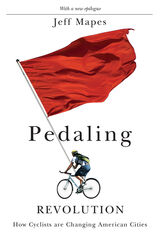 Pedaling Revolution: How Cyclists Are Changing American Cities
Jeff Mapes
Oregon State University Press, 2009 Updated Edition includes a new epilogue by the author In a world of increasing traffic congestion, a grassroots movement is carving out a niche for bicycles on city streets. Pedaling Revolution explores the growing bike culture that is changing the look and feel of cities, suburbs, and small towns across North America. From traffic-dodging bike messengers to tattooed teenagers on battered bikes, from riders in spandex to well-dressed executives, ordinary citizens are becoming transportation revolutionaries. Jeff Mapes traces the growth of bicycle advocacy and explores the environmental, safety, and health aspects of bicycling. He rides with bicycle advocates who are taming the streets of New York City, joins the street circus that is Critical Mass in San Francisco, and gets inspired by the every-day folk pedaling in Amsterdam, the nirvana of American bike activists. Chapters focused on big cities, college towns, and America’s most successful bike city, Portland, show how cyclists, with the encouragement of local officials, are claiming a share of the valuable streetscape.
“A growing number of Americans, mounted on their bicycles like some new kind of urban cowboy, are mixing it up with swift, two-ton motor vehicles as they create a new society on the streets. They’re finding physical fitness, low-cost transportation, environmental purity—and, still all too often, Wild West risks of sudden death or injury.” —from the introduction
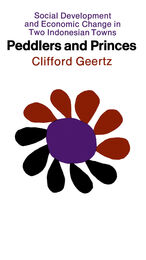 Peddlers and Princes: Social Development and Economic Change in Two Indonesian Towns
Clifford Geertz
University of Chicago Press, 1968 In a closely observed study of two Indonesian towns, Clifford Geertz analyzes the process of economic change in terms of people and behavior patterns rather than income and production. One of the rare empirical studies of the earliest stages of the transition to modern economic growth, Peddlers and Princes offers important facts and generalizations for the economist, the sociologist, and the South East Asia specialist.
"Peddlers and Princes is, like much of Geertz's other writing, eminently rewarding . . . Case study and broader theory are brought together in an illuminating marriage."—Donald Hindley, Annals of The American Academy of Political and Social Science
"What makes the book fascinating is the author's capacity to relate his anthropological findings to questions of central concern to the economist . . . "—H. G. Johnson, Journal of Political Economy
 Pedestales vacíos: Monumentos, memoriales y escultura pública en México
José Esparza Chong Cuy
Harvard University Press Empty Plinths: Monuments, Memorials, and Public Sculpture in Mexico responds to the unfolding political debate around one of the most significant public monuments in North America, Mexico City’s monument of Christopher Columbus on Avenida Paseo de la Reforma. In convening a diverse collective of voices around the question of the monument’s future, editors José Esparza Chong Cuy and Guillermo Ruiz de Teresa probe the unstable narratives behind a selection of monuments, memorials, and public sculptures in Mexico City, and propose a new charter that informs future public art commissions in Mexico and beyond. At a moment when many such structures have become highly visible sites of protest throughout the world, this new compilation of essays, interviews, artistic contributions, and public policy proposals reveals and reframes the histories embedded within contested public spaces in Mexico.
Empty Plinths is published alongside a series of artist commissions organized together with several major cultural institutions in Mexico City, including the Museo Tamayo, the Museo de Arte Moderno, and the Museo Experimental el Eco.
 Pediatric Psychiatry
Hale F. Shirley
Harvard University Press Geared to the needs of the pediatrician, this book is designed to orient him to the background of psychiatric knowledge so essential in his daily practice. Using his observation of 1,000 children brought to the Stanford University Pediatric-Psychiatric Unit as a guide, Dr. Shirley illustrates his discussion of physical, mental, and emotional disturbances with case histories, thus presenting the relationships between physician and parent, and physician and child in dynamic form, and stressing the individual nature of each case.
Yet, despite the unique character of each behavior problem, there are common denominators in childhood development. Dr. Shirley sets forth the generally accepted norms of physical and mental growth and evaluates the usefulness of psychometric procedures, such as intelligence and performance tests, in determining the limits of the child's intellectual and physical capacities. Grade placement, discipline, eating and sleeping are universal trouble spots. Dr. Shirley suggests specific leads for the pediatrician to follow in the treatment of these problems, cautioning that success depends upon relieving parents of anxiety concerning themselves and their children in order that an atmosphere conducive to cooperation may exist in the home.
Dr. Shirley's experience and training in both pediatrics and psychiatry doubly qualify him to discuss the basic elements of child psychiatry with authority and insight. Parents as well as physicians can profit by Dr. Shirley's wise, articulate, and practical interpretation of psychological concepts as they relate to the prevention and treatment of behavior problems in children.
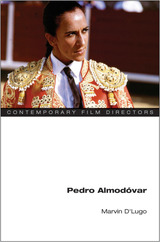 Pedro Almodóvar
Marvin D’Lugo
University of Illinois Press, 2006 Perhaps the best-known Spanish filmmaker to international audiences, Pedro Almodóvar gained the widespread attention of English-speaking critics and fans with the Oscar-nominated Women on the Verge of a Nervous Breakdown and the celebrated dark comedy Tie Me Up! Tie Me Down!. Marvin D'Lugo offers a concise, informed, and insightful commentary on a preeminent force in modern cinema. D'Lugo follows Almodóvar's career chronologically, tracing the director's works and their increasing complexity in terms of theme and the Spanish film tradition. Drawing on a wide range of critical sources, D'Lugo explores Almodóvar's use of melodrama and Hollywood genre film, his self-invention as a filmmaker, and his on-screen sexual politics. D'Lugo also discusses what he calls "geocultural positioning," that is, Almodóvar's paradoxical ability to use his marginal positions—in terms of his class, geographical origin, and identity—to develop an expressive language that is emotionally recognizable by audiences worldwide. Two fascinating interviews with the director round out the volume. An exciting consideration of an arthouse giant, Pedro Almodóvar mixes original interpretations into an analysis sure to reward film students and specialists alike.
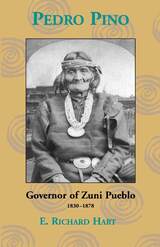 Pedro Pino: Governor of Zuni Pueblo, 1830-1878
E. Richard Hart
Utah State University Press, 2003 Pedro Pino, or Lai-iu-ah-tsai-lu (his Zuni name) was for many years the most important Zuni political leader. He served during a period of tremendous change and challenges for his people. Born in 1788, captured by Navajos in his teens, he was sold into a New Mexican household, where he obtained his Spanish name. When he returned to Zuni, he spoke three languages and brought with him a wealth of knowledge regarding the world outside the pueblo. For decades he ably conducted Zuni foreign relations, defending the pueblo's sovereignty and lands, establishing trade relationships, interacting with foreigners-from prominent military and scientific expeditions to common emigrants-and documenting all in a remarkable archive. Steeped in Zuni traditions, he was known among other things for his diplomatic savvy, as a great warrior, for his oratory, and for his honesty and hospitality. More than a biography, Richard Hart's work provides a history of Zuni during an especially significant period. Also the author of Zuni and the Courts: A Struggle for Sovereign
Land Rights and the co-author of A Zuni Atlas, Hart originally wrote the manuscript in 1979 after a decade of historical work for Zuni Pueblo. He then set it aside but continued to pursue research about and for Zuni. Its publication, at last, inscribes an important contribution to Pueblo history and biography and a testimonial to a remarkable Native American leader. In an afterword written for this publication, Hart discusses his original intentions in writing about Pedro Pino and Zuni and situates the biography in relation to current scholarship.
 Pedro Reyes: Ad Usum / To Be Used
José Luis Falconi
Harvard University Press For more than a decade the Mexico City–based artist, architect, and cultural agent Pedro Reyes has been turning existing social problems into opportunities for effecting tangible change through collective imagination. By breaking open failed models and retooling them with space to project alternatives, Reyes’s art enables productive diversions of otherwise destructive forces. Ad Usum: To Be Used is the second volume in the series Focus on Latin American Art and Agency, which is dedicated to contemporary cultural agents, a term that is perhaps best understood through the words of Reyes himself: “changing our individual habits has no degree of effectiveness” as “progress is only significant if you start to multiply by 10, by 100, by 1,000.” Rather than merely illustrate his work, this collection of images, interviews, and critical essays is intended as an apparatus for multiplying the possibilities when art becomes a resource for the common good.
This full-color illustrated survey of Reyes’s projects includes critical essays by José Luis Falconi, Robin Greeley, Johan Hartle, Adam Kleinman, and Doris Sommer, as well as interviews between the artist and such seminal thinkers as Lauren Berlant, Michael Hardt, Alejandro Jodorowsky, and Antanas Mockus.
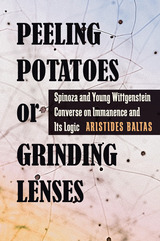 Peeling Potatoes or Grinding Lenses: Spinoza and Young Wittgenstein Converse on Immanence and Its Logic
Aristides Baltas
University of Pittsburgh Press, 2012
“I can work best now while peeling potatoes. . . . It is for me what lens-grinding was for Spinoza.”—L. Wittgenstein
More than 250 years separate the publication of Baruch Spinoza’s Ethics and Ludwig Wittgenstein’s Tractatus Logico-Philosophicus. Both are considered monumental philosophical treatises, produced during markedly different times in human history, and notoriously challenging to interpret. In Peeling Potatoes or Grinding Lenses, Aristides Baltas contends that these works bear a striking similarity based on the idea of “radical immanence.” Each purports to understand the world, thought, and language from the inside and in a way leading to the dissolution of all philosophy. In that guise, both offer a powerful argument against fundamentalism of all sorts and kinds.
To Spinoza, God is just Nature. God is not above or separate from the world, humanity, or mere objects for, as Nature, He inheres in everything. To Wittgenstein, logic is not above or separate from language, thought, and the world. The hardness of the logical “must” inheres in states of affairs, facts, thoughts, and linguistic acts. Outside there are no truths or sense—only nonsense.
Through close readings of the texts based on lessons drawn from radical paradigm change in science, Baltas finds in both works a single-minded purpose, implacable reasoning, and an austerity of style that are rare in the history of philosophy. He analyzes the structure and content of each treatise, the authors’ intentions, the limitations and possibilities afforded by scientific discovery in their respective eras, their radical opposition to prevailing philosophical views, and draws out the particulars, as well as the implications, of the arresting match between the two.
Peer Gynt
Henrik Ibsen
University of Minnesota Press, 1980
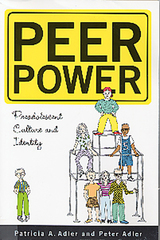 Peer Power: Preadolescent Culture and Identity
Adler, Peter
Rutgers University Press, 1998 Peer Power seeks to explode existing myths about children's friendships, power and popularity, and the gender chasm between elementary school boys and girls. Based on eight years of intensive insider participant observation in their own children's community, Peter and Patti Adler discuss the vital components of the lives of preadolescents, popularity, friendships, cliques, social status, social isolation, loyalty, bullying, boy-girl relationships, and afterschool activities. They describe how friendships shift and change, how people are drawn into groups and excluded from them, how clique leaders maintain their power and popularity, and how individuals' social experiences and feelings about themselves differ from the top of the pecking order to the bottom. In so doing, the Adlers focus their attention on the peer culture of the children themselves and the way this culture extracts and modifies elements from adult culture. Children's peer culture, as it is nourished in those spaces where grown ups cannot penetrate, stands between individual children and the larger adult society. As such, it is a mediator and shaper, influencing the way children collectively interpret their surroundings and deal with the common problems they face.
The Adlers explore some of the patterns that develop in this social space, noting both the differences in boys' and girls' gendered cultures and the overlap in many social dynamics, afterschool activities, role behaviour, romantic inclinations and social stratification. For example, children's participation in adult-organized afterschool activities - a now-prominent feature of many American children's social experience - has profound implications for their socialization and development, moving them away from the negotiated, spontaneous character of play into the formal systems of adult norms and values at ever-younger ages. When they retreat from adults, however, they still display distinctive peer group dynamics, forging strong ingroup/outgroup differentiation, loyalty and identification. Peer culture thus contains informal social mechanisms through which children create their social order, determine their place and identity, and develop positive and negative feelings about themselves. Studying children's peer culture is thus valuable as it reveals not only how this subculture parallels the adult world but also how it differs from it.
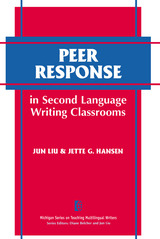 Peer Response in Second Language Writing Classrooms
Jun Liu and Jette G. Hansen
University of Michigan Press, 2002 Peer response in which students work together to provide feedback on one another's writing in both written and oral formats through active engagement with each other's progress over multiple drafts, has been discussed in L2 writing literature since the early 1980s. While peer response activities have now become a common feature of L2 writing instruction, much of the research in peer response studies presents conflicting data. There is a need for a comprehensive survey of it in an effort to help teachers sort out what may or may not be useful to them in the classroom. Peer Response in Second Language Writing Classrooms was written to fill that void.
Peer Response in Second Language Writing Classrooms will provide teachers with practical guidelines for making peer response effective in the classroom and will offer a theoretical grounding on the purposes and importance of peer review, or feedback, as it relates to current writing instruction pedagogy.
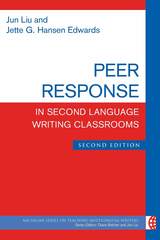 Peer Response in Second Language Writing Classrooms, Second Edition
Jun Liu and Jette G. Hansen Edwards
University of Michigan Press, 2018 Since the publication of the first edition in 2002, there have been two major developments in L2 writing and peer response teaching and research. The first is the increased interest in CALL and computer-mediated communication (CMC) for L2 pedagogy; the second is the accessibility and viability of research on L2 peer response from all over the world. Both developments are thoroughly addressed in this new edition.
Now that classes are as likely to be online as held in physical classrooms and now that a new generation of digital natives can routinely read and respond to what others write via laptops, tablets, and phones, peer response as pedagogical practice is not just more easily implemented, but it is more likely to feel natural to L2 learners.
The Second Edition is a highly accessible guide to how the world is using peer response and serves as a motivator and facilitator for those who want to try it for the first time or want to increase the effectiveness of the activities—whether via CMC or not. The volume includes 11 forms useful in training students to provide good peer feedback, including a final checklist to ensure teachers have taken all the necessary steps to achieve a successful peer feedback activity.
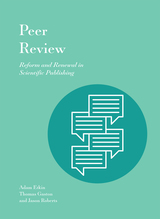 Peer Review: Reform and Renewal in Scientific Publishing
Adam Etkin, Thomas Gaston, and Jason Roberts
Against the Grain, LLC, 2017 Charleston Briefings: Trending Topics for Information Professionals is a thought-provoking series of brief books concerning innovation in the sphere of libraries, publishing, and technology in scholarly communication. The briefings, growing out of the vital conversations characteristic of the Charleston Conference and Against the Grain, will offer valuable insights into the trends shaping our professional lives and the institutions in which we work.
The Charleston Briefings are written by authorities who provide an effective, readable overview of their topics—not an academic monograph. The intended audience is busy nonspecialist readers who want to be informed concerning important issues in our industry in an accessible and timely manner.
Peer review is an essential aspect of scientific publishing. Yet, how familiar are most of us with the process of peer review? How long has peer review been considered a cornerstone of scientific publishing and what is it meant to accomplish? With so many changes in the realm of scholarly communication in the last twenty years, has the status of peer review also been challenged? Is peer review obsolete? These questions are fundamental to Peer Review: Reform and Renewal in Scientific Publishing. Publishers, researchers, librarians, vendors in the information sphere, and those who are passionate about science will all find much to interest them in this work.
Peer to Peer: The Commons Manifesto
Michel Bauwens, Vasilis Kostakis and Alex Pazaitis
University of Westminster Press, 2019 Not since Marx identified the manufacturing plants of Manchester as the blueprint for the new capitalist society has there been a more profound transformation of the fundamentals of our social life. As capitalism faces a series of structural crises, a new social, political and economic dynamic is emerging: peer to peer. What is peer to peer? Why is it essential for building a commons-centric future? How could this happen? These are the questions this book tries to answer. Peer to peer is a type of social relations in human networks, as well as a technological infrastructure that makes the generalization and scaling up of such relations possible. Thus, peer to peer enables a new mode of production and creates the potential for a transition to a commons-oriented economy.
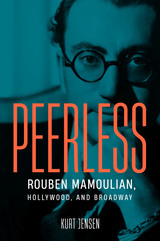 Peerless: Rouben Mamoulian, Hollywood, and Broadway
Kurt Jensen
University of Wisconsin Press, 2024 A proud Armenian who claimed a distant link to nobility, born in what was then part of czarist Russia, Rouben Mamoulian (1897–1987) was one of the most astonishing and confounding figures in American film and theater, directing the original stage productions of Porgy and Bess, Carousel, and Oklahoma!, as well as films including Love Me Tonight, Queen Christina, City Streets, and Silk Stockings. He was famously fired from the film version of Porgy and Bess in a dispute over publicity and quit Cleopatra after arguments over a single scene. Mamoulian’s mercurial confidence and autocratic tendencies were among the reasons he had a reputation for being uncompromising. This frustrating mix of genius and stubbornness, of critical successes and financial flops, has proven challenging for biographers.
Kurt Jensen’s magisterial volume, extensively researched and filled with trenchant observations, brings to life this charming, flawed, and fascinating man—and demonstrates how the wellspring of his art contained the seeds of his own destruction. Drawing upon Mamoulian’s unfinished memoir and voluminous diaries, as well as interviews with the director’s surviving collaborators, Jensen delivers fresh and informative insider stories from seminal productions. Meanwhile, he explores Mamoulian’s aesthetic principles and strategies as manifested in lighting, choreography, and sound design. A tour de force, Peerless offers readers a multifaceted, in-depth look at an idiosyncratic genius.
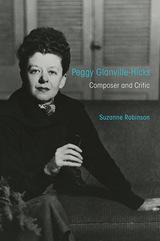 Peggy Glanville-Hicks: Composer and Critic
Suzanne Robinson
University of Illinois Press, 2019 As both composer and critic, Peggy Glanville-Hicks contributed to the astonishing cultural ferment of the mid-twentieth century. Her forceful voice as a writer and commentator helped shape professional and public opinion on the state of American composing. The seventy musical works she composed ranged from celebrated operas like Nausicaa to intimate, jewel-like compositions created for friends. Her circle included figures like Virgil Thomson, Paul Bowles, John Cage, and Yehudi Menuhin. Drawing on interviews, archival research, and fifty-four years of extraordinary pocket diaries, Suzanne Robinson places Glanville-Hicks within the history of American music and composers. "P.G.H." forged alliances with power brokers and artists that gained her entrance to core American cultural entities such as the League of Composers, New York Herald Tribune, and the Harkness Ballet. Yet her impeccably cultivated public image concealed a private life marked by unhappy love affairs, stubborn poverty, and the painstaking creation of her artistic works. Evocative and intricate, Peggy Glanville-Hicks clears away decades of myth and storytelling to provide a portrait of a remarkable figure and her times.
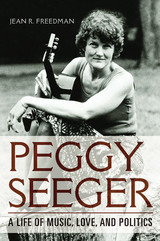 Peggy Seeger: A Life of Music, Love, and Politics
Jean R. Freedman
University of Illinois Press, 2020 Born into folk music's first family, Peggy Seeger has blazed her own trail artistically and personally. Jean Freedman draws on a wealth of research and conversations with Seeger to tell the life story of one of music's most charismatic performers and tireless advocates. Here is the story of Seeger's multifaceted career, from her youth to her pivotal role in the American and British folk revivals, from her instrumental virtuosity to her tireless work on behalf of environmental and feminist causes, from wry reflections on the U.K. folk scene to decades as a songwriter. Freedman also delves into Seeger's fruitful partnership with Ewan MacColl and a multitude of contributions which include creating the renowned Festivals of Fools, founding Blackthorne Records, masterminding the legendary Radio Ballads documentaries, and mentoring performers in the often-fraught atmosphere of The Critics Group. Bracingly candid and as passionate as its subject, Peggy Seeger is the first book-length biography of a life set to music.
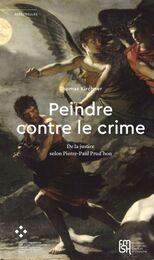 Peindre contre le crime
Thomas Kirchner
Diaphanes, 2020 Peint en 1808 pour une salle d’audience du Palais de Justice de Paris, le tableau de Pierre-Paul Prud’hon La Justice et la Vengeance divine poursuivant le Crime a toujours été considéré comme un chef-d’œuvre du romantisme français, mais rarement étudié sous l’angle de l’histoire du droit pénal. Pourtant, les débats contemporains autour de la question du libre arbitre jouèrent un rôle fondamental dans le choix de son iconographie. Selon la conception invoquée par Prud’hon, l’homme agissant librement est pleinement responsable de ses actes, y compris de ses crimes, responsabilité qui confère au législateur le droit moral de fixer des sanctions, même sévères. Les réflexions d’Emmanuel Kant revêtent dans ce contexte une importance majeure. Prud’hon en eut probablement connaissance par l’intermédiaire du commanditaire du tableau, le préfet du département de la Seine Nicolas-Thérèse-Benoît Frochot, auquel est attribuée ici la paternité du programme iconographique. À travers la présente monographie, Thomas Kirchner montre combien cette célèbre peinture est l’exact reflet des discussions juridiques et philosophiques qui animèrent la France révolutionnaire, et donnèrent naissance au nouveau Code pénal et à un nouveau Code d’instruction criminelle.
Peirce's Scientific Metaphysics: The Philosophy of Chance, Law, and Evolution
Andrew Reynolds
Vanderbilt University Press, 2002 Peirce's Scientific Metaphysics is the first book devoted to understanding Charles Sanders Peirce's (1839-1914) metaphysics from the perspective of the scientific questions that motivated his thinking. While offering a detailed account of the scientific ideas and theories essential for understanding Peirce's metaphysical system, this book is written in a manner accessible to the non-specialist.
 Peiresc’s Mediterranean World
Peter N. Miller
Harvard University Press, 2015 Antiquarian, lawyer, and cat lover Nicolas Fabri de Peiresc (1580–1637) was a “prince” of the Republic of Letters and the most gifted French intellectual in the generation between Montaigne and Descartes. From Peiresc’s study in Aix-en-Provence, his insatiable curiosity poured forth in thousands of letters that traveled the Mediterranean, seeking knowledge of matters mundane and exotic. Mining the remarkable 70,000-page archive of this Provençal humanist and polymath, Peter N. Miller recovers a lost Mediterranean world of the early seventeenth century that was dominated by the sea: the ceaseless activity of merchants, customs officials, and ships’ captains at the center of Europe’s sprawling maritime networks. Peiresc’s Mediterranean World reconstructs the web of connections that linked the bustling port city of Marseille to destinations throughout the Western Mediterranean, North Africa, the Levant, and beyond.
“Peter Miller’s reanimation of Peiresc, the master of the Mediterranean, is the best kind of case study. It not only makes us appreciate the range and richness of one man’s experience and the originality of his thought, but also suggests that he had many colleagues in his deepest and most imaginative inquiries. Most important, it gives us hope that their archives too will be opened up by scholars skillful and imaginative enough to make them speak to us.”
—Anthony Grafton, New York Review of Books
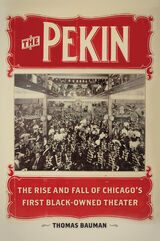 The Pekin: The Rise and Fall of Chicago's First Black-Owned Theater
Thomas Bauman
University of Illinois Press, 2014 In 1904, political operator and gambling boss Robert T. Motts opened the Pekin Theater in Chicago. Dubbed the "Temple of Music," the Pekin became one of the country's most prestigious African American cultural institutions, renowned for its all-black stock company and school for actors, an orchestra able to play ragtime and opera with equal brilliance, and a repertoire of original musical comedies.
A missing chapter in African American theatrical history, Bauman's saga presents how Motts used his entrepreneurial acumen to create a successful black-owned enterprise. Concentrating on institutional history, Bauman explores the Pekin's philosophy of hiring only African American staff, its embrace of multi-racial upper class audiences, and its ready assumption of roles as diverse as community center, social club, and fundraising instrument.
The Pekin's prestige and profitability faltered after Motts' death in 1911 as his heirs lacked his savvy, and African American elites turned away from pure entertainment in favor of spiritual uplift. But, as Bauman shows, the theater had already opened the door to a new dynamic of both intra- and inter-racial theater-going and showed the ways a success, like the Pekin, had a positive economic and social impact on the surrounding community.
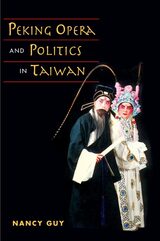 Peking Opera and Politics in Taiwan
Nancy Guy
University of Illinois Press, 2005 Peking Opera and Politics in Taiwan tells the peculiar story of an art caught in a sea of ideological ebbs and flows. Nancy Guy demonstrates the potential significance of the political environment for an art form's development, ranging from determining the smallest performative details (such as how a melody can or cannot be composed) to whether a tradition ultimately thrives or withers away.
When Chiang Kai-shek's Nationalist government and military retreated to Taiwan in 1949, they brought along numerous Peking opera performers. Expecting that this symbolically important art would strengthen regime legitimacy and authority, they generously supported Peking opera's perpetuation in exile. Valuing mainland Chinese culture above Taiwanese culture, the Nationalists generously supported Peking opera to the virtual exclusion of local performing traditions, despite their wider popularity. Later, as Taiwan turned toward democracy, the island's own "indigenous" products became more highly valued and Peking opera found itself on a tenuous footing. Finally, in 1995, all of its opera troupes and schools (formerly supported by the Ministry of Defense) were dismantled.
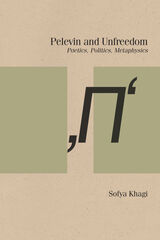 Pelevin and Unfreedom: Poetics, Politics, Metaphysics
Sofya Khagi
Northwestern University Press, 2021 Sofya Khagi’s Pelevin and Unfreedom: Poetics, Politics, Metaphysics is the first book-length English-language study of Victor Pelevin, one of the most significant and popular Russian authors of the post-Soviet era. The text explores Pelevin’s sustained Dostoevskian reflections on the philosophical question of freedom and his complex oeuvre and worldview, shaped by the idea that contemporary social conditions pervert that very notion. Khagi shows that Pelevin uses provocative and imaginative prose to model different systems of unfreedom, vividly illustrating how the present world deploys hyper-commodification and technological manipulation to promote human degradation and social deadlock. Rather than rehearse Cold War–era platitudes about totalitarianism, Pelevin holds up a mirror to show how social control (now covert, yet far more efficient) masquerades as freedom and how eagerly we accept, even welcome, control under the techno-consumer system. He reflects on how commonplace discursive markers of freedom (like the free market) are in fact misleading and disempowering. Under this comfortably self-occluding bondage, the subject loses all power of self-determination, free will, and ethical judgment. In his work, Pelevin highlights the unprecedented subversion of human society by the techno-consumer machine. Yet, Khagi argues, however circumscribed and ironically qualified, he holds onto the emancipatory potential of ethics and even an emancipatory humanism.
Pelican Tracks
Elton Glaser
Southern Illinois University Press, 2003 Pelican Tracks is a book of poems with a homing instinct. Elton Glaser travels a restless circuit between his native Louisiana and his adopted home of Ohio, from the “spice and license of the lowlands” to the “streets of Akron cobbled in ice.” These reflections, leavened with a fierce wit and moving bravura of language, are extracted from the origins and ends of the poet’s life—his birth in the final spasms of the second World War, the fears and excitements of youth, the death of parents, and the unexpected losses of adulthood. Marking his tracks between the Pelican State and the Buckeye State, Glaser records the damaged beauty of “everything sinking, everything rising again in the mind.”
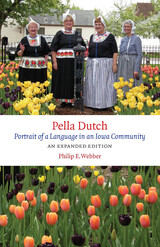 Pella Dutch: Portrait of a Language in an Iowa Community, An Expanded Edition
Philip E. Webber
University of Iowa Press, 1988 Founded in 1847 by religious separatists, the town of Pella in central Iowa is the state’s oldest Dutch American colony, and its crafts, architecture, and celebrations reflect and perpetuate the Dutch heritage of its earlier residents. Through his intriguing blend of sociolinguistic research, regional history, and interviews with current speakers of Pella Dutch, Philip Webber examines the town’s rich cultural and linguistic traditions. Drawing upon formal and informal interviews and conversations with more than 150 speakers of Pella Dutch, Webber uses the methods of language research to trace the vestiges of Dutch heritage left on the English spoken by local residents; to explain attitudes toward language and ethnicity that emerged in the twentieth century; and to document the vocabulary, linguistic forms, humor, and conversational patterns that characterize contemporary Pella Dutch. In addition, desiring to let his informants speak for themselves, he includes the playful jokes, proverbial observations, folk wisdom, children’s rhymes, riddles, and puzzles influenced by Pella Dutch. Webber’s introduction to this expanded paperback edition provides new photographs, updated information about recent research and publications, examples of how Dutch continues to be spoken, and descriptions of the ways in which Pella continues to commemorate its linguistic and cultural heritage. Linguists, anthropologists, and historians—as well as all those who enjoy Pella’s Tulip Time festival, its summertime fair or kermis, the Dutch letters in its bakeries, and the early winter visit of Sinterklaas—will appreciate Webber’s informed and engaging study of this unique Iowa community.
 Pellegrino's Clinical Bioethics: A Compendium
Edmund Pellegrino
Catholic University of America Press, 2023 Pellegrino’s Clinical Bioethics: A Compendium offers, for the first time, a collection of the landmark articles in clinical bioethics authored by the physician and philosopher, Edmund D Pellegrino. As one of the founding figures of modern medical ethics, Dr. Pellegrino gained international renown for his deeply reflective scholarship and for his public service in developing the field. In over 600 scholarly papers and two dozen books, he touched on topics in medical ethics, philosophy, and theology. Previous attempts to collect his work gave rise to a mixed assortment of his thoughts. This volume focuses purely on those topics in clinical bioethics that are sought after by healthcare professionals, professional and graduate students in these fields, and those involved with clinical bioethics in hospitals and clinics. His legacy and profound influence in the proper practice of the field of medicine is thus made accessible to present and subsequent generations.
The Peloponnesian War
Thucydides
University of Chicago Press, 1989 "Thomas Hobbes's translation of Thucydides brings together the magisterial prose of one of the greatest writers of the English language and the depth of mind and experience of one of the greatest writers of history in any language. . . . For every reason, the current availability of this great work is a boon."—Joseph Cropsey, University of Chicago
Peltse and Pentameron
Volodymyr Dibrova
Northwestern University Press, 1996 In these two novellas, Volodymyr Dibrova tells the story of how the Soviet system was sustained by individuals who never truly believed in it, but simply lacked the courage to oppose it.
Peltse portrays the formation of an average apparatchik. Both funny and alarming, it provides a psychological portrait of an individual trapped in a system he simultaneously dislikes and depends upon for survival. Pentameron tells the story of one day in the life of five colleagues at a Soviet research institute. Each is dissatisfied, yet all are trapped in and by a system that has taken away their ability to act decisively.
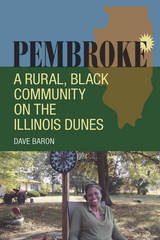 Pembroke: A Rural, Black Community on the Illinois Dunes
Dave Baron
Southern Illinois University Press, 2016 Winner, ISHS Annual Award for a Scholarly Publication, 2017
With a population of about two thousand, Pembroke Township, one of the largest rural, black communities north of the Mason-Dixon Line, sits in an isolated corner of Kankakee County, Illinois, sixty-five miles south of Chicago. It is also one of the poorest places in the nation. Many black farmers from the South came to this area during the Great Migration; finding Chicago to be overcrowded and inhospitable, they were able to buy land in the township at low prices. The poor soil made it nearly impossible to establish profitable farms, however, and economic prosperity has eluded the region ever since. Pembroke: A Rural, Black Community on the Illinois Dunes chronicles the history of this inimitable township and shows the author’s personal transformation through his experiences with Pembroke and its people. A native of nearby Kankakee, author Dave Baron first traveled to Pembroke on a church service trip at age fifteen and saw real poverty firsthand, but he also discovered a community possessing grace and purpose.
Baron begins each chapter with a personal narrative from his initial trip to Pembroke. He covers the early history of the area, explaining how the unique black oak savanna ecosystem was created and describing early residents, including Potawatomi tribes and white fur traders. He introduces readers to Pap and Mary Tetter, Pembroke’s first black residents, who—according to local lore—assisted fugitives on the Underground Railroad; details the town’s wild years, when taverns offered liquor, drugs, and prostitution; discusses the many churches of Pembroke and the nearby high school where, in spite of sometimes strained relations, Pembroke’s black students have learned alongside white students of a neighboring community since well before Brown v. Board of Education; outlines efforts by conservation groups to preserve Pembroke’s rare black oak savannas; and analyzes obstacles to and failed attempts at economic development in Pembroke, as well as recent efforts, including organic farms and a sustainable living movement, which may yet bring some prosperity.
Based on research, interviews with residents, and the author’s own experiences during many return trips to Pembroke, this book—part social, cultural, legal, environmental, and political history and part memoir—profiles a number of the colorful, longtime residents and considers what has enabled Pembroke to survive despite a lack of economic opportunities. Although Pembroke has a reputation for violence and vice, Baron reveals a township with a rich and varied history and a vibrant culture.
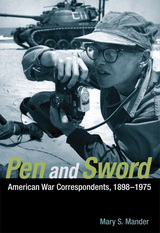 Pen and Sword: American War Correspondents, 1898-1975
Mary S. Mander
University of Illinois Press, 2010 Addressing the ever-changing, overlapping trajectories of war and journalism, this introduction to the history and culture of modern American war correspondence considers a wealth of original archival material. In powerful analyses of letters, diaries, journals, television news archives, and secondary literature related to the U.S.'s major military conflicts of the twentieth century, Mary S. Mander highlights the intricate relationship of the postmodern nation state to the free press and to the public. Pen and Sword: American War Correspondents, 1898-1975 situates war correspondence within the larger framework of the history of the printing press to make perceptive new points about the nature of journalism and censorship, the institution of the press as a source of organized dissent, and the relationship between the press and the military. Fostering a deeper understanding of the occupational culture of war correspondents who have accompanied soldiers into battle, Mander offers interpretive analysis of the reporters' search for meaning while embedded with troops in war-torn territories. Broadly encompassing the history of Western civilization and modern warfare, Pen and Sword prompts new ways of thinking about contemporary military conflicts and the future of journalism.
The Pen Makes a Good Sword: John Forsyth of the Mobile Register
Lonnie A. Burnett
University of Alabama Press, 2006 One editor. One era. A pen that cut through history. This book is a biography of Alabama native John Forsyth Jr. and documents his career as a southern newspaper editor during the antebellum, Civil War, and Reconstruction periods. From 1837 to 1877 Forsyth wrote about many of the most important events of the 19th century. He used his various positions as an editor, Civil War field correspondent, and Reconstruction critic at the MobileRegister to advocate on behalf of both the South and the Democratic Party. In addition, Forsyth played an active role in the events taking place around him through his political career, as United States Minister to Mexico, state legislator, Confederate Peace Commissioner to the Lincoln administration, staff officer to Braxton Bragg, and twice mayor of the city of Mobile.
 Penalties of Empire: Capital Trials in Colonial Hong Kong
Christopher Munn
Hong Kong University Press, 2025 An eye-opening study of the evolution of the death penalty in Hong Kong.
"We must have a procedure – if we are going to hang anyone – that is just," said Chief Justice Sir Francis Piggott in 1909, on discovering that Chinese persons accused of murder were being denied interpretation in Hong Kong’s courts. Due process, no matter how costly or inconvenient, was "one of the penalties of empire," he declared.
Penalties of Empire explores how judges, juries, and lawyers strove to deliver justice during the 150 years when the death penalty was in force in Hong Kong. Nine main chapters focus on key capital trials in the first century of British rule. Among the cases are piracies, assassinations, crimes of passion, and murders committed from desperation. These chapters describe the proceedings and participants in court. They also examine the public debates surrounding each case and the exercise of mercy by governors. Two final chapters discuss the decline of the death penalty after World War II, its suspension after 1966, and the controversies leading to its formal abolition in 1993. Penalties of Empire traces the evolution of criminal justice at its highest levels. It also offers a prism for understanding some of the broader forces at work in Hong Kong’s history.
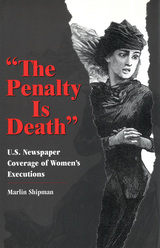 The Penalty Is Death: U.S. Newspaper Coverage of Women's Executions
Marlin Shipman
University of Missouri Press, 2002 In 1872 Susan Eberhart was convicted of murder for helping her lover to kill his wife. The Atlanta Constitution ran a story about her hanging in Georgia that covered slightly more than four full columns of text. In an editorial sermon about her, the Constitution said that Miss Eberhart not only committed murder, but also committed adultery and “violated the sanctity of marriage.” An 1890 article in the Elko Independent said of Elizabeth Potts, who was hanged for murder, “To her we look for everything that is gentle and kind and tender; and we can scarcely conceive her capable of committing the highest crime known to the law.” Indeed, at the time, this attitude was also applied to women in general. By 1998 the press’s and society’s attitudes had changed dramatically. A columnist from Texas wrote that convicted murderer Karla Faye Tucker should not be spared just because she was a woman. The author went on to say that women could be just as violent and aggressive as men; the idea that women are defenseless and need men’s protection “is probably the last vestige of institutionalized sexism that needs to be rubbed out.” In “The Penalty Is Death,” Marlin Shipman examines the shifts in press coverage of women’s executions over the past one hundred and fifty years. Since the colonies’ first execution of a woman in 1632, about 560 more women have had to face the death penalty. Newspaper responses to these executions have ranged from massive national coverage to limited regional and even local coverage. Throughout the years the press has been guilty of sensationalism, stereotyping, and marginalizing of female convicts, making prejudicial remarks, trying these women in the media, and virtually ignoring or simply demeaning African American women convicts. This thoroughly researched book studies countless episodes that serve to illustrate these points. Shipman’s use of reconstructed stories, gleaned from hundreds of newspaper articles, gives readers a deeper understanding of the ways these dailies reported on the trials and imprisonment of women and how these reports reflected the cultural norms of the times. His detailed narratives of the executions give evidence to the development of journalistic styles and techniques, such as the jazz journalism of the 1920s. By examining anecdotes about how the press reports on the death penalty, Shipman seeks to stimulate discussions about this subject that are more human and less abstract. “The Penalty Is Death” fills a void in the literature on capital punishment that has long been neglected. Anyone interested in media and press performance, capital punishment, or women’s roles in society will find this book of great value.
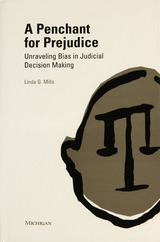 Penchant for Prejudice: Unraveling Bias in Judicial Decision-Making
Linda G. Mills
University of Michigan Press, 1999 A Penchant for Prejudice combines a detailed empirical study of the decision-making practices of judges with a sophisticated theoretical argument which exposes contemporary myths about judging and suggests methods of incorporating the inevitable bias that is detected in this and other studies. Based on a unique study of the decisions of Social Security judges, the book challenges the meaning of judicial impartiality. Linda G. Mills finds that, in practice, bias is a consistent dimension of what is considered "impartial" decision-making. The results reveal that impartiality as the legal system now defines it, is itself a form of bias, and that a historically and contextually sensitive definition of bias, one which takes account of the communities and cultures that come to be judged in the legal system, must overcome the modern dualistic notion of imparitality as the exclusion of bias in order to respond to needs of the diversity of applicants and the judges who adjudicate their claims. According to Mills, the judicial bias she found reflected in her study seems not only to essentialize and stereotype applicants but also prevents judges from engaging vulnerable claimants in a way that the legal process positively demands. A Penchant for Prejudice will be of interest to students and scholars of law, judicial decisionmaking, and discrimination. Linda G. Mills is Assistant Professor of Social Welfare and Law, University of California, Los Angeles.
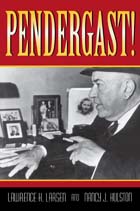 Pendergast!
Lawrence H. Larsen and Nancy J. Hulston
University of Missouri Press, 1997 More than a half-century after the death of Kansas City's notorious political boss, Thomas J. Pendergast, the Pendergast name still evokes great interest and even controversy. Now, in this first full-scale biography of Pendergast, Lawrence H. Larsen and Nancy J. Hulston have successfully provided—through extensive research, including use of recently released prison records and previously unavailable family records—a clear look at the life of Thomas J. Pendergast.
Born in St. Joseph, Missouri, in 1872, Tom Pendergast moved to Kansas City around 1890 to work for his brother James, founder of the Pendergast "Goat" faction in Kansas City Democratic politics. In 1911, Pendergast became head of the Goats, and over the next fifteen years he created a powerful political machine that used illegal voting and criminal enforcers to gain power. Following a change in the city charter in 1925, Pendergast took control of Kansas City and ran it as his own personal business. In the 1930s, he received over $30 million annually from gambling, prostitution, and narcotics, putting him in the big leagues of American civic corruption. He also wielded great power in the National Democratic Party and started Harry S. Truman on the road to the presidency.
In this well-balanced biography, the authors examine Pendergast's rise to power, his successes as a political leader, his compassion for the destitute, and his reputation for keeping his word. They also examine Pendergast's character development and how his methods became more and more ruthless. Pendergast had no use for ideology in his "invisible government"—only votes counted.
In 1937 and 1938 the federal government broke the back of Pendergast's machine, convicting 259 of his campaign aides for vote fraud. In 1939 Pendergast, who was believed to be the largest bettor on horse racing in the United States, was jailed for income tax evasion, and he died in disgrace in 1945.
An insightful and comprehensive biography, Pendergast! will surely serve for years to come as the most thorough investigation of the life and infamous career of Tom Pendergast.
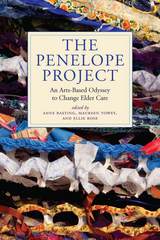 The Penelope Project: An Arts-Based Odyssey to Change Elder Care
Anne Basting, Maureen Towey, and Ellie Rose
University of Iowa Press, 2016 Of the 15,000 nursing homes in the United States, how many are places you’d want to visit, much less live in? Now that people are living longer and more of the population are elderly, this question is more important than ever, particularly for people with disabilities. We must transform long-term care into an experience we and our loved ones can face without dread. It can be done. The Penelope Project shows how by taking readers on an ambitious journey to create a long-term care community that engages its residents in challenging, meaningful art-making.
At Milwaukee’s Luther Manor, a team of artists from the University of Wisconsin’s theatre department and Sojourn Theatre Company, university students, staff, residents, and volunteers traded their bingo cards for copies of The Odyssey. They embarked on a two-year project to examine this ancient story from the perspective of the hero who never left home: Penelope, wife of Odysseus. Together, the team staged a play that engaged everyone and transcended the limits not just of old age and disability but also youth, institutional regulations, and disciplinary boundaries.
Inviting readers to see through the eyes of residents, students, artists, staff, family members, and experts in the fields of education, long-term care, and civically engaged arts practice, this book underscores the essential role of the arts and humanities in living richly. Waiting, as Penelope waited, need not be a time of loss and neglect. The Penelope Project boldly dreams of how to make late life a time of growth and learning. If you dream of improving people’s lives through creative endeavors, this book provides practical advice.
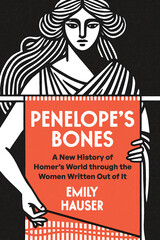 Penelope’s Bones: A New History of Homer’s World through the Women Written Out of It
Emily Hauser
University of Chicago Press, 2025 Weaving together literary and archaeological evidence, Emily Hauser illuminates the rich, intriguing lives of the real women behind Homer’s Iliad and Odyssey.
Achilles. Agamemnon. Odysseus. Hector. The lives of these and many other men in the greatest epics of ancient Greece have been pored over endlessly in the past three millennia. But these are not just tales about heroic men. There are scores of women as well—complex, fascinating women whose stories have gone unexplored for far too long.
In Penelope’s Bones, award-winning classicist and historian Emily Hauser pieces together compelling evidence from archaeological excavations and scientific discoveries to unearth the richly textured lives of women in Bronze Age Greece—the era of Homer’s heroes. Here, for the first time, we come to understand the everyday lives and experiences of the real women who stand behind the legends of Helen, Briseis, Cassandra, Aphrodite, Circe, Athena, Hera, Calypso, Penelope, and more. In this captivating journey through Homer’s world, Hauser explains era-defining discoveries, such as the excavation of Troy and the decipherment of Linear B tablets that reveal thousands of captive women and their children; more recent finds like the tomb of the Griffin Warrior at Pylos, whose tomb contents challenge traditional gender attributes; DNA evidence showing that groups of warriors buried near the Black Sea with their weapons and steeds were, in fact, Amazon-like female fighters; a prehistoric dye workshop on Crete that casts fresh light on “women’s work” of dyeing, spinning, and weaving textiles; and a superbly preserved shipwreck off the coast of Turkey whose contents tell of the economic and diplomatic networks crisscrossing the Bronze Age Mediterranean.
Essential reading for fans of Madeline Miller or Natalie Haynes, this riveting new history brings to life the women of the Bronze Age Aegean as never before, offering a groundbreaking reassessment of the ancient world.
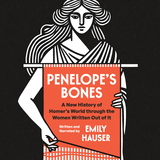 Penelope’s Bones: A New History of Homer's World through the Women Written Out of It
Emily Hauser
University of Chicago Press, 2025 This is an audiobook version of this book. Weaving together literary and archaeological evidence, Emily Hauser illuminates the rich, intriguing lives of the real women behind Homer’s Iliad and Odyssey.
Achilles. Agamemnon. Odysseus. Hector. The lives of these and many other men in the greatest epics of ancient Greece have been pored over endlessly in the past three millennia. But these are not just tales about heroic men. There are scores of women as well—complex, fascinating women whose stories have gone unexplored for far too long.
In Penelope’s Bones, award-winning classicist and historian Emily Hauser pieces together compelling evidence from archaeological excavations and scientific discoveries to unearth the richly textured lives of women in Bronze Age Greece—the era of Homer’s heroes. Here, for the first time, we come to understand the everyday lives and experiences of the real women who stand behind the legends of Helen, Briseis, Cassandra, Aphrodite, Circe, Athena, Hera, Calypso, Penelope, and more. In this captivating journey through Homer’s world, Hauser explains era-defining discoveries, such as the excavation of Troy and the decipherment of Linear B tablets that reveal thousands of captive women and their children; more recent finds like the tomb of the Griffin Warrior at Pylos, whose tomb contents challenge traditional gender attributes; DNA evidence showing that groups of warriors buried near the Black Sea with their weapons and steeds were, in fact, Amazon-like female fighters; a prehistoric dye workshop on Crete that casts fresh light on “women’s work” of dyeing, spinning, and weaving textiles; and a superbly preserved shipwreck off the coast of Turkey whose contents tell of the economic and diplomatic networks crisscrossing the Bronze Age Mediterranean.
Essential reading for fans of Madeline Miller or Natalie Haynes, this riveting new history brings to life the women of the Bronze Age Aegean as never before, offering a groundbreaking reassessment of the ancient world.
 Penetration & Protest in Tanzania: Impact Of World Economy On The Pare, 1860-1960
Isaria N. Kimambo
Ohio University Press, 1990 The originality of this study of rural transformation stems from the way in which Professor Kimambo has used the oral tradition to reveal the history of the impact of the world economy in northeastern Tanzania. First under the pressures of commodity trade, and later under German and British imperialism, the peasant producers of this region were forced into participation in capitalist production. These partial changes destroyed the Pare’s balanced subsistence structure. But throughout the colonial period they were frustrated in their efforts to transform themselves fully into capitalist producers. These struggles finally led to open revolt in 1947 and it was three years before the protest ended. Between 1947 and 1960 the colonial government tried to reverse the effects of the revolt without providing the kind of transformation desired by the peasants. This study illustrates vividly the difference between the intentions of capital and those of the colonized peasantry. The intentions of the two sides seemed to be incompatible. While imperialism would allow for the limited participation that would maximize profits for metropolitan capital, the peasants were struggling for freedom to transform themselves into capitalist producers.
 Penguins in the Desert
Eric Wagner
Oregon State University Press, 2018 Most of us wouldn’t think to look for penguins in a hot desert, but every year along a windswept edge of coastal Patagonia, hundreds of thousands of Magellanic penguins gather to rear their young at Punta Tombo, Argentina. It is the largest penguin colony in the world outside of Antarctica, and for the past three decades, biologist Dee Boersma has followed them there.
Eric Wagner joined her team for six months in 2008, and in Penguins in the Desert, he chronicles that season in the remarkable lives of both the Magellanic penguins of Punta Tombo and the scientists who track their every move. For Boersma, the penguins are ecosystem sentinels. At the colony’s peak, more than a million birds bred there, but now less than half as many do. In confronting this fact, Boersma tackles some of the most urgent issues facing penguins and people today. What is the best way to manage our growing appetite for fish? How do we stop catastrophic oil spills from coating birds? How will we address the looming effects of climate change?
As Wagner spends more and more time with the penguins and the scientists in the field, other equally pressing questions come to mind. What is it like to be beaten by a penguin? Or bitten by one? How can a person be so dirty for so many months on end? In a tale that is as much about life in the field as it is about one of the most charismatic creatures on earth, Wagner brings humor, warmth, and hard-won insight as he tries to find the answer to what turns out to be the most pressing question of all: What does it mean to know an animal and to grapple with the consequences of that knowing?
 Penguin's Way
Johanna Johnston
Bodleian Library Publishing, 2015 With a new children’s book imprint, the Bodleian Library brings beloved classics back into print, beginning with a beautiful storybook about the life of a fascinating Antarctic species. Originally published in 1962, Penguin’s Way by Johanna Johnston tells the surprising story of these creatures, complete with colorful artwork by award-winning illustrator Leonard Weisgard.
In Penguin’s Way, a playful colony of emperor penguins lives on the edge of a faraway secret sea. During the summers, the penguins are content to fish and swim in the icy waters. But, when the seasons change, they must travel more than one hundred miles to the snowy lands surrounding the South Pole. All across the snow plain, the penguins sing songs to welcome newly hatched chicks into the world, but how will the fluffy newborns survive the freezing winter?
Few things pique children’s curiosity about the world around them better than a good book. Brought back for a new generation of young readers, Penguin’s Way offers a fun and creative introduction to these fascinating animals.
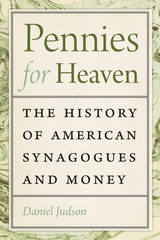 Pennies for Heaven: The History of American Synagogues and Money
Daniel Judson
Brandeis University Press, 2018 In the annals of American Jewish history, synagogue financial records have been largely overlooked. But as Daniel Judson shows in his examination of synagogue ledgers from 1728 to the present, these records provide an array of new insights into the development of American synagogues and the values of the Jews who worshipped in them. Looking at the history of American synagogues through an economic lens, Judson examines how synagogues raised funds, financed buildings, and paid clergy. By “following the money,” he reveals the priorities of the Jewish community at a given time. Throughout the book, Judson traces the history of capital campaigns and expenditures for buildings. He also explores synagogue competition and debates over previously sold seats, what to do about wealthy widows, the breaking down of gender norms, the hazan “bubble” (which saw dozens of overpaid cantors come to the United States from Europe), the successful move to outlaw “mushroom synagogues,” and the nascent synagogue-sharing economy of the twenty-first century. Judson shows as well the ongoing relationship of synagogue and church financing as well as the ways in which the American embrace of the free market in all things meant that the basic rules of supply and demand ultimately prevailed in the religious as well as the commercial realm.
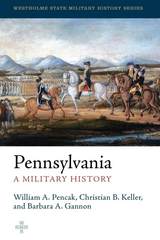 Pennsylvania: A Military History
William A. Pencak
Westholme Publishing, 2016 Founded in 1682 by a society that had no military, eschewed violence as a means of solving conflicts, and tolerated a wide variety of religions, Pennsylvania began as a “peaceable kingdom”—but war was essential to both Pennsylvania’s founding and its history. Pennsylvania was the site of some of the most important military events in American history, including the destruction of the Braddock Expedition, the battles of Brandywine and Germantown, Valley Forge, the Whiskey Rebellion, and the Battle of Gettysburg. Pennsylvania was also a leader in America’s modern wars, with the Pennsylvania-based 28th Infantry Division serving with distinction in both world wars as well as in Iraq, and the state’s industry, particularly steel production and ship building, being essential to the natinal effort. Complete with a list of historical sites and a comprehensive bibliography, Pennsylvania: A Military History is an important reference for those interested in the role of the Keystone State in our nation’s wars.
Westholme State Military History Series
Each state in the United States of America has a unique military history. The volumes in this series seek to provide a portrait of the richness of each state’s military experience, primarily defined by its borders, as well as the important contributions the state has made to the nation’s military history. Written by historians for the general reader, the volumes trace the history of conflict from the original native populations to today. The volumes are well illustrated and include specially commissioned maps, extensive bibliographies, lists of national and state historical sites, and a detailed index.
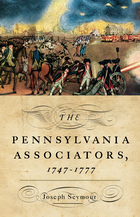 The Pennsylvania Associators, 1747–1777
Joseph Seymour
Westholme Publishing, 2024 The First Complete History of the Military Force of Colonial Pennsylvania, a Volunteer Body Created as a Practical Response to the Ideal of Pacifism Known at various times as the Military Association of Pennsylvania, the Pennsylvania Association, or simply Associators, this long-neglected organization represented a new constituency in Pennsylvania politics and by extension, a new American response to arbitrary rule. Organized on December 7, 1747, at Philadelphia, the Military Association, an all-volunteer military establishment pledged to the defense of Pennsylvania, served as the de facto armed force for Pennsylvania, a colony whose leadership, a loose coalition of Quaker and German pacifists, land barons, and merchants, foreswore military preparedness on religious and ideological grounds. For the Associators, including their most noted supporter, Benjamin Franklin, a defenseless colony was no longer practical. During the War of Austrian Succession and again in the Seven Years’ War, Associators organized defense efforts in defiance of the Pennsylvania colonial leadership. Associators also helped defend American Indian refugees against the infamous Paxton Boys in 1764. By 1775, Associators found themselves as the colony’s only legitimate military leadership and, by capitalizing on electoral gains in the lead up to the American Revolution, Associators assumed offices vacated by former officials. During the critical battles of 1776, the Associators in their distinctive round hats and brown coats proved a decisive asset to the Continental Army. In The Pennsylvania Associators, 1747–1777, historian Joseph Seymour has painstakingly researched primary source materials in order to write the first comprehensive history of this influential organization. Seymour demonstrates that while the Pennsylvania Associators contributed to success in the campaigns in which they fought, particularly the battles of Trenton and Princeton, a more fascinating and important investigation are the concerns that motivated these men. Associators considered military service in defense of their religious and civil liberties as a natural right. For three decades, Associators demonstrated that belief in and out of uniform. In a colony founded on religious exceptionalism, Associators saw themselves as faithful soldiers and active agents against leadership by entitlement, a principle guiding our government today.
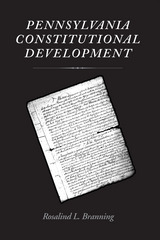 Pennsylvania Constitutional Development
Rosalind L. Branning
University of Pittsburgh Press, 2004
Pennsylvania Constitutional Development has proven to be the definitive study of the history of Pennsylvania's constitution in its first four incarnations. Rosalind Branning's critique, first published in 1960, reflects the movement that led to the constitution of 1968. After tracing the history of the 1776 constitution and its earliest revisions--in 1790 and 1838--Branning primarily focuses on the constitutional convention of 1872-73 and the resulting document of 1874, which endured for almost a century. She uses the published <I>Debates</I>, newspaper files, and the observations of contemporary writers and statesmen to provide a detailed and engaging study of the politics and leadership of the time. Her analysis demonstrates that this constitutional convention produced an instrument that was designed to meet nineteenth-century needs but would need significant revisions by future generations. Foreseeing the very issues that would be addressed in the 1967-68 constitutional convention, Branning identifies the elements that are necessary for successful constitutional lawmaking.
The evolution of Pennsylvania's body of laws serves as a cogent example of the opportunities and foibles intrinsic to the process of defining effective governance of a state. Pennsylvania Constitutional Development remains an essential resource for students and historians, and should be read by anyone interested in the government of the Keystone State.
Pennsylvania Farming: A History in Landscapes
Sally McMurry
University of Pittsburgh Press, 2017
Winner, 2018 Philip S. Klein Book Prize
Winner, 2020 SAH Antoinette Forrester Downing Book Award
Since precolonial times, agriculture has been deeply woven into the fabric of Pennsylvania’s history and culture. Pennsylvania Farming presents the first history of Pennsylvania agriculture in than more sixty years and offers a completely new perspective. Sally McMurry goes beyond a strictly economic approach and considers the diverse forces that helped shape the farming landscape, from physical factors to cultural repertoires to labor systems. Above all, the people who created and worked on Pennsylvania’s farms are placed at the center of attention. More than 150 photographs inform the interpretation, which offers a sweeping look at the evolution of Pennsylvania’s agricultural landscapes right up to the present day.
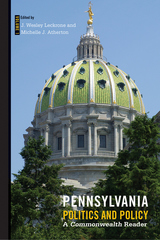 Pennsylvania Politics and Policy: A Commonwealth Reader
J. Wesley Leckrone
Temple University Press, 2018 The activities of state governments have always been important in the American federal system. However, recent partisan gridlock in Washington, DC has placed states at the forefront of policymaking as the national government maintains the status quo. Pennsylvania Politics and Policy, Volume 1 is designed to showcase current issues of interest to Pennsylvanians. This reader contains updated chapters from recent issues of Commonwealth: A Journal of Pennsylvania Politics and Policy on education, health care, public finance, tax policy, environmental policy, alcohol policy and more. Each chapter is supplemented by forums with arguments in support of or opposed to contested elements of state policy, discussion questions, and suggestions for further reading. In addition, Pennsylvania Politics and Policy, Volume 1 includes a comprehensive guide to researching state government and policy online. It is designed as a text or supplement for college or advanced high school classes in American government, state and local politics, public policy, and public administration. Contributors include: David G. Argall, Tom Baldino, Michele Deegan, Michael Dimino, George Hale, Rachel L. Hampton , Paula Duda Holoviak Jon Hopcraft, Vera Krekanova, Maureen W. McClure, Barry G. Rabe, Marguerite Roza, Lanethea Mathews Shultz, Jennie Sweet-Cushman, Amanda Warco, and the editors.
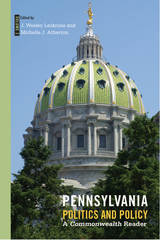 Pennsylvania Politics and Policy, Volume 2: A Commonwealth Reader
Edited by Michelle J. Atherton and J. Wesley Leckrone
Temple University Press, 2019 Designed to showcase current issues of interest, Pennsylvania Politics and Policy, Volume 2 isthe second reader consisting of updated chapters from recent issues of Commonwealth: A Journal of Pennsylvania Politics and Policy. The editors and contributors to this volume focus on government institutions, election laws, the judiciary, government finance and budgeting, the opioid crisis, childcare, property taxes, environmental policy, demographics, and more. Each chapter is supplemented by discussion questions, suggestions for further reading, and forums with arguments in support of or opposed to contested elements of state policy. In addition, Pennsylvania Politics and Policy, Volume 2 includes a detailed guide to researching state government and policy online, as well as a comprehensive chapter on the structure of Pennsylvania government. It is designed as a text or supplement for college or advanced high school classes in American government, state and local politics, public policy, and public administration. Contributors include: John Arway, Jenna Becker Kane, Jeffrey Carroll, Bob Dick, Ashley Harden, Stefanie I. Kasparek, Vera Krekanova, Maureen W. McClure, John F. McDonald, Josh Shapiro, Marc Stier, Jennie Sweet-Cushman, James Vike, and the editors.
 Pennsylvania Stories--Well Told
William Ecenbarger
Temple University Press, 2017 With a biting mix of wonder and pride, William Ecenbarger observes that in the quirky state of Pennsylvania, the town of Mauch Chunk changed its name to Jim Thorpe—even though the famous Indian athlete never set foot in it.
A former journalist for the Philadelphia Inquirer Magazine, and author of the bestseller Kids for Cash, Ecenbarger has collected a dozen of his fascinating articles showcasing the Keystone State in Pennsylvania Stories—Well Told. He provides a history of the pencil, and considers why the first day of Pennsylvania’s deer hunting season—the world’s largest participatory sporting event—is an unofficial state holiday, closing schools and state offices. Ecenbarger also profiles George “Boom Boom” Zambelli, the internationally renowned pyrotechnic king, and goes driving with Pennsylvania native John Updike in rural Berks County, PA.
Other fascinating tales unfold in Pennsylvania Stories, from an inspiring tale of Governor Bob Casey’s double organ transplant, to darker essays on the electric chair and the Ku Klux Klan, to a mile-by-mile appreciation of the Pennsylvania Turnpike.
In these weird and wonderful stories, Ecenbarger highlights just what makes Pennsylvania both eccentric and great. His book is a delightfully intriguing read for natives and curious outsiders alike.
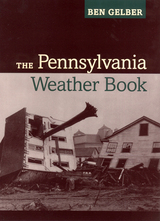 The Pennsylvania Weather Book
Gelber, Ben
Rutgers University Press, 2002 The weather has always been a favorite topic of conversation. Undoubtedly, someone must have said to Noah, “I thought they said it was supposed to let up on Tuesday.” Over a century ago, American essayist Charles Dudley Warner wrote in the HartfordCourant, “Everybody talks about the weather but nobody does anything about it.” And now with the advent of the 24-hour Weather Channel and high-tech radar and satellite imagery, we have more information about the weather at our disposal than ever before. But what about weather in the past? Is the climate changing? Are the summers hotter now than ever before? Were winters colder when our grandparents were children?
In The Pennsylvania Weather Book, meteorologist Ben Gelber provides the first comprehensive survey of 250 years of recorded weather in this state. He reports on noteworthy weather happenings by category (snowstorms, rainstorms, cold and heat waves, thunderstorms, and tropical storms) and places them in historical context. Throughout the book, Gelber clearly defines meteorological terms and explains what creates weather events. The book features appendices and tables containing useful references for average temperatures, precipitation, snowfall, and climate data. It also provides a brief history of the weather watchers who contributed to the state’s meteorological records since the late eighteenth century. This volume will serve as a valuable resource for weather professionals, amateurs, and local enthusiasts alike.
 Penny Loafers & Bobby Pins: Tales and Tips from Growing Up in the ’50s and ’60s
Susan Sanvidge
Wisconsin Historical Society Press, 2010 “In the fifties, sleek Mixmasters were replacing rusty eggbeaters, and new pressure-cookers blew their tops in kitchens all over town. There were kids everywhere, and new ‘ranch-style’ houses filled vacant lots. . . . Turquoise Studebakers and dusty-rose Chevy BelAirs with flamboyant fins and lots of chrome replaced dark pre-war cars. Cameras took color snapshots instead of black-and-white. We wore red canvas tennis shoes and lemon yellow shorts, and bright blue popsicles melted down our chins.” —from the Introduction In Penny Loafers & Bobby Pins, the four Sanvidge sisters, whose birthdates span the Baby Boomer period, present a lively chronicle of growing up in the 1950s and 1960s in a small midwestern town. Each sister writes about the facets of her childhood she remembers best, and their lighthearted stories are illustrated with period photos. Sprinkled with mentions of pedal pushers, home permanents, and “two-tone” cars; early TV shows and the first rock and roll; hula hoops, Tiny Tears, and Mr. Potato Head (played with a real potato); and memories of their grandparents who lived nearby, Penny Loafers & Bobby Pins also features “how-tos” for re-creating the fads, foods, crafts, and games the Sanvidge sisters recall in their stories.
A Penny's Worth of Minced Ham: Another Look at the Great Depression
Robert J. Hastings
Southern Illinois University Press, 1986 Hastings experienced the rural and small town side of an event that touched all who weathered it—the economic crash of 1929 and its 10-year aftermath. The author grew up in Marion, Illinois, entering the first grade in 1930, the start of the Great Depression. This book, which recalls memorable episodes in the life of that boy, is a sequel to the popular ANickel’s Worth of Skim Milk. What Hastings experienced as a child was typical of depression-era life. Those who were young then can relive lost youth in Hastings’ books. And there were moments worth reliving: Hastings tells of “laughter and love and tears in the midst of hunger and cold and deprivation.” Those too young to have experienced the economic devastation can see those hard days through the eyes of a trained storyteller reporting from the point of view of a child.
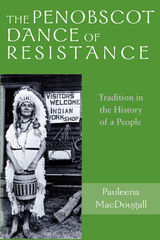 The Penobscot Dance of Resistance: Tradition in the History of a People
Pauleena MacDougall
University of New Hampshire Press, 2004 Although historians predicted the demise of the Penobscot Indians early in the nineteenth century, the tribe is thriving at the opening of the twenty-first century. Having by the early 1800s been rendered all but invisible to the dominant culture, the Penobscots, by selectively adapting to changing circumstances, won back land and visibility. The vital importance of employing elements of cultural resistance as a survival mechanism has, until now, been underestimated. In a larger context,Dance of Resistance demonstrates how an examination of the history of one Indian nation provides a window on the complex interaction of cultural systems in America.
MacDougall demonstrates that Penobscot legend, linguistics, dance, and oral tradition became foundations of resistance against assimilation into the dominant culture. She thoughtfully and accessibly reconstructs from published, archival, and oral sources the tribe's metaphorical and triumphant Dance of Resistance—founded on spiritual power, reverence for homeland, and commitment to self-determination—from colonial times to the present. A decade of political activism culminated in the precedent-setting 1980 Maine Indian Land Claims settlement. Today the Penobscots run small industries, manage their natural resources, and provide health services, K through 8 education, and social services to the poor and elderly of their community.
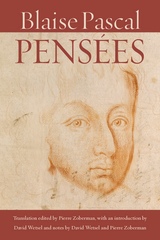 Pensees
Blaise Pascal
Catholic University of America Press, 2021 Blaise Pascal (1623-1662) was a French mathematician, physicist, and religious philosopher, who laid the foundation for the modern theory of probabilities. The Pensées are made up of some 800 fragments, that have proven to be an enduring masterpiece since their initial publication in 1670.
This volume is a translation of Philippe Sellier’s edition of Pascal’s Pensées, in addition to two shorter texts, the Exchange with M. de Sacy and The Life of Monsieur Pascal by Pascal’s sister, Gilberte Périer. In addition to a Preface and an Introduction, there is a comprehensive apparatus criticus. The text was originally produced by a team of international Pascal scholars, who translated individual sections and was revised by the General Editor. The introduction situates the Sellier edition in the history of Pascal scholarship and highlights the advance its reordering of the fragments and of the folders or bundles represents, both the translation itself and the notes allow for a deeper reading of the text. It not only gives English readers a version of the authoritative Sellier edition of the collection of reflections known as The Pensées, it also proposes material which help assess the philosopher’s significance and the originality of his thought.
On the whole, this translation gives a comprehensive view of the progress of Pascal’s intended Apology of the Christian Religion as well as of other writings on related topics. It also provides today’s readers with a challenging set of arguments, prayer, and quotations from Scripture, and even the record of a mystical experience, known as the Memorial. It highlights all facets of Pascal’s genius, his familiarity with Scripture combined with a talent for controversy, irony mixed with fervor, and altogether the production of an intriguing and challenging writer and thinker.
 Pension Plans and Employee Performance: Evidence, Analysis, and Policy
Richard A. Ippolito
University of Chicago Press, 1997 In this provocative book, Richard A. Ippolito explores the relationship between employees' preferences for certain types of pension plans and their productivity. Ippolito begins by reviewing how pensions influence workers' behavior on the job, helping employers reduce early quit rates and increase early retirement rates. In a novel contribution, Ippolito then shows how pensions can assist employers in attracting and retaining workers who have personal attributes valued by the firm.
Challenging the accepted view of defined contribution plans, such as the 401k, as merely convenient tax-deferred savings plans, Ippolito argues that these plans can help firms select and pay their best workers without expending monitoring resources. Building on his proposals for managing private pension plans, Ippolito concludes with a blueprint for fixing the social security system that would promote incentives to work and save while at the same time improving the system's financial condition.
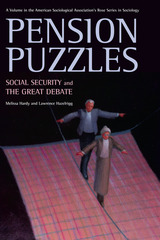 Pension Puzzles: Social Security and the Great Debate
Melissa Hardy
Russell Sage Foundation, 2007 The rancorous debate over the future of Social Security reached a fever pitch in 2005 when President Bush unsuccessfully proposed a plan for private retirement accounts. Although efforts to reform Social Security seem to have reached an impasse, the long-term problem—the projected Social Security deficit—remains. In Pension Puzzles, sociologists Melissa Hardy and Lawrence Hazelrigg explain for a general audience the fiscal challenges facing Social Security and explore the larger political context of the Social Security debate. Pension Puzzles cuts through the sloganeering of politicians in both parties, presenting Social Security's technical problems evenhandedly and showing how the Social Security debate is one piece of a larger political struggle. Hardy and Hazelrigg strip away the ideological baggage to explicate the basic terms and concepts needed to understand the predicament of Social Security. They compare the cases for privatizing Social Security and for preserving the program in its current form with adjustments to taxes and benefits, and they examine the different economic projections assumed by proponents of each approach. In pursuit of its privatization agenda, Hardy and Hazelrigg argue, the Bush administration has misled the public on an issue that was already widely misunderstood. The authors show how privatization proponents have relied on dubious assumptions about future rates of return to stock market investments and about the average citizen's ability to make informed investment decisions. In addition, the administration has painted the real but manageable shortfalls in Social Security revenue as a fiscal crisis. Projections of Social Security revenues and benefits by the Social Security Administration have treated revenues as fixed, when in fact they are determined by choices made by Congress. Ultimately, as Hardy and Hazelrigg point out, the clash over Social Security is about more than technical fiscal issues: it is part of the larger culture wars and the ideological struggle over what kind of social responsibilities and rights American citizens should have. This rancorous partisan wrangling, the alarmist talk about a "crisis" in Social Security, and the outright deception employed in this debate have all undermined the trust between citizens and government that is needed to restore the solvency of Social Security for future generations of retirees. Drawing together economic analyses, public opinion data, and historical narratives, Pension Puzzles is a lucid and engaging guide to the major proposals for Social Security reform. It is also an insightful exploration of what that debate reveals about American political culture in the twenty-first century. A Volume in the American Sociological Association's Rose Series in Sociology
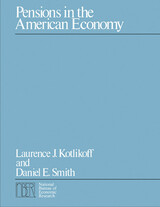 Pensions in the American Economy
Laurence J. Kotlikoff and Daniel E. Smith
University of Chicago Press, 1984 For anyone with an interest in pensions—workers and employers, personnel directors, accountants, actuaries, lawyers, insurance agents, financial analysts, government officials, and social scientists—this book is required reading. Now, without the aid of a pension specialist, anyone can determine how their particular pension plan stacks up against the average. Using virtually all available government sources (including computerized data unavailable in print) and their own extensive surveys, the authors present a comprehensive description of the structural features and financial conditions of U.S. private, state, city, and municipal pension plans. The introductions to the hundreds of tables explain and highlight the information.
The picture that emerges of the "typical" plan and its significant variations is crucial to all those with a financial stake in pensions. The reader can compare pension vesting, retirement, and benefit provisions by plan type, plan size, industry, union status, and many more characteristics. With this information, workers can evaluate just how generous their employer is; job applicants can compare fringe benefits of prospective employers; personnel directors can judge their competitive edge.
The financial community will find especially interesting the analysis of the unfunded liabilities of private, state, and local pension funds. The investment decisions of private and public pension funds and their return performances are described as well.
Government officials and social scientists will find the analysis of pension coverage, the receipt of pension income by the elderly, cost-of-living adjustments, and disability insurance of special importance in evaluating the proper degree of public intervention in the area of old age income support.
Pensions in the American Economy is comprehensive and easy to use. Every reader, from small-business owners and civil servants to pension fund specialists, will find in it essential information about this increasingly important part of labor compensation and retirement finances.
 Pensions in the Health and Retirement Study
Alan L. Gustman, Thomas L. Steinmeier, and Nahid Tabatabai
Harvard University Press, 2010 This book presents a careful analysis of pension data collected by the Health and Retirement Study, a unique survey of people over the age of fifty conducted by the University of Michigan for the National Institute on Aging. The authors studied pensions as they evolve over individuals’ work lives and into retirement: how pension coverage and plans change over a lifetime, how many pensions workers have by the time they retire and what these pensions are worth, what pensions contribute to individual retirement incomes, and how trends and policy changes affect retirement plans.
The book focuses on the major features of pensions, including plan type and participation, ages of eligibility for retirement, values of different pension types, how pension values are influenced by retirement age, how plans are settled when a worker leaves a firm, how well people understand their pensions, the importance of pensions in retirement saving and as a share of household wealth, and the vulnerability of the retirement age population to the current financial crisis.
This book provides readers with an invaluable look at the crucial but ever-changing role of pensions in supporting retirees.
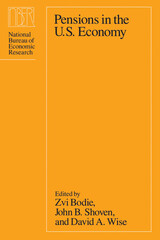 Pensions in the U.S. Economy
Edited by Zvi Bodie, John B. Shoven, and David A. Wise
University of Chicago Press, 1988 Pensions in the U.S. Economy is the fourth in a series on pensions from the National Bureau of Economic Research. For both economists and policymakers, this volume makes a valuable contribution to current research on pensions and the economics of the elderly. The contributors report on retirement saving of individuals and the saving that results from corporate funding of pension plans, and they examine particular aspects of the plans themselves from the employee's point of view.
Steven F. Venti and David A. Wise offer a careful analysis of who contributes to IRAs and why. Benjamin M. Friedman and Mark Warshawsky look at the reasons more retirement saving is not used to purchase annuities. Personal saving through pension contribution is discussed by B. Douglas Bernheim and John B. Shoven in the context of recent government and corporate pension funding changes. Michael J. Boskin and John B. Shoven analyze indicators of the economic well-being of the elderly, addressing the problem of why a large fraction of the elderly remain poor despite a general improvement in the economic status of the group as a whole. The relative merits of defined contribution versus defined benefit plans, with emphasis on the risk aspects of the two types of plans for the individual, are examined by Zvi Bodie, Alan J. Marcus, and Robert C. Merton. In the final paper, pension plans and worker turnover are the focus of the discussion by Edward P. Lazear and Robert L. Moore, who propose pension option value rather than the commonly used accrued pension wealth as a measure of pension value.
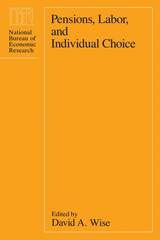 Pensions, Labor, and Individual Choice
David A. Wise
University of Chicago Press, 1985 In recent years a decline in the labor force participation of older workers has combined with rapid current and projected increases in the number of older Americans, producing major policy debates over looming "crises" in social security and, to a lesser extent, in the private pension system. That private system is playing an increasing role in the support of retired workers and promises to be the subject of increasing scrutiny by economists and policymakers alike.
Previous books on private pensions have largely neglected behavioral implications of the features of pension plans. The papers in this volume, developed from material presented at a recent National Bureau of Economic Research conference, address two aspects of the relation between varieties of labor coverage and participation in the labor force. First, age at retirement may be correlated with kind of pension coverage. The papers, in fact, provide strong evidence that individual decisions about when to retire are directly influenced by pension options. Second, pension plans usually impose a high cost on workers who change jobs, which suggests that pension coverage reduces instances of job change. Pensions, Labor, and Individual Choice quantifies these correlations and proposes a conceptual framework within which to view them.
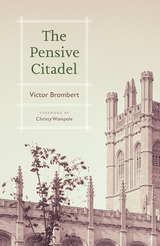 The Pensive Citadel
Victor Brombert
University of Chicago Press, 2023 A reflective volume of essays on literature and literary study from a storied professor.
In The Pensive Citadel, Victor Brombert looks back on a lifetime of learning within a university world greatly altered since he entered Yale on the GI Bill in the 1940s. Yet for all that has changed, much of Brombert’s long experience as a reader and teacher is richly familiar: the rewards of rereading, the joy of learning from students, and most of all the insight to be found in engaging works of literature. The essays gathered here range from meditations on laughter and jealousy to new appreciations of Brombert’s lifelong companions Shakespeare, Montaigne, Voltaire, and Stendhal.
A veteran of D-day and the Battle of the Bulge who witnessed history’s worst nightmares firsthand, Brombert nevertheless approaches literature with a lightness of spirit, making the case for intellectual mobility and openness to change. The Pensive Citadel is a celebration of a life lived in literary study, and of what can be learned from attending to the works that form one’s cultural heritage.
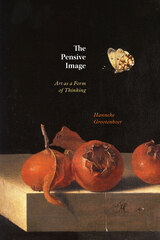 The Pensive Image: Art as a Form of Thinking
Hanneke Grootenboer
University of Chicago Press, 2020 Grootenboer considers painting as a form of thinking in itself, rather than a subject of philosophical and interpretive thought.
While the philosophical dimension of painting has long been discussed, a clear case for painting as a form of visual thinking has yet to be made. Traditionally, vanitas still life paintings are considered to raise ontological issues while landscapes direct the mind toward introspection. Grootenboer moves beyond these considerations to focus on what remains unspoken in painting, the implicit and inexpressible that manifests in a quality she calls pensiveness. Different from self-aware or actively desiring images, pensive images are speculative, pointing beyond interpretation. An alternative pictorial category, pensive images stir us away from interpretation and toward a state of suspension where thinking through and with the image can start.
In fluid prose, Grootenboer explores various modalities of visual thinking— as the location where thought should be found, as a refuge enabling reflection, and as an encounter that provokes thought. Through these considerations, she demonstrates that artworks serve as models for thought as much as they act as instruments through which thinking can take place. Starting from the premise that painting is itself a type of thinking, The Pensive Image argues that art is capable of forming thoughts and shaping concepts in visual terms.
 Pentagon Capitalism: How the Cold War US Military Modeled Itself on Private Business
A. J. Murphy
Harvard University Press A pioneering study of the Cold War military-industrial complex shows how defense leaders reorganized the US armed forces in the image of commercial enterprise.
The strategic landscape of the Cold War generated political support for a permanent US military force of unprecedented scale. Faced with the problem of managing this behemoth, leaders of the defense bureaucracy looked to private industry for inspiration: since the military now resembled a huge industrial conglomerate, they reasoned, it should be run like a business. A. J. Murphy explores the profound consequences of translating military structures of command, logistics, and warfare into capitalist terms.
In the realm of budgeting and finance, defense reformers refashioned the supply process as a buy-and-sell transaction between units, requiring officers to express their need for equipment and labor in dollar terms. Bureaucrats embraced Taylorist work measurement to supervise everything from clerical filing to the production of massive weapons systems. The services even engaged management consultants to establish officer-training academies modeled on the Harvard Business School.
After the Vietnam War, many military leaders pushed back, questioning “managerialism” and calling for a return to traditional concepts of command. Civilian critics also chimed in, protesting the callousness of the business-minded secretary of defense, Robert McNamara, who famously measured success and failure in body counts. By this time, however, the language and values of management had thoroughly infiltrated the military’s institutional structure and daily operations. As Pentagon Capitalism makes clear, the reorganization of the defense bureaucracy along the lines of a for-profit firm durably altered the experience of military work and facilitated the lasting privatization of US national security.
 Pentecostal Currents in American Protestantism
Edited by Edith L. Blumhofer, Russell P. Spittler, and Grant A. Wacker
University of Illinois Press, 1999 American Pentecostalism began as a culturally isolated sect intent upon announcing the imminence of the world's end. The sect's early millenarian fervor gradually became muted in favor of flag-waving patriotism. At the end of the twentieth century it has become an affluent, worldwide movement thoroughly entrenched in popular culture.
Edith Blumhofer uses the Assemblies of God, the largest classical Pentecostal denomination in the world, as a lens through which to view the changing nature of Anglo Pentecostalism in the United States. She illustrates how the original mission to proclaim the end resulted in the development of Bible schools, the rise of the charismatic movement, and the popularity of such figures as Aimee Semple McPherson, Charles Fox Parham, and David Du Plessis. Blumhofer also examines the sect's use of radio and television and the creation of a parallel Christian culture
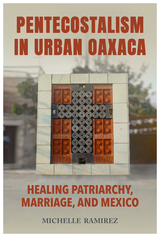 Pentecostalism in Urban Oaxaca: Healing Patriarchy, Marriage, and Mexico
Michelle Ramirez
University of Alabama Press, 2024 An ethnography focusing on a Pentecostal church community and their pursuit of healing marriages and prosperity
Pentecostalism in Urban Oaxaca is a timely feminist ethnography set in a Pentecostal church community in Oaxaca de Juarez. Based on extensive fieldwork, Michelle Ramirez skillfully melds medical anthropology with cultural analysis to reveal the Pentecostal movement’s dynamics in the contexts of faith healing, marital relations, and economic prosperity.
Ramirez takes stock of the problematic ways that Pentecostalism has played out for Mexican women today but also reminds readers of some of its successes. Within the context of Mexican patriarchy, some women parishioners in abusive relationships see the church as a way to improve their lot. Pentecostalism seeks to rupture with Mexico’s colonial heritage, and Ramirez provides novel ways for the reader to consider how Pentecostalism can provide healing for even the “endlessness of addiction.” One case study portrays a former abusive alcoholic womanizer who underwent a spiritual transformation as a result of his conversion. Through this example and more, Ramirez examines the complex relationship between gender, modernity, and Indigeneity in the context of marriage. The book also addresses the #MeToo movement as encountered in the Pentecostal church.
Finally, Ramirez investigates how Pentecostalism addresses the “curses” of illness and poverty, highlighting the paradoxical relationship between faith healing and curanderismo. The gospel of economic prosperity holds promise for a better life, breaking free from the “disease” of poverty. To this end, Ramirez profiles some parishioners’ involvement with Omnilife, a multilevel marketing company selling vitamins and natural health products that propounds ideals similar to those of Pentecostal Christianity.
Penultimate Suitor
Mary Leader
University of Iowa Press, 2001 In The Penultimate Suitor Mary Leader strips away comfortable layers of poetic self-protection to arrive at a position of acute emotional self-conflagration. Each poem turns upon and returns to the infuriating and glorious correlations between love and art. Learning to love, learning to make art, trying to make beauty, trying to be a beauty-all these efforts call for passionate explorations in the schools of art and love.
Penumbra: Poems
Michael Shewmaker
Ohio University Press, 2017 Penumbra—Michael Shewmaker’s debut collection—explores the half-shadows of a world torn between faith and doubt. From intricate descriptions of the rooms in a dollhouse, to the stark depiction of a chapel made of bones, from pre-elegies for a ghostly father, to his compelling treatment of his obsessed, human characters (a pastor, a tattoo artist, a sleepwalker, to name only a few), these are poems that wrestle with what it means to believe in something beyond one’s own mortality. Learned and formally adept, these poems consist of equal parts praise and despair. They announce Shewmaker as an important new voice in American poetry.
Penury
Myung Mi Kim
Omnidawn, 2009 In Penury, Myung Mi Kim probes sanctioned norms of cognition by breaking communication into its most discrete components. With these irruptions and suspensions, she writes into extremes of forced loss, violence, and impoverishment. Exposing latent relations in sound and sense, Kim proposes how new ethical awareness can be encountered where the word and its meaning/s are formed. Here, language is not offered as transparent communication of ideas, but as testament to and disruption of oppressive dominant concepts and cultural practices. "Penury" means poverty, but in this text's radical relation to lack, we hear the most elemental and active forms of change.
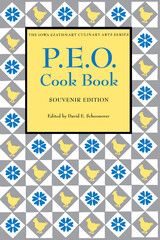 P.E.O. Cookbook: Souvenir Edition
David E. Schoonover
University of Iowa Press, 1992 In 1908 members of Chapter "M" of the P.E.O. in Knoxville, Iowa, compiled the P.E.O. Cook Book: Souvenir Edition, complete with 575 of the organization's best recipes, fully tested, and 24 original photographs of the Knoxville community. Now this charming cookbook, long out of print, is made available again in a facsimile edition as part of the Iowa Szathmáry Culinary Arts Series. The recipes in this remarkable cookbook take the modern cook back to a time when the ability to prepare attractive, delicious dishes with economy and innovation from a sometimes limited supply of ingredients was both a challenge and a major source of pride. The P.E.O. Cook Book reproduces the cream of the crop: unusual dishes such as Kebobbed Oysters, Oyster Short Cake ("If this is carefully made it is delicious"), Green Corn Balls, Tomatoes Stuffed with Eggs, Nice Candy, and the requisite P.E.O. Salad, in the club's colors of yellow and white. Club members present tasty renditions of familiar themes in breads, meats, soups, salads, condiments, and desserts and several dishes that are extraordinarily thrifty. Here are honest, forthright recipes that modern readers will thoroughly enjoy. A familiar feature in many towns, the P.E.O. Sisterhood was founded in 1869 at Iowa Wesleyan College in Mt. Pleasant, Iowa. The meaning of the club's initials remains a closely guarded secret, but the P.E.O. now stands some 240,000 strong and is a worldwide philanthropic educational organization with projects on the international, national, state, and local levels.
Peonies of the World: Part III Phylogeny and Evolution
De-Yuan Hong
Royal Botanic Gardens, Kew, 2021 A richly illustrated source of information on the phylogeny and evolution of peonies.
De-Yuan Hong’s three-volume monograph of the popular genus Paeonia—more popularly known as peonies—is a comprehensive taxonomic revision based on extensive field observations, population sampling, and a thorough multidisciplinary examination of more than 5,000 specimens. This third and final volume is a rich source of information on the phylogeny and evolution of peonies, illustrated with photographs, line drawings, and maps, making it an essential reference for trained botanists and amateur gardening hobbyists alike.
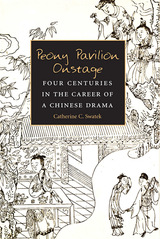 Peony Pavilion Onstage: Four Centuries in the Career of a Chinese Drama
Catherine C. Swatek
University of Michigan Press, 2012 After its completion in 1598, The Peony Pavilion (Mudan ting) began a four-hundred-year course of transmission and dissemination in China and around the world. Within China, the play’s wide popularity propelled its appearance in numerous editions, adaptations, and libretti. Performances ranged from “pure singing” at private gatherings to full stagings in commercial theaters. As the crown jewel of Kun opera reportoire, Mudan ting has a richly documented history and lends itself to careful study. In the late twentieth century, however, classical Kun opera is on the verge of extinction in China, and creative talent is gravitating to centers outside China’s mainland. In 1998, the play was reintroduced to audiences in Europe and North America in various versions, adding new chapters to the story of the work. Peony Pavilion Onstage examines Tang Xianzu’s classic play from three distinct viewpoints: public-literati playwrights; professional performers of Kun opera; and quite recently, directors and audiences outside China. Catherine Swatek first examines two adaptations of the play by Tang's contemporaries, which point to the unconventionality of the original work. She goes on to explore how the play has been changed in later adaptations, up to its most recent productions by Peter Sellars and Chen Shi-Zheng in the United States and Europe. Peony Pavilion Onstage is essential reading for scholars and performers of this masterpiece and other great works of Chinese drama.
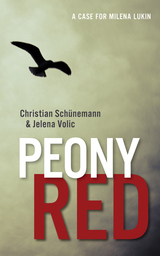 Peony Red: A Case for Milena Lukin
Christian Schünemann and Jelena Volic
Haus Publishing, 2018 In the Balkans, there is a saying: only where the ground was once soaked with blood will the peony bloom with its full, dizzying red.
When a young couple is murdered in their home in Kosovo, police are perplexed: there seems to be no motive. But when Milena Lukin’s uncle realizes that the murdered woman was his first love, his niece decides to investigate. All too soon, she is embroiled in the twisted world of Balkan politics, where the past always weighs heavy on the present, and nowhere more so than in her hometown of Belgrade. Old prejudices and new hatreds, merciless profiteers and mendacious politicians—all come together to try to keep Lukin from finding the truth.
A fast-paced, deftly told thriller Peony Red drops readers into the murky Balkan underworld. Fortunately, in Milena Lukin, they have a strong, capable, no-nonsense guide, one whose adventures will always keep the pages turning.
 The People
Jules Michelet
University of Illinois Press, 1973 "If we wish to know the innermost thought and passion of the French peasant, it is very easy. Walk, any Sunday, into the country and follow him." So begins this extraordinary book by the man often called France's greatest historian. After its publication in 1846, Le peuple sold 1,000 copies in a single day in Paris alone, and was soon considered the classic study of French society in the early nineteenth century. John P. McKay's translation makes the book newly available to English-language readers.
The People is a moving picture of France on the eve of 1848. Michelet saw tensions, divisions, and hatreds tearing France apart, and he sought to provide a new faith that would unite the conflicting groups in the love of country.
This book, Michelet wrote, "is the product of my experience rather than of my studies. I have derived it from my observation and my conversations with friends and neighbors." Because of Michelet's countless discussions with people from all ranks of society and his precise observations, his portrait of France is unsurpassed, and representative of general European problems in a time of rapid social and economic change.
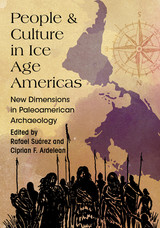 People and Culture in Ice Age Americas: New Dimensions in Paleoamerican Archaeology
Rafael Suarez and Ciprian F. Ardelean
University of Utah Press, 2018 This edited volume, which emerged from a symposium organized at the 2014 SAA meeting in Austin, Texas, covers recent Paleoamerican research and site excavations from Patagonia to Canada. Contributors discuss the peopling of the Americas, early American assemblages, lifeways, and regional differences. Many scholars present current data previously unavailable in English. Chapters are organized south to north in an attempt to shake the usual north-centric focus of Pleistocene–Early Holocene archaeological studies and to bring to the forefront the many fascinating discoveries being made in southern latitudes. The diversity of approaches over a large geographic expanse generates discussion that prompts a re-evaluation of predominant paradigms about how the expansion of Homo sapiens in the Western Hemisphere took place. Those who work in Paleoamerican studies will embrace this book for its new data and for its comparative look at the Americas.
People and Places of Nature and Culture
Rod Giblett
Intellect Books, 2011 Using the rich and vital Australian Aboriginal understanding of country as a model, People and Places of Nature and Culture affirms the importance of a sustainable relationship between nature and culture. While current thought includes the mistaken notion—perpetuated by natural history, ecology, and political economy—that humans have a mastery over the Earth, this book demonstrates the problems inherent in this view. In the current age of climate change, this is an important appraisal of the relationship between nature and culture, and a projection of what needs to change if we want to achieve environmental stability.
People and Places of the Roman Past: The Educated Traveller's Guide
Peter Hatlie
Arc Humanities Press, 2019 Written by scholars who specialize in Roman history, religion, and culture, this book is written for travellers in search of inspiration and learning as they tour the streets, churches, museums, and monuments of the Roman past. Combining biographical portraits of some of Rome’s most significant historical figures with a study of the monuments, artworks, and places associated with them, <i>People and Places of the Roman Past</i> offers an informative and insightful look at the human and cultural history of one of the great cities of the world.
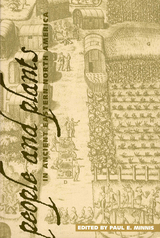 People and Plants in Ancient Eastern North America
Edited by Paul E. Minnis
University of Arizona Press, 2003 The environmental diversity of North America is astounding—from the circumpolar tundra with few plants more than a few centimeters tall to the lush, semitropical forests of the southeastern United States and Caribbean Basin. No less remarkable is the record of plants usage by the various indigenous people who have been living there for more than twelve millennia. For the vast majority of this time, their livelihood—food, shelter, fuel, and medicine—depended on their knowledge and use of the environment.
The most comprehensive overview in more than half a century about the interconnectedness of prehistoric Native Americans and their botanical world, this book and its forthcoming companion volume, People and Plants in Ancient Western North America, present the latest information on three major topics: the use of native plants, the history of crops and their uses, and how humans affected their environment. In this volume, expert scholars summarize the prehistoric ethnobotany of four regions: the Eastern Woodlands (W. Cowan, K. Gremillion, M. Scarry, B. Smith, and G. Wagner), Northeast (G. Crawford and D. Smith), Plains (M. Adair), and Caribbean (L. Newsom and D. Pearsall).
This volume contributes significantly to our understanding of the lives of prehistoric people as well as the forces that influenced their communities, their ingenuity, and their ecological impact. It also serves as a guide for designing environmentally sustainable lives today.
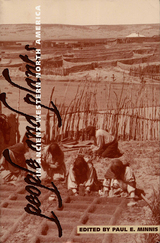 People and Plants in Ancient Western North America
Edited by Paul E. Minnis
University of Arizona Press, 2004 The environmental diversity of North America is astounding—from circumpolar tundra with a small number of plants more than a few centimeters tall to the lush semitropical forests of the southeastern United States and the Caribbean Basin. No less remarkable is the record of plant usage by the various indigenous peoples who have been living here for more than 12,000 years. For the vast majority of this time, their livelihood—food, shelter, fuel, and medicine—depended on their knowledge and use of the plants that surrounded them.
The most comprehensive overview in more than half a century on the interconnectedness of people and plants, this book and its companion volume, People and Plants in Ancient Eastern North America, present the latest information on three major topics: the uses of native plants, the history of crops and their uses, and the impact of humans on their environment. They not only contribute to our understanding of the lives of prehistoric people but also serve as guides for designing sustainable living today.
People and Power in Byzantium: An Introduction to Modern Byzantine Studies
Alexander Kazhdan and Giles Constable
Harvard University Press, 1982 This introduction to modern Byzantine studies seeks to understand the pressures that shaped Byzantine culture and people, including not only the powerful but also the poor, humble, and uneducated. Investigating the past in all its complexity and contradictions, Alexander Kazhdan and Giles Constable approach Homo byzantinus from various perspectives—position in society, relation to power, attitudes toward material environment, self-image, and image of God—to show what was distinctive about the people of the Byzantine Empire and their civilization. People and Power in Byzantium challenges Byzantinists to ask new questions and introduce new methods and perspectives in order to understand how Byzantine society worked and how this understanding can help in appreciating the modern world.
People and Power in Byzantium: An Introduction to Modern Byzantine Studies
Alexander Kazhdan and Giles Constable
Harvard University Press This introduction to modern Byzantine studies seeks to understand the pressures that shaped Byzantine culture and people, including not only the powerful but also the poor, humble, and uneducated. Investigating the past in all its complexity and contradictions, Alexander Kazhdan and Giles Constable approach Homo byzantinus from various perspectives—position in society, relation to power, attitudes toward material environment, self-image, and image of God—to show what was distinctive about the people of the Byzantine Empire and their civilization. People and Power in Byzantium challenges Byzantinists to ask new questions and introduce new methods and perspectives in order to understand how Byzantine society worked and how this understanding can help in appreciating the modern world.
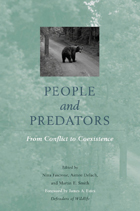 People and Predators: From Conflict To Coexistence
Edited by Nina Fascione, Aimee Delach, and Martin E. Smith
Island Press, 2005 Carnivores provide innumerable ecological benefits and play a unique role in preserving and maintaining ecosystem services and function, but at the same time they can create serious problems for human populations. A key question for conservation biologists and wildlife managers is how to manage the world's carnivore populations to conserve this important natural resource while mitigating harmful impacts on humans. In People and Predators, leading scientists and researchers offer case studies of human-carnivore conflicts in a variety of landscapes, including rural, urban, and political. The book covers a diverse range of taxa, geographic regions, and conflict scenarios, with each chapter dealing with a specific facet of human-carnivore interactions and offering practical, concrete approaches to resolving the conflict under consideration. Chapters provide background on particular problems and describe how challenges have been met or what research or tools are still needed to resolve the conflicts. People and Predators will helps readers to better understand issues of carnivore conservation in the 21st century, and provides practical tools for resolving many of the problems that stand between us and a future in which carnivores fulfill their historic ecological roles.
 People and Predicaments
Milton Mazer
Harvard University Press, 1976 This is the compelling story of an experiment begun in 1961 that eventually affected the lives of almost all of the residents of the island of Martha's Vineyard. The author writes engagingly of the island and its year-round inhabitants, a community of some seven thousand persons of diverse ethnic and social backgrounds.
With sympathy and insight Milton Mazer analyzes the stresses that are peculiar to the conditions of life on the island, and he describes the kinds of psychological disorders that are precipitated by those stresses. He reports, without technical jargon, the results of a five-year study of a great variety of psychosocial predicaments experienced by the people of the island. Finally he examines the catalytic effect the mental health center and its research findings have had on the development of other supportive agencies and how the community established a network of human services to meet its needs.
The work clearly demonstrates that striking advances can be made by a mental health program that is informed by an understanding of the community served. The book will stand as a model for future studies in this area.
The People and the King: The Comunero Revolution in Colombia, 1781
John Leddy Phelan
University of Wisconsin Press, 1978 In The People and the King, John Leddy Phelan reexamines a well-known but long misunderstood event in eighteenth-century Colombia. When the Spanish colonial bureaucratic system of conciliation broke down, indigenous groups resorted to armed revolt to achieve their political ends.
As Phelan demonstrates in these pages, the crisis of 1781 represented a constitutional clash between imperial centralization and colonial decentralization. Phelan argues that the Comunero revolution was not, as it has often been portrayed, a precursor of political independence, nor was it a frustrated social upheaval. The Comunero leaders and their followers did not advocate any basic reordering of society, Phelan concludes, but rather made an appeal for revolutionary reform within a traditionalist framework.
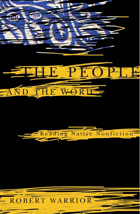 The People and the Word: Reading Native Nonfiction
Robert Warrior
University of Minnesota Press, 2005 Much literary scholarship has been devoted to the flowering of Native American fiction and poetry in the mid-twentieth century. Yet, Robert Warrior argues, nonfiction has been the primary form used by American Indians in developing a relationship with the written word, one that reaches back much further in Native history and culture.
Focusing on autobiographical writings and critical essays, as well as communally authored and political documents, The People and the Word explores how the Native tradition of nonfiction has both encompassed and dissected Native experiences. Warrior begins by tracing a history of American Indian writing from the eighteenth century to the late twentieth century, then considers four particular moments: Pequot intellectual William Apess’s autobiographical writings from the 1820s and 1830s; the Osage Constitution of 1881; narratives from American Indian student experiences, including accounts of boarding school in the late 1880s; and modern Kiowa writer N. Scott Momaday’s essay “The Man Made of Words,” penned during the politically charged 1970s. Warrior’s discussion of Apess’s work looks unflinchingly at his unconventional life and death; he recognizes resistance to assimilation in the products of the student print shop at the Santee Normal Training School; and in the Osage Constitution, as well as in Momaday’s writing, Warrior sees reflections of their turbulent times as well as guidance for our own.
Taking a cue from Momaday’s essay, which gives voice to an imaginary female ancestor, Ko-Sahn, Warrior applies both critical skills and literary imagination to the texts. In doing so, The People and the Word provides a rich foundation for Native intellectuals’ critical work, deeply entwined with their unique experiences.
Robert Warrior is professor of English and Native American studies at the University of Oklahoma. He is author of Tribal Secrets: Recovering American Indian Intellectual Traditions (Minnesota, 1994) and coauthor, with Paul Chaat Smith, of Like a Hurricane: The Indian Movement from Alcatraz to Wounded Knee.
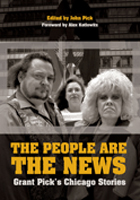 The People Are the News: Grant Pick’s Chicago Stories
John Pick
Northwestern University Press, 2009 This distinctive collection features writings from Grant Pick’s long, distinguished career in literary journalism. Pick had a uniquely open eye and ear for people who were in difficult situations, doing extraordinary things, or both. Most of his stories focus on interesting but overlooked Chicagoans, like the struggling owner of a laundrymat on the west side or the successful doctor who, as he faced his own death from cancer, strove to enlighten his colleagues in the field of medicine. As only a lifetime Chicagoan could, he described in tender detail the worlds in which people lived or worked, providing a look not just at one city’s citizens but at humanity as a whole.
Pick’s widow and son curate this showcase of some of his most well-remembered work, such as “The Rag Man of Lincoln Park” and “Brother Bill.” In these and all of his other works, Pick wrote from the front lines, speaking to people whom others might encounter everyday but never really see. He faithfully characterized his subjects, never denying them dignity or value and never judging them. In the mirror he held up to his city, Chicago could see the shared humanity of all its citizens.
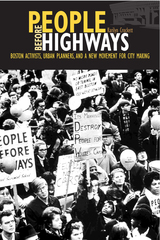 People before Highways: Boston Activists, Urban Planners, and a New Movement for City Making
Karilyn Crockett
University of Massachusetts Press, 2018 A landmark fight for urban justice that changed whose voices shape our cities
In 1948, inspired by changes to federal law, Massachusetts government officials started hatching a plan to build multiple highways circling and cutting through the heart of Boston, making steady progress through the 1950s. But when officials began to hold public hearings in 1960, as it became clear what this plan would entail—including a disproportionate impact on poor communities of color—the people pushed back. Activists, many with experience in the civil rights and antiwar protests, began to organize.
Linking archival research, ethnographic fieldwork, and oral history, Karilyn Crockett in People before Highways offers ground-level analysis of the social, political, and environmental significance of a local anti-highway protest and its lasting national implications. The story of how an unlikely multiracial coalition of urban and suburban residents, planners, and activists emerged to stop an interstate highway is one full of suspenseful twists and surprises, including for the actors themselves. And yet, the victory and its aftermath are undeniable: federally funded mass transit expansion, a linear central city park, and a highway-less urban corridor that serves as a daily reminder of the power and efficacy of citizen-led city making.
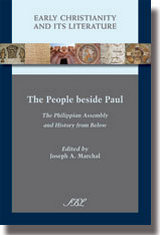 The People beside Paul: The Philippian Assembly and History from Below
Joseph A. Marchal
SBL Press, 2015 Who are the people beside Paul, and what can we know about them?
This volume brings together an international and interdisciplinary group of scholars with a broad range of expertise and a common interest: Philippi in antiquity. Each essay engages one set of contextual particularities for Paul and the ordinary people of the Philippian assembly, while simultaneously placing them in wider settings. This 'people's history' uses both traditional and more cutting-edge methods to reconsider archaeology and architecture, economy and ethnicity, prisons and priestesses, slavery, syncretism, stereotypes of Jews, the colony of Philippi, and a range of communities. The contributors are Valerie Abrahamsen, Richard S. Ascough, Robert L. Brawley, Noelle Damico, Richard A. Horsley, Joseph A. Marchal, Mark D. Nanos, Peter Oakes, Gerardo Reyes Chavez, Angela Standhartinger, Eduard Verhoef, and Antoinette Clark Wire.
Features
- An examination of the social forms and forces that shaped and affected the Philippian church
- Essays offer insight into standard questions about the letter s hymn and audience, Paul's 'opponents,' and the sites of the community and of Paul's imprisonment
- A focused exploration of more marginalized topics and groups, including women, slaves, Jews, and members of localized cults
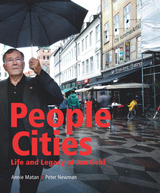 People Cities: The Life and Legacy of Jan Gehl
Annie Matan and Peter Newman
Island Press, 2016 “A good city is like a good party—you stay for longer than you plan,” says Danish architect Jan Gehl. He believes that good architecture is not about form, but about the interaction between form and life. Over the last 50 years, Gehl has changed the way that we think about architecture and city planning—moving from the Modernist separation of uses to a human-scale approach inviting people to use their cities.
At a time when growing numbers are populating cities, planning urban spaces to be humane, safe, and open to all is ever-more critical. With the help of Jan Gehl, we can all become advocates for human-scale design. Jan’s research, theories, and strategies have been helping cities to reclaim their public space and recover from the great post-WWII car invasion. His work has influenced public space improvements in over 50 global cities, including New York, London, Moscow, Copenhagen, Melbourne, Sydney, and the authors’ hometown of Perth.
While much has been written by Jan Gehl about his approach, and by others about his influence, this book tells the inside story of how he learned to study urban spaces and implement his people-centered approach.
People Cities discusses the work, theory, life, and influence of Jan Gehl from the perspective of those who have worked with him across the globe. Authors Matan and Newman celebrate Jan's role in changing the urban planning paradigm from an abstract, ideological modernism to a people-focused movement. It is organized around the creation of that movement, using key periods in Jan’s working life as a structure.
People Cities will inspire anyone who wants to create vibrant, human-scale cities and understand the ideas and work of an architect who has most influenced how we should and can design cities for people.
A People Divided: Judaism in Contemporary America
Jack Wertheimer
Brandeis University Press, 1997 This brilliant analysis of American Judaism in the last half of the 20th century won the 1993-94 National Jewish Book Award for the best book on contemporary Jewry and also was named an Outstanding Book of 1993 by Choice. Jack Wertheimer examines how fundamental changes in American society have affected Jewish religious and communal life, paying special attention to contradictions and schisms that threaten the integrity of American Jewish practices and beliefs. A People Divided remains an essential primer for anyone interested in the ongoing debate about what constitutes Jewishness and who is a Jew.
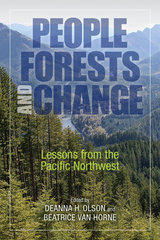 People, Forests, and Change: Lessons from the Pacific Northwest
Edited by Deanna H. Olson and Beatrice Van Horne
Island Press, 2017 We owe much of our economic prosperity to the vast forested landscapes that cover the earth. The timber we use to build our homes, the water we drink, and the oxygen in the air we breathe come from the complex forested ecosystem that many of us take for granted. As urban boundaries expand and rural landscapes are developed, forests are under more pressure than ever. It is time to forgo the thinking that forests can be managed outside of human influence, and shift instead to management strategies that consider humans to be part of the forest ecosystem. Only then can we realistically plan for coexisting and sustainable forests and human communities in the future.
In People, Forests, and Change: Lessons from the Pacific Northwest, editors Deanna H. Olson and Beatrice Van Horne have assembled an expert panel of social and forest scientists to consider the nature of forests in flux and how to best balance the needs of forests and the rural communities closely tied to them. The book considers the temperate moist-coniferous forests of the US Pacific Northwest, but many of the concepts apply broadly to challenges in forest management in other regions and countries. In the US northwest, forest ecosystem management has been underway for two decades, and key lessons are emerging. The text is divided into four parts that set the stage for forests and rural forest economies, describe dynamic forest systems at work, consider new science in forest ecology and management, and ponder the future for these coniferous forests under different scenarios.
People, Forests, and Change brings together ideas grounded in science for policy makers, forest and natural resource managers, students, and conservationists who wish to understand how to manage forests conscientiously to assure their long-term viability and that of human communities who depend on them.
The People from Heaven
John Sanford
University of Illinois Press, 1996 An extraordinary novel, told partly in verse, The People from Heaven takes place in 1943 in Warrensburg, New York, where Eli Bishop, a white shopkeeper, initiates a reign of terror on the populace following his rape of America Smith, a black woman. The author, John Sanford, is considered by many to be one of the finest little-known writers of the twentieth century. In his introduction, Alan Wald provides an overview of Sanford's career, his art, and his politics.
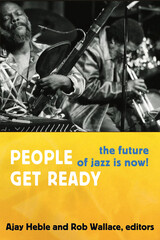 People Get Ready: The Future of Jazz Is Now!
Ajay Heble and Rob Wallace, eds.
Duke University Press, 2013 In People Get Ready, musicians, scholars, and journalists write about jazz since 1965, the year that Curtis Mayfield composed the famous civil rights anthem that gives this collection its title. The contributors emphasize how the political consciousness that infused jazz in the 1960s and early 1970s has informed jazz in the years since then. They bring nuance to historical accounts of the avant-garde, the New Thing, Free Jazz, "non-idiomatic" improvisation, fusion, and other forms of jazz that have flourished since the 1960s, and they reveal the contemporary relevance of those musical practices. Many of the participants in the jazz scenes discussed are still active performers. A photographic essay captures some of them in candid moments before performances. Other pieces revise standard accounts of well-known jazz figures, such as Duke Ellington, and lesser-known musicians, including Jeanne Lee; delve into how money, class, space, and economics affect the performance of experimental music; and take up the question of how digital technology influences improvisation. People Get Ready offers a vision for the future of jazz based on an appreciation of the complexity of its past and the abundance of innovation in the present.
Contributors. Tamar Barzel, John Brackett, Douglas Ewart, Ajay Heble, Vijay Iyer, Thomas King, Tracy McMullen, Paul D. Miller/DJ Spooky, Nicole Mitchell, Roscoe Mitchell, Famoudou Don Moye, Aldon Lynn Nielsen, Eric Porter, Marc Ribot, Matana Roberts, Jaribu Shahid, Julie Dawn Smith, Wadada Leo Smith, Alan Stanbridge, John Szwed, Greg Tate, Scott Thomson, Rob Wallace, Ellen Waterman, Corey Wilkes
People Habitat: 25 Ways to Think About Greener, Healthier Cities
F. Kaid Benfield
Island Press, 2014 With over 80 percent of Americans now living in cities and suburbs, getting our communities right has never been more important, more complicated, or more fascinating. Longtime sustainability leader Kaid Benfield shares 25 enlightening and entertaining essays about the wondrous ecology of human settlement, and how to make it better for both people and the planet.
People Habitat explores topics as diverse as “green” housing developments that are no such thing, the tricky matter of gentrifying inner cities, why people don’t walk much anymore, and the relationship between cities and religion. Written with intellect, insight, and from-the-heart candor, each real-world story in People Habitat will make you see our communities in a new light.
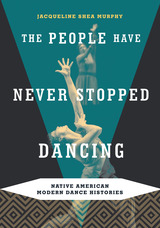 The People Have Never Stopped Dancing: Native American Modern Dance Histories
Jacqueline Shea Murphy
University of Minnesota Press, 2007 During the past thirty years, Native American dance has emerged as a visible force on concert stages throughout North America. In this first major study of contemporary Native American dance, Jacqueline Shea Murphy shows how these performances are at once diverse and connected by common influences. Demonstrating the complex relationship between Native and modern dance choreography, Shea Murphy delves first into U.S. and Canadian federal policies toward Native performance from the late nineteenth through the early twentieth centuries, revealing the ways in which government sought to curtail authentic ceremonial dancing while actually encouraging staged spectacles, such as those in Buffalo Bill’s Wild West shows. She then engages the innovative work of Ted Shawn, Lester Horton, and Martha Graham, highlighting the influence of Native American dance on modern dance in the twentieth century. Shea Murphy moves on to discuss contemporary concert dance initiatives, including Canada’s Aboriginal Dance Program and the American Indian Dance Theatre. Illustrating how Native dance enacts, rather than represents, cultural connections to land, ancestors, and animals, as well as spiritual and political concerns, Shea Murphy challenges stereotypes about American Indian dance and offers new ways of recognizing the agency of bodies on stage. Jacqueline Shea Murphy is associate professor of dance studies at the University of California, Riverside, and coeditor of Bodies of the Text: Dance as Theory, Literature as Dance.
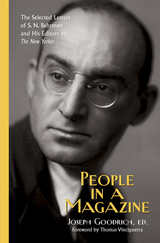 People in a Magazine: The Selected Letters of S. N. Behrman and His Editors at "The New Yorker"
Joseph Goodrich
University of Massachusetts Press, 2018 Playwright, biographer, screenwriter, and critic S. N. Behrman (1893–1973) characterized the years he spent writing for The New Yorker as a time defined by “feverish contact with great theatre stars, rich people and social people at posh hotels, at parties, in mansions and great estates.” While he hobnobbed with the likes of Mary McCarthy, Elia Kazan, and Greta Garbo and was one of Broadway's leading luminaries, Behrman would later admit that the friendships he built with the magazine's legendary editors Harold Ross, William Shawn, and Katharine S. White were the “one unalloyed felicity” of his life.
People in a Magazine collects Behrman's correspondence with his editors along with telegrams, interoffice memos, and editorial notes drawn from the magazine's archives—offering an unparalleled view of mid-twentieth-century literary life and the formative years of The New Yorker, from the time of Behrman's first contributions to the magazine in 1929 until his death.
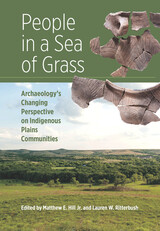 People in a Sea of Grass: Archaeology's Changing Perspective on Indigenous Plains Communities
Edited by Matthew E. Hill and Lauren W. Ritterbush
University of Utah Press, 2021 Ninety years ago Great Plains archaeologists such as Waldo Wedel and William Duncan Strong made foundational contributions to American archaeology, enabling new discoveries, insights, and interpretations. This volume explores how twenty-first-century archaeologists have built upon, remodeled, and sometimes rejected the inferences of these earlier scholars with updated overviews and analyses.
Contributors highlight how Indigenous Plains groups participated in large-scale social networks in which ideas, symbols, artifacts, and people moved across North America over the last 2,000 years. They also discuss cultural transformation, focusing on key demographic, economic, social, and ceremonial factors associated with change, including colonization and integration into the social and political economies of transatlantic societies. Cultural traditions covered include Woodland-era Kansas City Hopewell, late prehistoric Central Plains tradition, and ancestral and early historic Wichita, Pawnee and Arikara, Kanza, Plains Apache, and Puebloan migrants. As the first review of Plains archaeology in more than a decade, this book brings studies of early Indigenous
peoples of the central and southern Plains into a new era.
People in Control: Human factors in control room design
Jan Noyes
The Institution of Engineering and Technology, 2001 As industrial processes have become more automated, there is increasing concern about the performance of the people who control these systems. Human error is increasingly cited as the cause of accidents across many sectors of industry.
 People in Spite of History: Stories Found in an Attorney Archive in the Banat Region
Richard Buxbaum
Central European University Press, 2021 Three generations of a family of lawyers have run a firm founded in 1893 in the small city of Becskerek (today in Serbian Zrenjanin), first part of the Austro-Hungarian Habsburg monarchy, then Hungary, then Yugoslavia, then for a while under German occupation, then again part of Yugoslavia and finally Serbia. In the Banat district of the province of Vojvodina, the multiplicity of languages and religions and changes of place-names was a matter of course. What is practically unprecedented, all files, folders and documents of the law office have survived. They concern marriages, divorces, births and testaments, as well as expulsions, emigrations, incarcerations and releases of these largely rural and small-town dwellers. Mundane cases reflect times through war, peace, revolution and counter-revolution, through serfdom and freedom, through comfort and poverty. The files also show everyday lives shaped in spite of history. Tibor Várady transforms them into affecting and vivid vignettes, selecting and commenting without sentimentality but with empathy. The law office of the three generations of the Várady family demonstrates that the legal profession permits and in difficult times even requires its members to defend the ordinary men and women against the powers of state and society.
The People Named The Chippewa: Narrative Histories
Gerald Vizenor Vizenor
University of Minnesota Press, 1984 Ranging in time and space from Madeline Island and the reservations of northern Minnesota to the urban reservation of Minneapolis-St. Paul, Vizenor recounts the experiences of the Chippewa and their encounters with the white people who "named" them. "Through some very funny moments, Vizenor raises serious questions for the pan-Indian movements and 'radical' academics. A teacher and scholar wishing to avoid and to correct the mistakes of twentieth-century scholarship in discussing 'Indians,' 'Native Americans' or 'Amerindians' would do well to begin with these stories; they are the strength of the Anishinaabeg." World Literature Today
 The People of Alor: A Social-Psychological Study of an East Indian Island
Cora Du Bois
University of Minnesota Press, 1944
The People of Alor was first published in 1944. Minnesota Archive Editions uses digital technology to make long-unavailable books once again accessible, and are published unaltered from the original University of Minnesota Press editions.A trained psychologist and anthropologist, Dr. Cora Du Bois spent a year and a half on Alor, a Netherlands East Indies island, collecting the material presented in this volume. On her arrival on Alor Du Bois, already equipped with a working knowledge of Dutch and Malay, quickly learned the language of the Alorese and, by administering simple medical aid, gained the confidence and interest of the villagers. An important feature of Du Bois’ work is the use of modern psychological techniques, among which are the Porteus Maze tests and the Rorschach test.During her stay on Alor, Dr. Du Bois obtained detailed autobiographies of eight Alorese men and women – filling what Dr. Abram Kardiner calls “the lamentable gap in the study of the relationship between personality and culture.”Aided by grants from both the American Council of Learned Societies and the Coolidge Foundation, the publication of Du Bois’ study represents a contribution not only to anthropology, but to psychology and, less directly but significantly, to economics and political science. Enlightened administrators of the post-war era will also find this study of value, offering as it does, background for the better psychological understanding of primitive people.
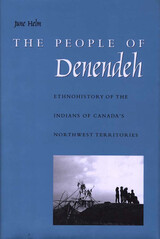 The People of Denendeh: Ethnohistory of the Indians of Canada's Northwest Territories
June Helm
University of Iowa Press, 2000 For fifty years anthropologist June Helm studied the culture and ethnohistory of the Dene, “The People,” the Athapaskan-speaking Indians of the Mackenzie River drainage of Canada's western subarctic. Now in this impressive collection she brings together previously published essays—with updated commentaries where necessary—unpublished field notes, archival documents, supplementary essays and notes from collaborators, and narratives by the Dene themselves as an offering to those studying North American Indians, hunter-gatherers, and subarctic ethnohistory and as a historical resource for the people of all ethnicities who live in Denendeh, Land of the Dene. Helm begins with a broad-ranging, stimulating overview of the social organization of hunter-gatherer peoples of the world, past and present, that provides a background for all she has learned about the Dene. The chapters in part 1 focus on community and daily life among the Mackenzie Dene in the middle of the twentieth century. After two historical overview chapters, Helm moves from the early years of the twentieth century to the earliest contacts between Dene and white culture, ending with a look at the momentous changes in Dene-government relations in the 1970s. Part 3 considers traditional Dene knowledge, meaning, and enjoyments, including a chapter on the Dogrib hand game. Throughout, Helm's encyclopedic knowledge combines with her personal interactions to create a collection that is unique in its breadth and intensity.
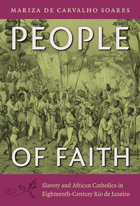 People of Faith: Slavery and African Catholics in Eighteenth-Century Rio de Janeiro
Mariza de Carvalho Soares
Duke University Press, 2011 In People of Faith, Mariza de Carvalho Soares reconstructs the everyday lives of Mina slaves transported in the eighteenth century to Rio de Janeiro from the western coast of Africa, particularly from modern-day Benin. She describes a Catholic lay brotherhood formed by the enslaved Mina congregants of a Rio church, and she situates the brotherhood in a panoramic setting encompassing the historical development of the Atlantic slave trade in West Africa and the ethnic composition of Mina slaves in eighteenth-century Rio. Although Africans from the Mina Coast constituted no more than ten percent of the slave population of Rio, they were a strong presence in urban life at the time. Soares analyzes the role that Catholicism, and particularly lay brotherhoods, played in Africans’ construction of identities under slavery in colonial Brazil. As in the rest of the Portuguese empire, black lay brotherhoods in Rio engaged in expressions of imperial pomp through elaborate festivals, processions, and funerals; the election of kings and queens; and the organization of royal courts. Drawing mainly on ecclesiastical documents, Soares reveals the value of church records for historical research.
People of Pascua
Edward H. Spicer; Edited by Kathleen M. Sands and Rosamond B. Spicer
University of Arizona Press, 1988 “[People of Pascua] sketches the history and culture of the Tucson area Yaqui and contains case studies of a number of the informants. What constituted ‘Yaquiness’ in Pascua was mainly a common language, a shared historical tradition, and an aberrant form of Catholic Christianity laced with Yaqui concepts. This clearly and concisely written book is very important in its own terms both as an early example of the use of life histories in ethnology and as a significant contribution to Yaqui studies.”—Choice
People of Plenty: Economic Abundance and the American Character
David M. Potter
University of Chicago Press, 1954 The classic account of how the American people have been shaped by abundance.
America has long been famous as a land of plenty, but we seldom realize how much the American people are a people of plenty—a people whose distinctive character has been shaped by economic abundance. In this important book, David M. Potter breaks new ground both in the study of this phenomenon and in his approach to the question of national character. He brings a fresh historical perspective to bear on the vital work done in this field by anthropologists, social psychologists, and psychoanalysts.
People of Prowess: Sport, Leisure, and Labor in Early Anglo-America
Nancy L. Struna
University of Illinois Press, 1996 Americans have revered prowess in sports going back to the seventeenth and eighteenth centuries. Nancy L. Struna explores the significance, meaning, and structure of competitive matches and displays of physical prowess for both men and women in colonial culture. Engrossingly written for the general reader as well as sport and leisure historians, People of Prowess is a pioneering work that explores a rarely examined area of colonial history and society.
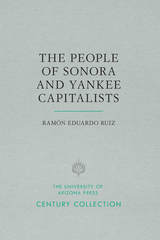 The People of Sonora and Yankee Capitalists
Ramón Eduardo Ruiz
University of Arizona Press, 1988 Capitalism, the economic system of Western Europe and the United States at the turn of the century, had a major impact on every country of the Third World. In the Western Hemisphere, no country escaped its influence, particularly the North American version, increasingly omnipotent. Mexico, next door to the powerful colossus, often felt the brunt of that impact. The People of Sonora and Yankee Capitalists examines how the advent of North American dollars between 1882 and 1910 helped reshape the economic, social, and political contours of a Mexican province on the border of Arizona. The activity of Yankee promoters, particularly miners, land speculators, and cattle barons, altered dramatically the colonial structure left behind by its former Spanish masters. Even the psychology of the inhabitants of Sonora underwent a kind of metamorphosis. This book, in short, explains what happened to Mexico’s traditional society when Yankee capitalists made their appearance.
The People of the Abyss
Jack London
Pluto Press, 2001 The People of the Abyss is a classic work about poverty and recounts the time the author spent in London. Born in San Francisco, he became a political activist and socialist at an early age. Written after posing as an American sailor stranded in the East End of London during 1902 - sleeping in doss houses, living with the destitute and starving - this is perhaps Jack London’s most important work.
As well as being a literary masterpiece, The People of the Abyss stands as a major sociological study. While other American writers were blindly celebrating the glories of the British Empire at its peak, Jack London was asking why such misery was to be found in the heart of a capital city of immense wealth.
This is a work of reportage - London lets his observations speak for themselves. A precursor to the writings of George Orwell, this book remains a standard-bearer critique of capitalism, as powerful today as it was then.
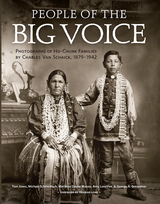 People of the Big Voice: Photographs of Ho-Chunk Families by Charles Van Schaick, 1879-1942
Tom Jones
Wisconsin Historical Society Press, 2011 People of the Big Voice tells the visual history of Ho-Chunk families at the turn of the twentieth century and beyond as depicted through the lens of Black River Falls, Wisconsin studio photographer, Charles Van Schaick. The family relationships between those who “sat for the photographer” are clearly visible in these images—sisters, friends, families, young couples—who appear and reappear to fill in a chronicle spanning from 1879 to 1942. Also included are candid shots of Ho-Chunk on the streets of Black River Falls, outside family dwellings, and at powwows. As author and Ho-Chunk tribal member Amy Lonetree writes, “A significant number of the images were taken just a few short years after the darkest, most devastating period for the Ho-Chunk. Invasion, diseases, warfare, forced assimilation, loss of land, and repeated forced removals from our beloved homelands left the Ho-Chunk people in a fight for their culture and their lives.” The book includes three introductory essays (a biographical essay by Matthew Daniel Mason, a critical essay by Amy Lonetree, and a reflection by Tom Jones) and 300-plus duotone photographs and captions in gallery style. Unique to the project are the identifications in the captions, which were researched over many years with the help of tribal members and genealogists, and include both English and Ho-Chunk names.
People of the Blue Water: A Record of Life Among the Walapai and Havasupai Indians
Flora Gregg Iliff
University of Arizona Press, 1985 "Flora Gregg left her Oklahoma home in 1900, answering a call for teachers on an Indian reservation in northern Arizona. . . . Her book . . . is a simple but strangely moving document. She is good at description and a keen observer of people and customs."—Journal of Arizona History
"Gives a vivid picture, not only of tribal peoples in transition, but of the motives and methods of a dedicated, compassionate teacher in an era of forced Indian assimilation."—Books of the Southwest
"Delightful reading about an exotic life in a stupendous natural setting."—New York Times
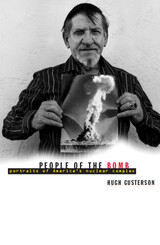 People Of The Bomb: Portraits of America’s Nuclear Complex
Hugh Gusterson
University of Minnesota Press, 2004 How the American military-industrial complex has invaded our consciousness to create consent for its programs “We have had the bomb on our minds since 1945. It was first our weaponry and then our diplomacy, and now it’s our economy. How can we suppose that something so monstrously powerful would not, after forty years, compose our identity?” —E. L. Doctorow This book tells the story of how—like it or not, know it or not—we have become “the people of the bomb.” Integrating fifteen years of field research at weapons laboratories across the United States with discussion of popular movies, political speeches, media coverage of war, and the arcane literature of defense intellectuals, Hugh Gusterson shows how the military-industrial complex has built consent for its programs and, in the process, taken the public “nuclear.” People of the Bomb mixes empathic and vivid portraits of individual weapons scientists with hard-hitting scrutiny of defense intellectuals’s inability to foresee the end of the Cold War, government rhetoric on missile defense, official double standards about nuclear proliferation, and pork barrel politics in the nuclear weapons complex. Overall, the book assembles a disturbing picture of the ways in which the military-industrial complex has transformed our public culture and personal psychology in the half century since we entered the nuclear age.
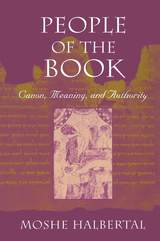 People of the Book: Canon, Meaning, and Authority
Moshe Halbertal
Harvard University Press, 1997 While Scripture is at the center of many religions, among them Islam and Christianity, this book inquires into the function, development, and implications of the centrality of text upon the Jewish community, and by extension on the larger question of canonization and the text-centered community. It is a commonplace to note how the landless and scattered Jewish communities have, from the time of the destruction of the Temple in Jerusalem in 70 A.D. until the founding of modern Israel in 1948, cleaved to the text and derived their identity from it. But the story is far more complex. The shift from the Bible to the Torah, from biblical religion to rabbinic Judaism mediated by the Sages, and the sealing of the canon together with its continuing interpretive work demanded from the community, amount to what could be called an unparalleled obsession with textuality. Halbertal gives us insights into the history of this obsession, in a philosophically sophisticated yet straightforward narrative.
People of the Book offers the best introduction available to Jewish hermeneutics, a book capable of conveying the importance of the tradition to a wide audience of both academic and general readers. Halbertal provides a panoramic survey of Jewish attitudes toward Scripture, provocatively organized around problems of normative and formative authority, with an emphasis on the changing status and functions of Mishnah, Talmud, and Kabbalah. With a gift for weaving complex issues of interpretation into his own plot, he animates ancient texts by assigning them roles in his own highly persuasive narrative.
|
|
